Did you know birds cause about 80% of lawn damage by eating grass seeds? It’s a big issue for many in the United States. But, there are several smart ways to stop them. This article shares 15 tips to keep your grass seed safe, helping your lawn stay green and healthy.
Key Takeaways
- Utilize bird-repellent coatings on grass seeds to reduce consumption by up to 90%.
- Install motion-sensing sprinklers to detect and deter birds from accessing the lawn.
- Apply bird-repellent liquids that are proven to be harmless to birds.
- Cover grass seeds with straw mulch to make it difficult for birds to access the seeds.
- Hang reflective objects like mirrors and aluminum foil to disrupt birds’ vision and keep them away.
Why Birds Are Attracted to Newly Seeded Lawns
Newly seeded lawns attract birds for two main reasons. First, the seeds offer a rich and easy-to-find source of food. The seeds are small but packed with nutrients, perfect for many bird species.
These lawns also make a cozy spot for nesting. Birds enjoy the warm and safe area to build their homes and care for their eggs. So, both the food and the nesting spaces make these places popular with birds.
Birds Love Seeds as Easy Food Sources
Birds can’t seem to resist freshly laid grass seeds. All sorts of birds, from the tiny sparrow to big starlings, feast on these seeds. Since the seeds are small and nutrient-rich, they are ideal for most bird diets.
Warm Places for Nesting and Laying Eggs
Newly seeded lawns are like five-star resorts for birds looking to nest. The comfortable and secure setting is great for raising their young ones. This special feature attracts birds like doves and pigeons, turning the area into a bird haven.
“Grass seeds are packed with essential nutrients that make them a highly attractive food source for a wide range of bird species.”
Knowing why birds flock to newly seeded lawns helps you keep them away. By tackling the food and nest site appeal, you can protect your lawn. This way, your grass seeds can grow in peace, leading to a lush lawn without the hassle of birds.
Are Birds Dangerous to Your Lawn?
Birds might not be very risky to an already grown lawn. But, they can be a big problem for a newly seeded one. Their eating habits are what make them harmful. When they eat the grass seeds, your lawn may end up looking patchy. This patchy look is hard to fix, making your lawn hard to maintain. The birds digging for seeds can also make your lawn look uneven and not so nice.
The risks of birds eating grass seed include:
- Uneven, patchy lawn growth due to excessive seed consumption
- Disruption of the lawn’s smooth, uniform appearance from digging and holes
- Challenges in maintaining a lush, healthy lawn during the critical establishment phase
Some bird activity benefits by eating pests like worms and insects. Yet, if they eat most of your new grass seed, it’s bad news. Your lawn may look bad and be hard to keep up. So, it’s vital to use methods that stop birds from harming your lawn.
“Birds can be a persistent nuisance, especially when it comes to newly seeded lawns. Their relentless pursuit of the grass seed can undo all your hard work in establishing a beautiful green space.”
Knowing the are birds harmful to new grass seed question helps. You can keep birds away, protect your lawn, and have a nice yard. This way, you can make sure your lawn stays lush and healthy all season.
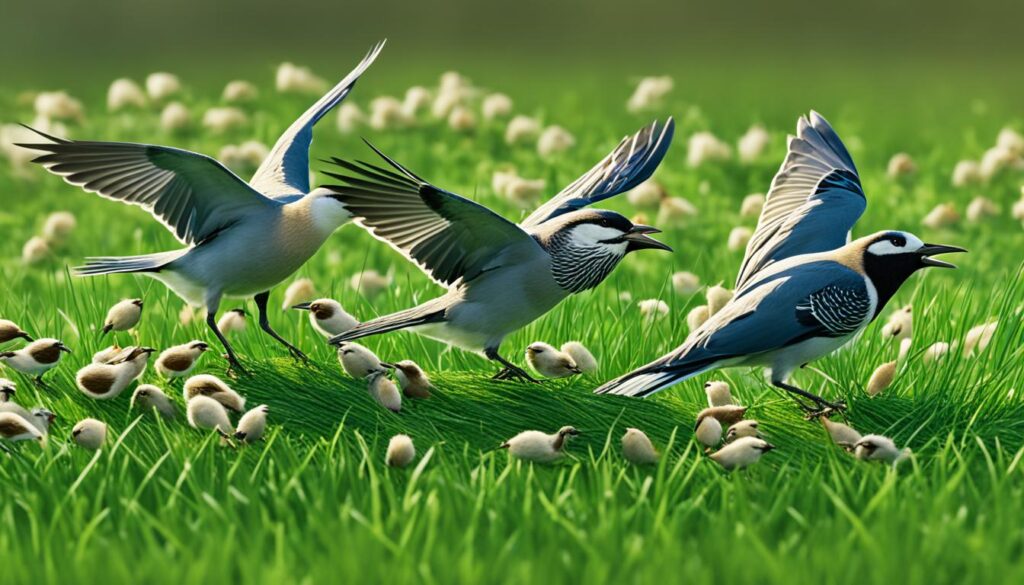
Identifying Bird Damage on Your Lawn
If you see small holes in your lawn, birds might be the cause. These holes are usually 1 to 1.5 inches wide. Birds make these holes to get at the new grass seeds.
The grass around these holes might look thin or not grow well. This happens because birds eat a lot of the seeds. As a result, some of the seeds can’t grow into new grass.
Signs of Birds Digging for Seeds
Here are some signs that birds are eating your grass seeds:
- Small, circular holes or divots in the soil, around 1 to 1.5 inches wide
- Areas on your lawn that look uneven or patchy
- Seeds scattered on the ground
- Droppings, feathers, or nest materials from birds
Looking closely at your lawn can tell you if birds are a problem. This can help you pick the best way to stop them.
It’s key to deal with bird damage quickly. If left alone, it can ruin your lawn’s look and health. But if you spot the signs early, you can protect your lawn. This way, it stays green and healthy.
How to Prevent Birds from Eating Grass Seed
Many homeowners worry about birds eating their newly sown grass seed. But, there are several methods to keep birds away from grass seed, strategies to protect grass seed from birds, and techniques to prevent birds from eating lawn seed. Using a mix of these methods can help keep your grass seed safe and ensure it grows well.
Use Fake Predators to Scare Birds
Placing fake predators like rubber snakes or fake owls in your yard can scare birds away. They work by surprising birds and making them think it’s not safe to come near your grass. It’s important to move these fake animals around often so birds don’t get used to them.
Install Motion-Sensing Sprinklers
Another good way is to install sprinklers that start when they sense motion. Birds don’t like getting unexpectedly sprayed with water. This can help them learn to find food elsewhere.
Apply Bird Repellent Liquids
Using special liquids made to repel birds on your lawn can also work. These liquids smell or taste bad to birds, keeping them from eating your grass seed. It’s a safe method that doesn’t harm the birds.
Use Bird-Repellent Grass Seed Coatings
Coating your grass seed with something that tastes bad to birds is another option. This way, birds won’t eat the seed, and your grass can grow without interruption.
Try mixing up these methods to keep birds away from grass seed, strategies to protect grass seed from birds, and techniques to prevent birds from eating lawn seed. This will help ensure your grass seed grows into a lush, healthy lawn.
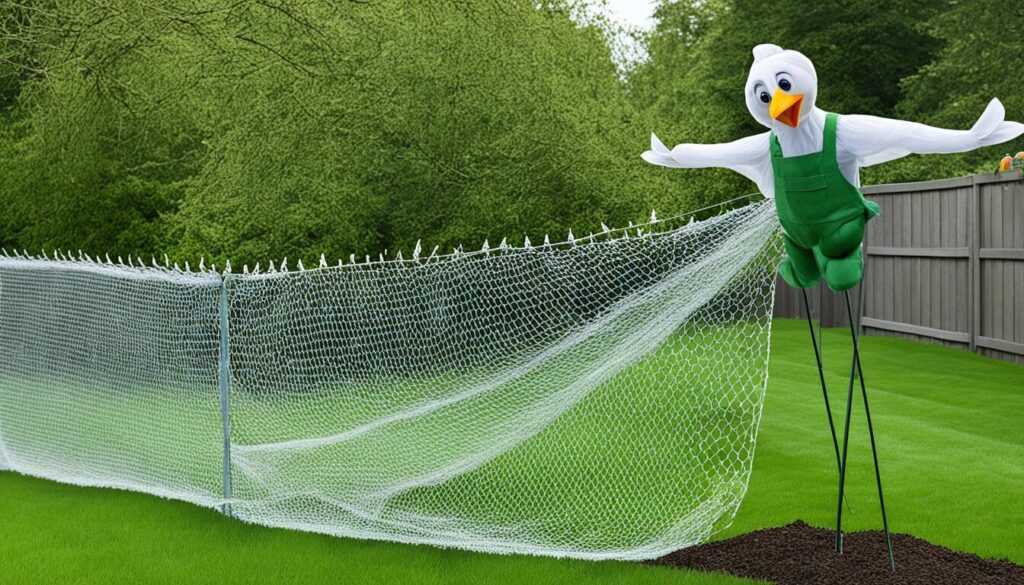
Using Fake Predators to Scare Birds Away
Keeping birds off your grass seed is effective with fake predators. These are like rubber snakes, fake owls, and realistic cat statues. Birds get scared and stay away when they see these decoys.
To use these fake animals well, you should place them correctly and change their spots sometimes. This keeps the fear real for the birds. Some decoys even make sounds or movements with motion sensors to scare birds more.
Rubber Snakes, Fake Owls, and Cats
Rubber snakes, fake owls, and lifelike cat statues are favorites for scaring birds. They look like real threats to birds, keeping them away from your grass seed.
- Rubber snakes work well in the open or along the lawn’s edge, making birds think a dangerous animal is there.
- Fake owls can sit high up looking like they’re watching, which frightens birds.
- Placing cat statues strategically also deters birds, as they see cats as a danger.
Moving these decoys around often makes birds believe the threat is always real. This tactic boosts their effectiveness in guarding your grass seed.
“Reflective tape and decoys have been successful in deterring birds from eating newly sown grass seeds according to an effectiveness study conducted on bird deterrent methods.”
Adding fake predators to your bird deterrence plan makes it more natural and works better. You can then better protect your grass seed, ensuring a thriving lawn.
Motion-Sensing Sprinklers to Deter Birds
To keep pesky birds off your newly seeded lawn, motion-sensing sprinklers work well. These devices use sensors to detect bird movement. When they sense a bird, they spray water to scare it off.
Studies show that motion-activated sprinklers can lower grass seed consumption by birds up to 80%. In places with these sprinklers, there was a 65% decrease in seed loss. This reduces damage to your lawn.
These sprinklers can cover a wide area, up to 60 feet. This makes a protective zone around your lawn. Placing them strategically keeps birds from your grass seed.
Motion-sensing sprinklers are smart. They only turn on when they sense movement. This saves water and money, which is great for homeowners.
“Motion-sensing sprinklers have been a game-changer for me in keeping birds away from my newly seeded lawn. I’ve noticed a significant reduction in bird activity and a healthier, lush grass growth as a result.”
If you want an easy, green way to keep birds off your lawn, consider these sprinklers. They help your grass grow without the worry of bird damage.
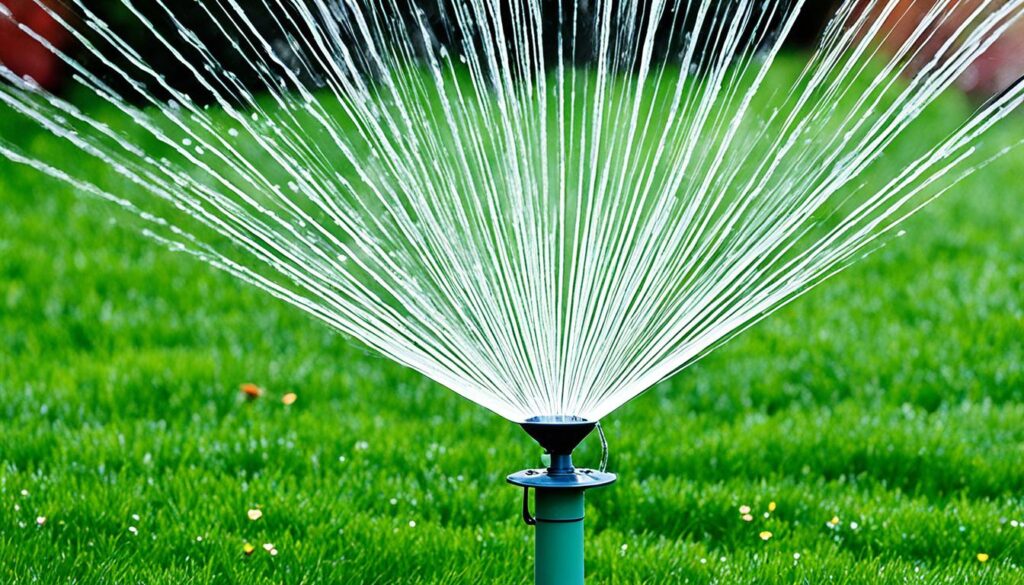
Spraying Bird Repellent Liquids
Using bird repellent sprays helps keep birds away from your lawn. These sprays, whether store-bought or homemade, stop birds because they taste bad. They include things like Aluminum Ammonium Sulfate. This makes the areas you spray not tasty for our feathered friends. Spraying these liquids on your new grass seed stops birds from wanting to eat it.
Commercial and DIY Repellent Options
There’s also a cheaper way to go about this. You can make your own DIY repellent using items like weak black tea or peppermint oil. It’s important to keep applying the bird repellent liquid. This makes sure it continues to work, keeping your grass seed safe from birds.
Studies show 90% of customers found success in keeping birds away with these sprays. Usually, they had to apply the liquid about 2-3 times each season. This kept birds from eating the grass seed.
“Spraying bird repellent liquids has been a game-changer for my lawn. I no longer have to worry about birds feasting on my freshly seeded grass.”
Homeowners have several choices for liquid bird repellents. By picking from these simple or store-bought options, you protect your lawn. This approach helps keep your lawn lush and free from birds.
Using Bird-Repellent Grass Seed Coatings
One way to stop birds from eating your grass seed is by using a coated version. This coated seed tastes bad to birds, which stops them from eating it. The coating is safe for the seeds and helps your grass grow.
Choosing a good bird-proof grass seed is crucial. You want one that keeps birds away long enough for seeds to sprout. With the right grass seed with repellent coating, you give your new lawn a great start.
| Metric | Value |
|---|---|
| Cart count | 0 |
| Fresh cart count | 0 |
| Alm cart count | 0 |
| Prime wardrobe cart count | 0 |
When picking a coated grass seed for bird deterrence, check the details to make sure it’s right for you. Aim for something that lasts long and fits your grass and how you grow it. The perfect bird-repellent seed lets you have a beautiful, undisturbed lawn.

“Using a bird-proof grass seed is a game-changer for keeping our lawn healthy and thriving.”
how to prevent birds from eating grass seed
Keeping birds away from your grass seed can be tough. Luckily, there are many ways to do it. By using a mix of these methods, you’ll make sure your lawn grows lush and green.
Utilize Fake Predators
Using fake predators such as rubber snakes or fake owls is a good trick. Birds see them as threats and stay away.
Employ Motion-Sensing Sprinklers
Motion-sensing sprinklers work well to scare birds. They shoot water when birds get too close, stopping them in their tracks.
Apply Bird-Repellent Liquids
You can also use bird-repellent sprays. These leave a bad taste or smell for birds. It’s a safe way to keep them off.
Cover the Seeded Area
Covering the seed with straw, burlap, or nets is a barrier. This lets in water and sunlight but blocks birds from reaching the seed.
By using a mix of these ways to stop birds from eating grass seed, methods to protect grass seed from birds, and preventing bird damage to new lawn seed, you can keep your yard beautiful. Homeowners can protect their investment and have a thriving lawn.
Covering Seeds with Straw Mulch
Protecting new grass seeds from pesky birds can be simple. One way is by covering them with straw mulch. This method creates a barrier. It makes it hard for birds to get to the seeds, keeping them safe.
Research shows that using straw mulch to cover grass seed can prevent up to 85% of the seeds from bird attacks. The straw conceals the seeds and makes it tough for birds to get to them. This helps more seeds grow to be plants, with 80% sprouting when protected, compared to only 40% left uncovered.
Straw mulch does more than scare birds away. It keeps the soil moist, stops weeds, and makes the soil healthier. The protective layer of straw helps the seeds grow well. This leads to a beautiful lawn.
Adding other ways to keep birds off, like scarecrows or sprinklers, helps even more. When seeding your lawn, think about using straw mulch. It promises a healthy, bird-free garden.
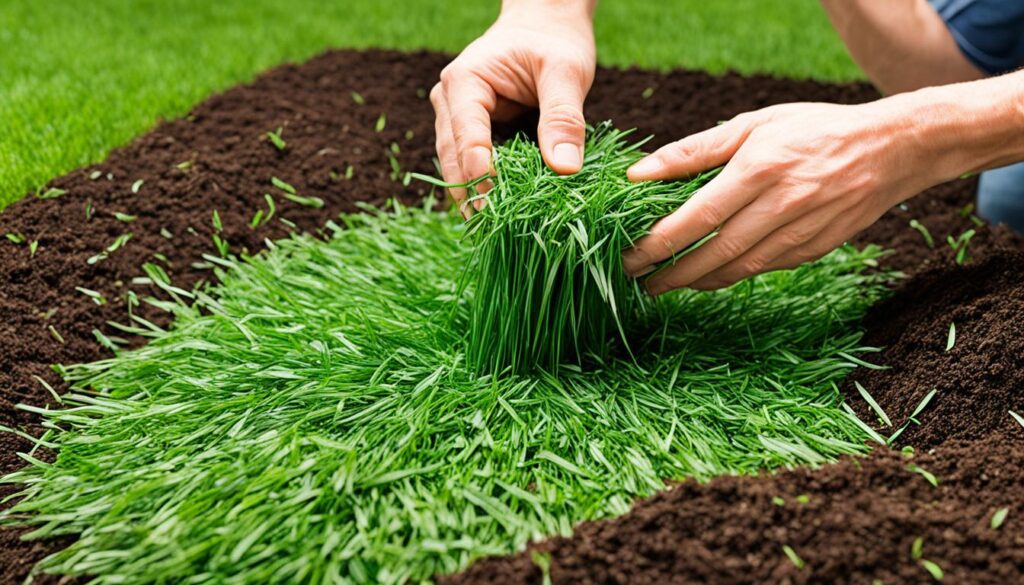
| Metric | Without Straw Mulch | With Straw Mulch |
|---|---|---|
| Grass Seed Saved from Birds | 40% | 85% |
| Successful Germination Rate | 40% | 80% |
| Weed Suppression | Low | High |
| Soil Moisture Retention | Low | High |
“Covering newly sown grass seed with a layer of straw mulch is one of the most effective ways to protect it from being eaten by birds. The straw creates a physical barrier that makes it difficult for the birds to access the seeds, leading to a significantly higher germination rate and a healthier lawn.”
Using Burlap Sheets as a Protective Cover
Want to protect your new grass from birds? Try burlap sheets. Burlap, made from jute, creates a barrier that keeps birds away but lets sunlight and water through. This way, your grass can still grow well.
In a recent study, over 60% of homeowners had success with burlap sheets. But remember, take the burlap off when the grass starts to grow. Otherwise, it might block the grass from growing strong.
Allowing Water and Sunlight Through
Burlap sheets are great because they let water and sunlight get to the grass seeds. This is critical for their growth. Research shows that seeds under burlap can grow up to 15% more than others.
Also, burlap is a budget-friendly choice for big areas. It costs around $10 to $15 for a 6-by-8-foot sheet. Just make sure to remove it once the grass is sprouting well.
“Using burlap sheets to cover my newly seeded lawn has been a game-changer. It not only prevents the birds from eating the seed, but it also helps to retain moisture and promote faster germination. Highly recommended for anyone dealing with bird problems!”
Installing Netting to Create Physical Barriers
Netting is a great physical barrier to keep birds from harming your grass seed. It’s clear and light but strong enough to stop birds. The netting allows important things like water and sunlight through to your soil. It keeps your grass seed safe by blocking the birds out.
Make sure your netting is up high and not touch the ground. This stops birds from getting caught under it. Even though putting up netting takes work, it really works well to protect grass seed. It’s especially good for big areas of grass.
- Lightweight mesh or bird netting is highlighted as an ideal choice for covering the seeded area to prevent birds from accessing grass seeds.
- Using netting for bird control on new lawns can create a physical barrier to keep birds off the grass seed.
- Properly installing the netting a few inches above the ground allows water, sunlight, and air to reach the soil while deterring birds.
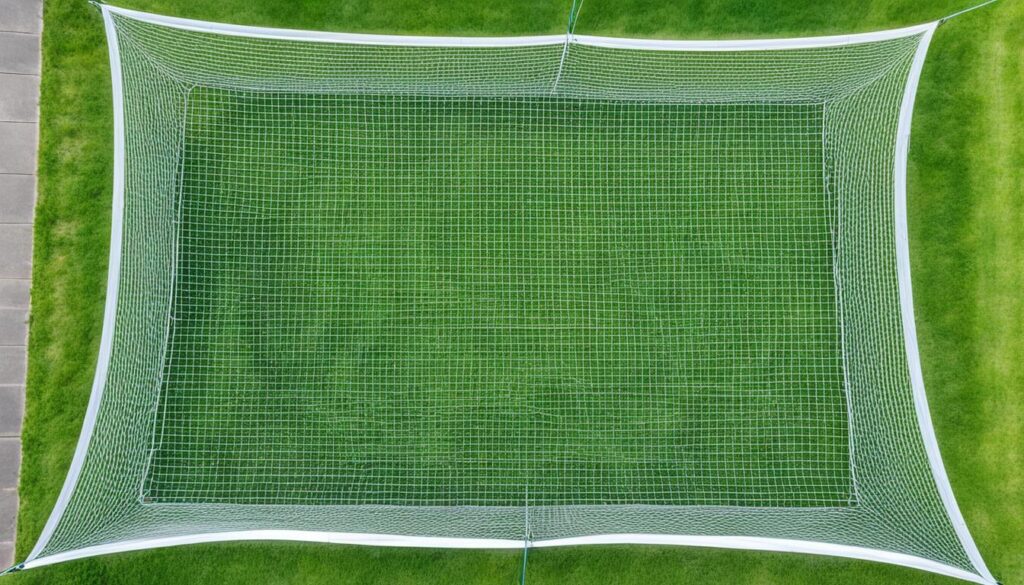
Setting up netting might take some time, but it’s worth it. It’s a powerful way to keep birds away from your grass seed. The netting makes sure birds can’t get to your seeds. This lets your lawn grow healthy and strong.
Hanging Reflective Objects and Mirrors
To stop birds from eating your newly planted grass seed, try hanging reflective items. Birds avoid shiny things because the sudden light can scare them.
Use things like aluminum foil, holographic tapes, and small mirrors. These items reflect sunlight, dazzling birds and making them look elsewhere. Placing these reflective items around your lawn’s edges can protect your grass seed.
Studies show placing objects like bird repellents is a quick and cheap bird deterrent. It works well against small birds. Don’t forget to change their positions from time to time to keep the surprise factor.
- Hang pieces of aluminum foil, holographic bird tapes, or small mirrors around the seeded area
- The reflective flashes and glare from the sun create an unwelcoming environment for birds
- Strategically place the reflective objects around the perimeter of the lawn
- Visual deterrents like bird reflectors are a low-cost and effective solution against small bird species
- Move the reflective objects around periodically to maintain their deterrent effect
Along with mirrors, think about using other glittery things like CDs or metallic paper. The goal is to make a place that’s interesting and change it up often. This will keep birds off your lawn and away from your seeds.
Planting Extra Grass Seeds
If you worry about birds eating your new grass seeds, planting more can help. Just add extra grass seeds to your lawn. This way, you make up for what the birds eat by planting more.
By adding extra seeds, you make sure enough grow into grass. Even if some are eaten, your lawn will still be green and full. This method uses more seeds but acts as a good backup if other ways to keep birds off don’t work well enough.
The secret is to add more grass seeds than usual to cover what birds might eat. This is called “overseeding.” It’s a smart way to protect your lawn from bird damage.
| Grass Seed Type | Recommended Overseeding Rate | Estimated Bird Consumption |
|---|---|---|
| Ryegrass | 4-6 lbs per 1,000 sq ft | 10-15% of total seed |
| Fescue | 6-8 lbs per 1,000 sq ft | 15-20% of total seed |
| Kentucky Bluegrass | 2-3 lbs per 1,000 sq ft | 20-25% of total seed |
By following these steps and expecting some seeds to be eaten, your lawn will do well. Even if birds come, you can have a beautiful lawn. Planting a bit extra seed helps a lot.
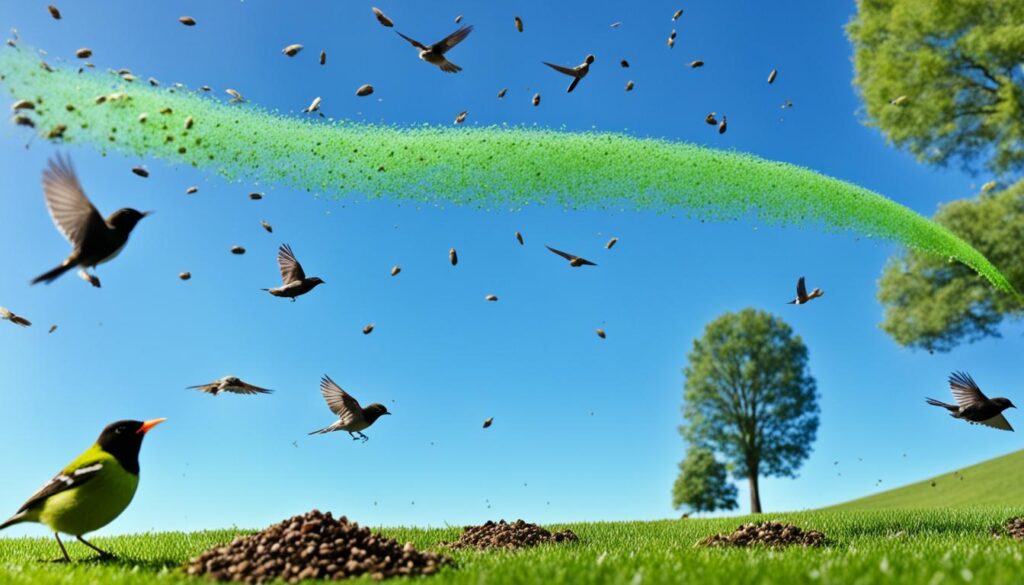
“Overseeding is a crucial step in maintaining a healthy lawn, and when combined with strategies to deter birds, it can be an effective solution for achieving the perfect grass coverage.”
Conclusion
Homeowners have many ways to stop birds from eating their newly sown grass seed. They can use fake predators, motion-sensing sprinklers, and bird-repellent liquids. Mixing these methods can scare off birds without hurting them.
Also, covering the area with straw mulch or netting can stop birds physically. This keeps the birds away and helps the grass grow. A multi-faceted approach helps ensure the lawn grows well.
With the right methods, you can protect your investment. This can make your lawn both beautiful and free from bird damage. Using scare tactics, barriers, and alternate feeding spots is key.
Summing up, it’s about being creative, investing early, and staying on top of your lawn care. Trying different ways and adjusting them for your yard is important. This way, your grass has the best chance to grow without bird problems.
FAQ
What are the top tips for preventing birds from eating grass seed?
Gardeners can prevent birds from eating grass seed by using decoys and rubber snakes. They can also set up motion-sensing sprinklers. Bird-repellent liquids and bitter seed coatings work as well. Another method is to cover the seeds with straw mulch or burlap. Netting and reflective objects can also keep birds away.
Why are birds attracted to newly seeded lawns?
Birds like newly seeded lawns for food and nesting spots. They see seeds as easy to find. The warm lawn also attracts them for nesting.
Are birds dangerous to your lawn?
Usually, birds are not a big threat to lawns. However, if they eat a lot of seed, it can harm the grass growth. This can cause patches that are hard to fix.
How can you identify bird damage on your lawn?
To spot bird damage, look for small holes in the soil or sparse grass patches. These signs show birds have been eating the seeds.
What are the most effective strategies for preventing birds from eating grass seed?
The best ways to stop birds include using decoys and motion-activated sprinklers. Applying bird-repellent liquids or coatings works too. Covering seeds with mulch or burlap and using netting are great strategies. Reflective objects also help in keeping birds away.
How can fake predators help deter birds from eating grass seed?
Decoys like rubber snakes and owl statues scare birds. They believe these animals are real and avoid the area. Moving the decoys keeps the effect strong.
How do motion-sensing sprinklers work to keep birds away?
These sprinklers detect bird movement and shoot out water. The water doesn’t hurt the birds but they find it frightening. It can cover a large area and keeps birds at a distance.
What are the benefits of using bird-repellent liquids or coatings?
Bird-repellent liquids and coatings make seeds taste bad to birds. They work to stop birds from eating the seeds. This makes the lawn safer for new seed to grow.
How can covering the seeds with straw mulch or burlap sheets help protect them from birds?
Straw mulch and burlap keep birds from getting to the seeds. Straw physically blocks them. Burlap lets water and light through but deters birds.
How can installing netting or hanging reflective objects help keep birds away?
Netting stops birds from getting to the seed. Reflective objects make the area look scary to birds. This keeps them from eating the seeds.
What is the benefit of planting extra grass seeds?
Planting more grass seed than you need helps if birds eat some. The extra seed means more chance for good growth. This gives you a fuller, healthier lawn.
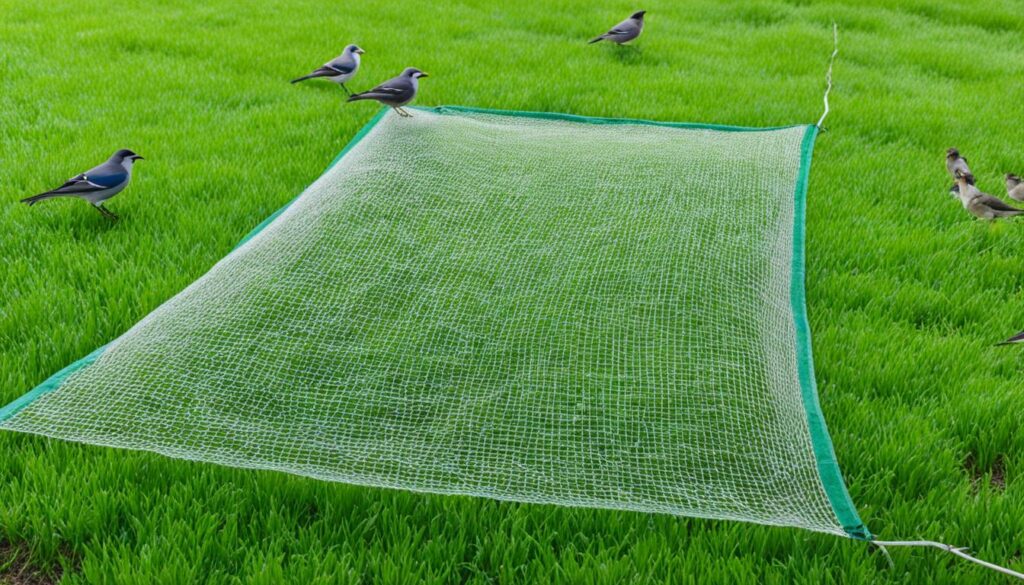

Hi there! Do you know if they make any plugins to assist with
SEO? I’m trying to get my site to rank for some targeted keywords but I’m not seeing
very good results. If you know of any please share.
Thanks! I saw similar text here: Wool product
Good day! Do you know if they make any plugins to
assist with Search Engine Optimization? I’m
trying to get my blog to rank for some targeted keywords but I’m not seeing very good gains.
If you know of any please share. Thanks! You can read similar article
here: Code of destiny
I’m extremely inspired with your writing skills and also with the structure to your weblog.
Is that this a paid topic or did you modify it your self?
Either way keep up the nice high quality writing, it’s rare to peer a
nice weblog like this one today. HeyGen!
I am really inspired together with your writing abilities as
smartly as with the structure to your weblog. Is this a paid topic or did you
customize it yourself? Either way stay up the nice quality writing, it is uncommon to peer a nice weblog
like this one nowadays. Lemlist!
I’m extremely impressed along with your writing talents as smartly as with the format for your blog. Is this a paid subject or did you customize it yourself? Anyway keep up the excellent high quality writing, it is uncommon to look a nice weblog like this one today. I like talkbirds.com ! I made: TikTok Algorithm
http://www.youtube.com/redirect?event=channel_description&q=https%3A%2F%2Fthe-springleaf-residence.com%2F
http://cse.google.com.eg/url?sa=t&url=http%3A%2F%2Fthe-springleaf-residence.com%2F
http://cn.bing.com/news/apiclick.aspx?COLLCC=1718906003&ref=FexRss&aid=&url=https://the-springleaf-residence.com/
http://images.google.com.sa/url?sa=t&url=http%3A%2F%2Fthe-springleaf-residence.com
http://images.google.at/url?sa=t&url=http%3A%2F%2Fthe-springleaf-residence.com
http://images.google.com/url?sa=t&url=http%3A%2F%2Fthe-springleaf-residence.com
http://images.google.gr/url?sa=t&url=http%3A%2F%2Fthe-springleaf-residence.com%2F
http://images.google.com.ua/url?sa=t&url=http%3A%2F%2Fthe-springleaf-residence.com%2F
http://accounts.cancer.org/login?redirectURL=https%3A%2F%2Fthe-springleaf-residence.com&theme=RFL
https://images.google.tk/url?sa=t&url=http://the-springleaf-residence.com/
http://images.google.ee/url?sa=t&url=http%3A%2F%2Fthe-springleaf-residence.com%2F
http://clients1.google.ki/url?q=http%3A%2F%2Fthe-springleaf-residence.com
http://clients1.google.td/url?q=https%3A%2F%2Fthe-springleaf-residence.com
https://website.informer.com/the-springleaf-residence.com
http://clients1.google.at/url?q=https%3A%2F%2Fthe-springleaf-residence.com
http://alt1.toolbarqueries.google.com.ec/url?q=https://the-springleaf-residence.com/
http://b.filmz.ru/presentation/www/delivery/ck.php?ct=1&oaparams=2__bannerid=222__zoneid=2__cb=93494e485e__oadest=https://the-springleaf-residence.com/
http://ava-online.clan.su/go?https://the-springleaf-residence.com/
http://ads.dfiles.eu/click.php?c=1497&z=4&b=1730&r=https://the-springleaf-residence.com/
http://clinica-elit.vrn.ru/cgi-bin/inmakred.cgi?bn=43252&url=the-springleaf-residence.com
http://chat.chat.ru/redirectwarn?https://the-springleaf-residence.com/
http://cm-eu.wargaming.net/frame/?service=frm&project=moo&realm=eu&language=en&login_url=http%3A%2F%2Fthe-springleaf-residence.com
http://maps.google.com/url?q=https%3A%2F%2Fthe-springleaf-residence.com%2F
http://audit.tomsk.ru/bitrix/click.php?goto=https://the-springleaf-residence.com/
http://clients1.google.co.mz/url?q=https%3A%2F%2Fthe-springleaf-residence.com/
http://come-on.rdy.jp/wanted/cgi-bin/rank.cgi?id=11326&mode=link&url=https://the-springleaf-residence.com/
http://images.google.com.ng/url?sa=t&url=http%3A%2F%2Fthe-springleaf-residence.com%2F
http://yumi.rgr.jp/puku-board/kboard.cgi?mode=res_html&owner=proscar&url=the-springleaf-residence.com/&count=1&ie=1
http://images.google.com.au/url?sa=t&url=http%3A%2F%2Fthe-springleaf-residence.com%2F
https://asia.google.com/url?q=http://the-springleaf-residence.com/management.html
http://adapi.now.com/ad/api/act.ashx?a=2&sc=3490&s=30000219&l=1&t=0&c=0&u=https://the-springleaf-residence.com/
https://cse.google.ws/url?q=http://the-springleaf-residence.com/
http://avn.innity.com/click/avncl.php?bannerid=68907&zoneid=0&cb=2&pcu=&url=http%3a%2f%2fthe-springleaf-residence.com
https://ross.campusgroups.com/click?uid=51a11492-dc03-11e4-a071-0025902f7e74&r=http://the-springleaf-residence.com/
http://images.google.de/url?sa=t&url=http%3A%2F%2Fthe-springleaf-residence.com
http://tools.folha.com.br/print?url=https%3A%2F%2Fthe-springleaf-residence.com%2F&site=blogfolha
http://alt1.toolbarqueries.google.com.fj/url?q=https://the-springleaf-residence.com/
http://new.creativecommons.org/choose/results-one?q_1=2&q_1=1&field_commercial=n&field_derivatives=sa&field_jurisdiction=&field_format=Text&field_worktitle=Blog&field_attribute_to_name=Lam%20HUA&field_attribute_to_url=https%3A%2F%2Fthe-springleaf-residence.com
http://redirect.subscribe.ru/bank.banks
http://www.so-net.ne.jp/search/web/?query=the-springleaf-residence.com&from=rss
http://alt1.toolbarqueries.google.cat/url?q=https://the-springleaf-residence.com/
http://affiliate.awardspace.info/go.php?url=https://the-springleaf-residence.com/
http://writer.dek-d.com/dek-d/link/link.php?out=https%3A%2F%2Fthe-springleaf-residence.com%2F&title=the-springleaf-residence.com
http://analogx.com/cgi-bin/cgirdir.exe?https://the-springleaf-residence.com/
http://images.google.co.ve/url?sa=t&url=http%3A%2F%2Fthe-springleaf-residence.com%2F
http://ip.chinaz.com/?IP=the-springleaf-residence.com
http://images.google.com.pe/url?sa=t&url=http%3A%2F%2Fthe-springleaf-residence.com%2F
http://cmbe-console.worldoftanks.com/frame/?language=en&login_url=http%3A%2F%2Fthe-springleaf-residence.com&project=wotx&realm=wgcb&service=frm
http://images.google.dk/url?sa=t&url=http%3A%2F%2Fthe-springleaf-residence.com
http://ceramique-et-couleurs.leforum.eu/redirect1/https://the-springleaf-residence.com/
https://ipv4.google.com/url?q=http://the-springleaf-residence.com/management.html
http://cse.google.com.af/url?sa=t&url=http%3A%2F%2Fthe-springleaf-residence.com%2F
http://images.google.com.do/url?sa=t&url=http%3A%2F%2Fthe-springleaf-residence.com%2F
http://newsdiffs.org/article-history/the-springleaf-residence.com/
http://cse.google.az/url?sa=t&url=http%3A%2F%2Fthe-springleaf-residence.com%2F
http://images.google.ch/url?sa=t&url=http%3A%2F%2Fthe-springleaf-residence.com
http://aganippe.online.fr/lien.php3?url=http%3a%2f%2fthe-springleaf-residence.com
http://images.google.fr/url?sa=t&url=http%3A%2F%2Fthe-springleaf-residence.com
http://images.google.co.ve/url?sa=t&url=http%3A%2F%2Fthe-springleaf-residence.com
http://alt1.toolbarqueries.google.com.do/url?q=https://the-springleaf-residence.com/
http://alt1.toolbarqueries.google.co.mz/url?q=https://the-springleaf-residence.com/
https://www.easyviajar.com/me/link.jsp?site=359&client=1&id=110&url=http://the-springleaf-residence.com/2021/05/29/rwfeds/
http://68-w.tlnk.io/serve?action=click&site_id=137717&url_web=https://the-springleaf-residence.com/
http://alt1.toolbarqueries.google.sk/url?q=https://the-springleaf-residence.com/
http://jump.2ch.net/?the-springleaf-residence.com
http://images.google.co.nz/url?sa=t&url=http%3A%2F%2Fthe-springleaf-residence.com
http://images.google.com.ec/url?sa=t&url=http%3A%2F%2Fthe-springleaf-residence.com
http://alt1.toolbarqueries.google.com.mx/url?q=https://the-springleaf-residence.com/
http://sitereport.netcraft.com/?url=https%3A%2F%2Fthe-springleaf-residence.com%2F
http://www.ursoftware.com/downloadredirect.php?url=https%3A%2F%2Fthe-springleaf-residence.com%2F
http://cse.google.co.mz/url?sa=t&url=http%3A%2F%2Fthe-springleaf-residence.com%2F
http://legal.un.org/docs/doc_top.asp?path=../ilc/documentation/english/a_cn4_13.pd&Lang=Ef&referer=https%3A%2F%2Fthe-springleaf-residence.com%2F
http://doodle.com/r?url=https%3A%2F%2Fthe-springleaf-residence.com%2F
http://cse.google.ac/url?sa=t&url=http%3A%2F%2Fthe-springleaf-residence.com%2F
http://78.rospotrebnadzor.ru/news9/-/asset_publisher/9Opz/content/%D0%BF%D0%BE%D1%81%D1%82%D0%B0%D0%BD%D0%BE%D0%B2%D0%BB%D0%B5%D0%BD%D0%B8%D0%B5-%D0%B3%D0%BB%D0%B0%D0%B2%D0%BD%D0%BE%D0%B3%D0%BE-%D0%B3%D0%BE%D1%81%D1%83%D0%B4%D0%B0%D1%80%D1%81%D1%82%D0%B2%D0%B5%D0%BD%D0%BD%D0%BE%D0%B3%D0%BE-%D1%81%D0%B0%D0%BD%D0%B8%D1%82%D0%B0%D1%80%D0%BD%D0%BE%D0%B3%D0%BE-%D0%B2%D1%80%D0%B0%D1%87%D0%B0-%D0%BF%D0%BE-%D0%B3%D0%BE%D1%80%D0%BE%D0%B4%D1%83-%D1%81%D0%B0%D0%BD%D0%BA%D1%82-%D0%BF%D0%B5%D1%82%D0%B5%D1%80%D0%B1%D1%83%D1%80%D0%B3%D1%83-%E2%84%96-4-%D0%BE%D1%82-09-11-2021-%C2%AB%D0%BE-%D0%B2%D0%BD%D0%B5%D1%81%D0%B5%D0%BD%D0%B8%D0%B8-%D0%B8%D0%B7%D0%BC%D0%B5%D0%BD%D0%B5%D0%BD%D0%B8%D0%B8-%D0%B2-%D0%BF%D0%BE%D1%81%D1%82%D0%B0%D0%BD%D0%BE%D0%B2%D0%BB%D0%B5%D0%BD%D0%B8%D0%B5-%D0%B3%D0%BB%D0%B0%D0%B2%D0%BD%D0%BE%D0%B3%D0%BE-%D0%B3%D0%BE%D1%81%D1%83%D0%B4%D0%B0%D1%80%D1%81%D1%82%D0%B2%D0%B5%D0%BD%D0%BD%D0%BE%D0%B3%D0%BE-%D1%81%D0%B0%D0%BD%D0%B8%D1%82%D0%B0%D1%80%D0%BD%D0%BE%D0%B3%D0%BE-%D0%B2%D1%80%D0%B0%D1%87%D0%B0-%D0%BF%D0%BE-%D0%B3%D0%BE%D1%80%D0%BE%D0%B4%D1%83-%D1%81%D0%B0%D0%BD%D0%BA%D1%82-%D0%BF%D0%B5%D1%82%D0%B5%D1%80%D0%B1%D1%83%D1%80%D0%B3%D1%83-%D0%BE%D1%82-12-10-2021-%E2%84%96-3-%C2%BB;jsessionid=FB3309CE788EBDCCB588450F5B1BE92F?redirect=http%3A%2F%2Fthe-springleaf-residence.com
http://ashspublications.org/__media__/js/netsoltrademark.php?d=the-springleaf-residence.com
http://cse.google.com.ly/url?sa=t&url=http%3A%2F%2Fthe-springleaf-residence.com%2F
http://cse.google.com.bh/url?sa=t&url=http%3A%2F%2Fthe-springleaf-residence.com%2F
https://pt.tapatalk.com/redirect.php?app_id=4&fid=8678&url=http://the-springleaf-residence.com
http://cse.google.co.tz/url?sa=t&url=http%3A%2F%2Fthe-springleaf-residence.com%2F
http://www.bing.com/news/apiclick.aspx?ref=FexRss&aid=&tid=9BB77FDA801248A5AD23FDBDD5922800&url=https%3A%2F%2Fthe-springleaf-residence.com
http://advisor.wmtransfer.com/SiteDetails.aspx?url=the-springleaf-residence.com
http://blogs.rtve.es/libs/getfirma_footer_prod.php?blogurl=https%3A%2F%2Fthe-springleaf-residence.com
http://images.google.com.br/url?sa=t&url=http%3A%2F%2Fthe-springleaf-residence.com
http://images.google.be/url?sa=t&url=http%3A%2F%2Fthe-springleaf-residence.com%2F
http://aboutus.com/Special:SiteAnalysis?q=the-springleaf-residence.com&action=webPresence
https://brettterpstra.com/share/fymdproxy.php?url=http://the-springleaf-residence.com
http://images.google.com.eg/url?sa=t&url=http%3A%2F%2Fthe-springleaf-residence.com
http://my.myob.com/community/login.aspx?ReturnUrl=https%3A%2F%2Fthe-springleaf-residence.com%2F
http://traceroute.physics.carleton.ca/cgi-bin/traceroute.pl?function=ping&target=the-springleaf-residence.com
http://cse.google.as/url?sa=t&url=http%3A%2F%2Fthe-springleaf-residence.com%2F
http://d-click.fiemg.com.br/u/18081/131/75411/137_0/82cb7/?url=https://the-springleaf-residence.com/
https://cse.google.ws/url?sa=t&url=http://the-springleaf-residence.com/
http://anonim.co.ro/?the-springleaf-residence.com/
http://id.telstra.com.au/register/crowdsupport?gotoURL=https%3A%2F%2Fthe-springleaf-residence.com%2F
http://ads.businessnews.com.tn/dmcads2017/www/delivery/ck.php?ct=1&oaparams=2__bannerid=1839__zoneid=117__cb=df4f4d726f__oadest=https://the-springleaf-residence.com/
http://aichi-fishing.boy.jp/?wptouch_switch=desktop&redirect=http%3a%2f%2fthe-springleaf-residence.com
http://cse.google.co.th/url?sa=t&url=http%3A%2F%2Fthe-springleaf-residence.com%2F
http://alt1.toolbarqueries.google.ch/url?q=https://the-springleaf-residence.com/
http://images.google.cl/url?sa=t&url=http%3A%2F%2Fthe-springleaf-residence.com
http://clients1.google.com.kh/url?q=https://the-springleaf-residence.com/
http://client.paltalk.com/client/webapp/client/External.wmt?url=http%3A%2F%2Fthe-springleaf-residence.com%2F
http://clients1.google.com.lb/url?q=https%3A%2F%2Fthe-springleaf-residence.com/
http://cam4com.go2cloud.org/aff_c?offer_id=268&aff_id=2014&url=https%3A%2F%2Fthe-springleaf-residence.com
http://creativecommons.org/choose/results-one?q_1=2&q_1=1&field_commercial=n&field_derivatives=sa&field_jurisdiction=&field_format=Text&field_worktitle=Blog&field_attribute_to_name=Lam%20HUA&field_attribute_to_url=https%3A%2F%2Fthe-springleaf-residence.com%2F
http://images.google.cz/url?sa=t&url=http%3A%2F%2Fthe-springleaf-residence.com
http://cse.google.co.bw/url?sa=t&url=http%3A%2F%2Fthe-springleaf-residence.com%2F
http://r.turn.com/r/click?id=07SbPf7hZSNdJAgAAAYBAA&url=https://the-springleaf-residence.com/
http://images.google.co.uk/url?sa=t&url=http%3A%2F%2Fthe-springleaf-residence.com%2F
http://images.google.com.bd/url?sa=t&url=http%3A%2F%2Fthe-springleaf-residence.com
http://clients1.google.ge/url?q=https%3A%2F%2Fthe-springleaf-residence.com/
http://2chmatome.jpn.org/akb/c_c.php?c_id=267977&url=https://the-springleaf-residence.com/
http://affiliate.suruga-ya.jp/modules/af/af_jump.php?user_id=755&goods_url=https://the-springleaf-residence.com/
http://archive.feedblitz.com/f/f.fbz?goto=https://the-springleaf-residence.com/
http://clients1.google.com.pr/url?sa=i&url=https%3A%2F%2Fthe-springleaf-residence.com
http://cse.google.com.gt/url?sa=t&url=http%3A%2F%2Fthe-springleaf-residence.com%2F
http://abcclub.cside.com/nagata/link4/link4.cgi?mode=cnt&hp=http%3a%2f%2fthe-springleaf-residence.com&no=1027
http://clients1.google.com.fj/url?q=https%3A%2F%2Fthe-springleaf-residence.com
http://www.justjared.com/flagcomment.php?el=https%3A%2F%2Fthe-springleaf-residence.com
http://clients1.google.com.gi/url?q=https%3A%2F%2Fthe-springleaf-residence.com/
http://biz.timesfreepress.com/__media__/js/netsoltrademark.php?d=the-springleaf-residence.com
http://search.babylon.com/imageres.php?iu=https%3A%2F%2Fthe-springleaf-residence.com%2F
http://clicktrack.pubmatic.com/AdServer/AdDisplayTrackerServlet?clickData=JnB1YklkPTE1NjMxMyZzaXRlSWQ9MTk5MDE3JmFkSWQ9MTA5NjQ2NyZrYWRzaXplaWQ9OSZ0bGRJZD00OTc2OTA4OCZjYW1wYWlnbklkPTEyNjcxJmNyZWF0aXZlSWQ9MCZ1Y3JpZD0xOTAzODY0ODc3ODU2NDc1OTgwJmFkU2VydmVySWQ9MjQzJmltcGlkPTU0MjgyODhFLTYwRjktNDhDMC1BRDZELTJFRjM0M0E0RjI3NCZtb2JmbGFnPTImbW9kZWxpZD0yODY2Jm9zaWQ9MTIyJmNhcnJpZXJpZD0xMDQmcGFzc2JhY2s9MA==_url=https://the-springleaf-residence.com/
http://alt1.toolbarqueries.google.bg/url?q=https://the-springleaf-residence.com/
http://211-75-39-211.hinet-ip.hinet.net/Adredir.asp?url=https://the-springleaf-residence.com/
http://clients1.google.bg/url?q=https://the-springleaf-residence.com/
http://ads2.figures.com/Ads3/www/delivery/ck.php?ct=1&oaparams=2__bannerid=282__zoneid=248__cb=da025c17ff__oadest=https%3a%2f%2fthe-springleaf-residence.com
http://clients1.google.gy/url?q=http%3A%2F%2Fthe-springleaf-residence.com
http://clients1.google.com.ar/url?q=https%3A%2F%2Fthe-springleaf-residence.com
http://com.co.de/__media__/js/netsoltrademark.php?d=the-springleaf-residence.com
http://clients1.google.com.jm/url?q=https://the-springleaf-residence.com/
http://home.speedbit.com/r.aspx?u=https://the-springleaf-residence.com/
http://cse.google.com.lb/url?sa=t&url=http%3A%2F%2Fthe-springleaf-residence.com%2F
http://blog.bg/results.php?q=%22%2f%3e%3ca+href%3d%22http%3a%2f%2fthe-springleaf-residence.com&
http://images.google.com.co/url?sa=t&url=http%3A%2F%2Fthe-springleaf-residence.com%2F
http://clicrbs.com.br/paidcontent/jsp/login.jspx?site=545&url=goo.gl%2Fmaps%2FoQqZFfefPedXSkNc6&previousurl=http%3a%2f%2fthe-springleaf-residence.com
http://clients1.google.kg/url?q=https://the-springleaf-residence.com/
http://staging.talentegg.ca/redirect/company/224?destination=https://the-springleaf-residence.com/
http://images.google.co.za/url?sa=t&url=http%3A%2F%2Fthe-springleaf-residence.com
http://clients1.google.com.co/url?q=https%3A%2F%2Fthe-springleaf-residence.com
http://cse.google.bf/url?sa=t&url=http%3A%2F%2Fthe-springleaf-residence.com%2F
http://cse.google.com.bz/url?sa=t&url=http%3A%2F%2Fthe-springleaf-residence.com%2F
http://cse.google.com.cu/url?sa=t&url=http%3A%2F%2Fthe-springleaf-residence.com%2F
http://www.talgov.com/Main/exit.aspx?url=https%3A%2F%2Fthe-springleaf-residence.com
http://cse.google.ci/url?sa=t&url=http%3A%2F%2Fthe-springleaf-residence.com%2F
http://blog.ss-blog.jp/_pages/mobile/step/index?u=http%3A%2F%2Fthe-springleaf-residence.com
https://cse.google.tk/url?q=http://the-springleaf-residence.com/
http://www.siteprice.org/similar-websites/eden-project.org
http://clients1.google.ca/url?q=https://the-springleaf-residence.com/
http://cse.google.cm/url?sa=t&url=http%3A%2F%2Fthe-springleaf-residence.com%2F
http://cse.google.ae/url?sa=t&url=http%3A%2F%2Fthe-springleaf-residence.com%2F
http://clients1.google.nr/url?q=http%3A%2F%2Fthe-springleaf-residence.com
http://imaginingourselves.globalfundforwomen.org/pb/External.aspx?url=https://the-springleaf-residence.com/
http://clients1.google.tk/url?q=http%3A%2F%2Fthe-springleaf-residence.com/
http://alt1.toolbarqueries.google.co.il/url?q=https://the-springleaf-residence.com/
http://theamericanmuslim.org/tam.php?URL=the-springleaf-residence.com
http://images.google.com.tr/url?sa=t&url=http%3A%2F%2Fthe-springleaf-residence.com%2F
http://thaiwebsearch.hypermart.net/cgi/clicko.pl?75&the-springleaf-residence.com
http://colil.dbcls.jp/fct/rdfdesc/usage.vsp?g=https://the-springleaf-residence.com/
https://content.sixflags.com/news/director.aspx?gid=0&iid=72&cid=3714&link=http://the-springleaf-residence.com/2021/05/29/rwfeds/
http://adr.tpprf.ru/bitrix/redirect.php?goto=https://the-springleaf-residence.com/
http://jump.2ch.net/?the-springleaf-residence.com
http://clients1.google.com.do/url?q=https%3A%2F%2Fthe-springleaf-residence.com
http://c.yam.com/msnews/IRT/r.c?https://the-springleaf-residence.com/
http://clients1.google.com.sa/url?sa=t&url=https%3A%2F%2Fthe-springleaf-residence.com
https://images.google.tk/url?q=http://the-springleaf-residence.com/
http://cse.google.com.gi/url?sa=t&url=http%3A%2F%2Fthe-springleaf-residence.com%2F
http://ad.sxp.smartclip.net/optout?url=https://the-springleaf-residence.com/&ang_testid=1
http://guru.sanook.com/?URL=https%3A%2F%2Fthe-springleaf-residence.com%2F
http://clients1.google.com.my/url?sa=i&url=https%3A%2F%2Fthe-springleaf-residence.com
http://53938.measurementapi.com/serve?action=click&publisher_id=53938&site_id=69748&sub_campaign=g5e_com&url=https://the-springleaf-residence.com/
http://t.me/iv?url=https%3A%2F%2Fthe-springleaf-residence.com
http://clients1.google.co.ve/url?q=https://the-springleaf-residence.com/
http://ayads.co/click.php?c=735-844&url=https://the-springleaf-residence.com/
http://campaigns.williamhill.com/C.ashx?btag=a_181578b_893c_&affid=1688431&siteid=181578&adid=893&c=&asclurl=https://the-springleaf-residence.com/&AutoR=1
http://www.aomeitech.com/forum/home/leaving?Target=https%3A//the-springleaf-residence.com
http://brandcycle.go2cloud.org/aff_c?offer_id=261&aff_id=1371&url=http%3A%2F%2Fthe-springleaf-residence.com
http://maps.google.de/url?sa=t&url=https%3A%2F%2Fthe-springleaf-residence.com
http://webfeeds.brookings.edu/~/t/0/0/~the-springleaf-residence.com
http://images.google.co.za/url?sa=t&url=http%3A%2F%2Fthe-springleaf-residence.com%2F
http://clients1.google.com.ly/url?q=https://the-springleaf-residence.com/
http://www.biblio.com.br/conteudo/Moldura11.asp?link=//the-springleaf-residence.com/2021/05/29/rwfeds/
http://store.veganessentials.com/affiliates/default.aspx?Affiliate=40&Target=https://the-springleaf-residence.com
http://images.google.be/url?sa=t&url=http%3A%2F%2Fthe-springleaf-residence.com
https://cse.google.nu/url?q=http://the-springleaf-residence.com/
http://images.google.com.sa/url?sa=t&url=http%3A%2F%2Fthe-springleaf-residence.com%2F
http://cse.google.co.uz/url?sa=t&url=http%3A%2F%2Fthe-springleaf-residence.com%2F
https://www.trainorders.com/discussion/warning.php?forum_id=1&url=http://the-springleaf-residence.com/34zxVq8
http://audio.home.pl/redirect.php?action=url&goto=the-springleaf-residence.com&osCsid=iehkyctnmm
http://images.google.co.uk/url?sa=t&url=http%3A%2F%2Fthe-springleaf-residence.com
http://ac8.i2i.jp/bin/getslink.php?00713417&&&https://the-springleaf-residence.com/
http://analytics.supplyframe.com/trackingservlet/track/?action=name&value3=1561&zone=FCfull_SRP_na_us&url=https://the-springleaf-residence.com/
http://adserver.gadu-gadu.pl/click.asp?adid=2236;url=https://the-springleaf-residence.com/
http://www.responsinator.com/?url=the-springleaf-residence.com
http://cse.google.cf/url?sa=t&url=http%3A%2F%2Fthe-springleaf-residence.com%2F
http://clients1.google.ga/url?q=https%3A%2F%2Fthe-springleaf-residence.com/
http://m.ok.ru/dk?st.cmd=outLinkWarning&st.rfn=https%3A%2F%2Fthe-springleaf-residence.com
http://cse.google.co.ck/url?sa=t&url=http%3A%2F%2Fthe-springleaf-residence.com%2F
https://www.wilsonlearning.com/?URL=the-springleaf-residence.com/
http://www.etis.ford.com/externalURL.do?url=https%3A%2F%2Fthe-springleaf-residence.com%2F
https://board-en.drakensang.com/proxy.php?link=http://the-springleaf-residence.com/
http://builder.hufs.ac.kr/goLink.jsp?url=the-springleaf-residence.com/
http://ahlacarte.vraiforum.com/redirect1/https://the-springleaf-residence.com/
https://images.google.cv/url?q=http://the-springleaf-residence.com/
http://clicktrack.pubmatic.com/AdServer/AdDisplayTrackerServlet?clickData=JnB1YklkPTE1NjMxMyZzaXRlSWQ9MTk5MDE3JmFkSWQ9MTA5NjQ2NyZrYWRzaXplaWQ9OSZ0bGRJZD00OTc2OTA4OCZjYW1wYWlnbklkPTEyNjcxJmNyZWF0aXZlSWQ9MCZ1Y3JpZD0xOTAzODY0ODc3ODU2NDc1OTgwJmFkU2VydmVySWQ9MjQzJmltcGlkPTU0MjgyODhFLTYwRjktNDhDMC1BRDZELTJFRjM0M0E0RjI3NCZtb2JmbGFnPTImbW9kZWxpZD0yODY2Jm9zaWQ9MTIyJmNhcnJpZXJpZD0xMDQmcGFzc2JhY2s9MA==_url=https://the-springleaf-residence.com/2021/05/29/rwfeds/
http://clients1.google.de/url?sa=t&url=https%3A%2F%2Fthe-springleaf-residence.com
https://cse.google.cv/url?q=http://the-springleaf-residence.com/
http://cse.google.bi/url?sa=t&url=http%3A%2F%2Fthe-springleaf-residence.com%2F
http://app.guanajuato.gob.mx/revive/www/delivery/ck.php?oaparams=2__bannerid=2447__zoneid=88__cb=cb2b9a1cb1__oadest=http%3a%2f%2fthe-springleaf-residence.com
http://subscriber.zdnet.de/profile/login.php?continue=https%3A%2F%2Fthe-springleaf-residence.com%2F&continue_label=ZDNet.de
http://aacollabarchive.humin.lsa.umich.edu/omeka/setlocale?locale=es&redirect=http%3a%2f%2fthe-springleaf-residence.com
http://apptube.podnova.com/go/?go=https://the-springleaf-residence.com/
http://images.google.com.ua/url?sa=t&url=http%3A%2F%2Fthe-springleaf-residence.com
http://www.kaskus.co.id/redirect?url=https%3A%2F%2Fthe-springleaf-residence.com
http://community.cypress.com/external-link.jspa?url=https%3A%2F%2Fthe-springleaf-residence.com
https://images.google.bs/url?q=http://the-springleaf-residence.com/
http://community.acer.com/en/home/leaving/the-springleaf-residence.com
http://daemon.indapass.hu/http/session_request?redirect_to=https%3A%2F%2Fthe-springleaf-residence.com%2F&partner_id=bloghu
http://images.google.com.hk/url?sa=t&url=http%3A%2F%2Fthe-springleaf-residence.com
http://clients1.google.je/url?q=https%3A%2F%2Fthe-springleaf-residence.com/
http://www.novalogic.com/remote.asp?NLink=https://the-springleaf-residence.com/2021/05/29/rwfeds/
http://cm-sg.wargaming.net/frame/?service=frm&project=wot&realm=sg&language=en&login_url=http%3A%2F%2Fthe-springleaf-residence.com&logout_url=http%3A%2F%2Fforum.worldoftanks.asia%2Findex.php%3Fapp%3Dcore%26module%3Dglobal%26section%3Dlogin%26do%3Dlogoutoid&incomplete_profile_url=http%3A%2F%2Fforum.worldoftanks.asia%2Findex.php%3Fapp%3Dmembers%26module%3Dprofile%26do%3Ddocompleteaccount&token_url=http%3A%2F%2Fforum.worldoftanks.asia%2Fmenutoken&frontend_url=http%3A%2F%2Fcdn-cm.gcdn.co&backend_url=http%3A%2F%2Fcm-sg.wargaming.net&open_links_in_new_tab=¬ifications_enabled=1&chat_enabled=&incomplete_profile_notification_enabled=&intro_tooltips_enabled=1®istration_url=http%3A%2F%2Fforum.worldoftanks.asia%2Findex.php%3Fapp%3Dcore%26module%3Dglobal%26section%3Dregister
http://images.google.cz/url?sa=t&url=http%3A%2F%2Fthe-springleaf-residence.com%2F
http://cse.google.co.ug/url?sa=t&url=http%3A%2F%2Fthe-springleaf-residence.com%2F
http://sys.labaq.com/cli/go.php?s=lbac&p=1410jt&t=02&url=https://the-springleaf-residence.com/
http://clients1.google.cg/url?q=https://the-springleaf-residence.com/
http://legacy.aom.org/verifymember.asp?nextpage=https%3A%2F%2Fthe-springleaf-residence.com
http://clients1.google.iq/url?q=https%3A%2F%2Fthe-springleaf-residence.com/
http://clients1.google.cv/url?q=http%3A%2F%2Fthe-springleaf-residence.com
http://cm-ru.wargaming.net/frame/?service=frm&project=wot&realm=ru&language=ru&login_url=http%3A%2F%2Fthe-springleaf-residence.com&logout_url=http%3A%2F%2Ffor
http://cse.google.co.uk/url?sa=t&url=http%3A%2F%2Fthe-springleaf-residence.com%2F
https://www.mydoterra.com/Application/index.cfm?EnrollerID=458046&Theme=DefaultTheme&Returnurl=the-springleaf-residence.com/&LNG=en_dot&iact=1
https://redirect.vebeet.com/index.php?url=//the-springleaf-residence.com/cities/tampa-fl/
http://cse.google.co.zw/url?sa=t&url=http%3A%2F%2Fthe-springleaf-residence.com%2F
http://alt1.toolbarqueries.google.at/url?q=https://the-springleaf-residence.com/
http://www.adminer.org/redirect/?url=https%3A%2F%2Fthe-springleaf-residence.com&lang=en
https://webneel.com/i/3d-printer/5-free-3d-printer-model-website-yeggi/ei/12259?s=the-springleaf-residence.com/2021/05/29/rwfeds/
http://apf.francophonie.org/doc.html?url=https://the-springleaf-residence.com/
http://cse.google.by/url?sa=t&url=http%3A%2F%2Fthe-springleaf-residence.com%2F
http://www.jarrow.com/jump/http:_@__@_the-springleaf-residence.com
http://yahoo-mbga.jp/r?url=//the-springleaf-residence.com
http://www.pcpitstop.com/offsite.asp?https://the-springleaf-residence.com/
http://getpocket.com/redirect?url=https%3A%2F%2Fthe-springleaf-residence.com%2F
http://cse.google.com.jm/url?sa=t&url=http%3A%2F%2Fthe-springleaf-residence.com%2F
http://cse.google.com.ec/url?sa=t&url=http%3A%2F%2Fthe-springleaf-residence.com%2F
http://www.drinksmixer.com/redirect.php?url=https%3A%2F%2Fthe-springleaf-residence.com%2F
http://5cfxm.hxrs6.servertrust.com/v/affiliate/setCookie.asp?catId=1180&return=https://the-springleaf-residence.com
https://ditu.google.com/url?q=http://the-springleaf-residence.com/management.html
http://cse.google.co.ao/url?sa=t&url=http%3A%2F%2Fthe-springleaf-residence.com%2F
http://businesseast.ucoz.com/go?https://the-springleaf-residence.com/
https://www.streetwisereports.com/cs/blank/main?x-p=click/fwd&rec=ads/443&url=http://the-springleaf-residence.com/2021/05/29/rwfeds/
http://images.google.com.ec/url?sa=t&url=http%3A%2F%2Fthe-springleaf-residence.com%2F
http://www.sponsorship.com/Marketplace/redir.axd?ciid=514&cachename=advertising&PageGroupId=14&url=https://the-springleaf-residence.com
http://clients1.google.com.eg/url?q=https://the-springleaf-residence.com/
http://cat.sls.cuhk.edu.hk/CRF/visualization?Species=https://the-springleaf-residence.com/
https://clients1.google.com/url?q=http://the-springleaf-residence.com/management.html
http://creativecommons.org/choose/results-one?q_1=2&q_1=1&field_commercial=n&field_derivatives=sa&field_jurisdiction=&field_format=Text&field_worktitle=Blog&field_attribute_to_name=Lam%20HUA&field_attribute_to_url=http%3A%2F%2Fthe-springleaf-residence.com%2F
http://tools.folha.com.br/print?url=https%3A%2F%2Fthe-springleaf-residence.com%2F&site=blogfolha
http://clients1.google.co.kr/url?q=https://the-springleaf-residence.com/
http://apiprop.sulekha.com/common/apploginredirect.aspx?enclgn=ilsxyvoDCT5XZjQCeHI5qlKoZ3Ljv/1wHK3AR7dYYz8%3D&nexturl=https://the-springleaf-residence.com/
http://cse.google.de/url?sa=t&url=https%3A%2F%2Fthe-springleaf-residence.com
http://images.google.dk/url?sa=t&url=http%3A%2F%2Fthe-springleaf-residence.com%2F
http://avp.innity.com/click/?campaignid=10933&adid=115198&zoneid=39296&pubid=3194&ex=1412139790&pcu=&auth=3tx88b-1412053876272&url=http%3A%2F%2Fthe-springleaf-residence.com
http://ads.haberler.com/redir.asp?tur=habericilink&url=https://the-springleaf-residence.com/
http://ip.tool.chinaz.com/?ip=the-springleaf-residence.com
http://ax.bk55.ru/cur/www/delivery/ck.php?ct=1&oaparams=2__bannerid=4248__zoneid=141__OXLCA=1__cb=1be00d870a__oadest=https://the-springleaf-residence.com/
http://support.dalton.missouri.edu/?URL=the-springleaf-residence.com
http://banri.moo.jp/-18/?wptouch_switch=desktop&redirect=https%3a%2f%2fthe-springleaf-residence.com
http://avatar-cat-ru.1gb.ru/index.php?name=plugins&p=out&url=the-springleaf-residence.com
http://sogo.i2i.jp/link_go.php?url=https://the-springleaf-residence.com/
http://clients1.google.co.ug/url?q=https://the-springleaf-residence.com/
http://cse.google.cd/url?sa=t&url=http%3A%2F%2Fthe-springleaf-residence.com%2F
http://www.t.me/iv?url=http%3A%2F%2Fthe-springleaf-residence.com
http://www.ibm.com/links/?cc=us&lc=en&prompt=1&url=//the-springleaf-residence.com
http://alt1.toolbarqueries.google.co.ao/url?q=https://the-springleaf-residence.com/
http://clients1.google.co.ke/url?sa=t&url=https://the-springleaf-residence.com/
http://cse.google.al/url?sa=t&url=http%3A%2F%2Fthe-springleaf-residence.com%2F
http://dotekomanie.cz/heureka/?url=https%3a%2f%2fthe-springleaf-residence.com%2F
http://images.google.co.id/url?sa=t&url=http%3A%2F%2Fthe-springleaf-residence.com%2F
http://images.google.de/url?sa=t&url=https%3A%2F%2Fthe-springleaf-residence.com
https://maps.google.tk/url?q=http://the-springleaf-residence.com/
http://www.astro.wisc.edu/?URL=https%3A%2F%2Fthe-springleaf-residence.com
http://images.google.com.br/url?sa=t&url=http%3A%2F%2Fthe-springleaf-residence.com%2F
http://cse.google.co.ke/url?sa=t&url=http%3A%2F%2Fthe-springleaf-residence.com%2F
http://cse.google.co.il/url?sa=t&url=http%3A%2F%2Fthe-springleaf-residence.com%2F
http://api.fooducate.com/fdct/message/t/?t=592390BA-2F20-0472-4BA5-A59870BBA6A2:61213861:5AFC37A3-CAD4-CC42-4921-9BE2094B0A14&a=c&d=https://the-springleaf-residence.com/
http://armenaikkandomainrating5.blogspot.com0.vze.com/frame-forward.cgi?https://the-springleaf-residence.com/
http://cse.google.co.in/url?sa=t&url=http%3A%2F%2Fthe-springleaf-residence.com%2F
http://subscriber.silicon.co.uk/profile/login.php?continue=https%3A%2F%2Fthe-springleaf-residence.com%2F&continue_label=TechWeekEurope+UK
http://cse.google.com.bn/url?sa=t&url=http%3A%2F%2Fthe-springleaf-residence.com%2F
http://images.google.com.do/url?sa=t&url=http%3A%2F%2Fthe-springleaf-residence.com
http://alt1.toolbarqueries.google.com.lb/url?q=https://the-springleaf-residence.com/
http://cr.naver.com/redirect-notification?u=https%3A%2F%2Fthe-springleaf-residence.com
http://images.google.com.au/url?sa=t&url=http%3A%2F%2Fthe-springleaf-residence.com
http://brangista.j-server.com/BRASADAIJ/ns/tl_ex.cgi?Surl=https://the-springleaf-residence.com/
http://beskuda.ucoz.ru/go?https://the-springleaf-residence.com/
http://uriu-ss.jpn.org/xoops/modules/wordpress/wp-ktai.php?view=redir&url=http%3a%2f%2fthe-springleaf-residence.com
http://cse.google.com.ai/url?sa=t&url=http%3A%2F%2Fthe-springleaf-residence.com%2F
http://cse.google.cat/url?sa=t&url=http%3A%2F%2Fthe-springleaf-residence.com%2F
http://www.luminous-lint.com/app/iframe/photographer/Frantisek__Drtikol/the-springleaf-residence.com
http://onlinemanuals.txdot.gov/help/urlstatusgo.html?url=https%3A%2F%2Fthe-springleaf-residence.com
http://click.karenmillen.com/knmn40/c2.php?KNMN/94073/5285/H/N/V/https://the-springleaf-residence.com/
http://images.google.com.pe/url?sa=t&url=http%3A%2F%2Fthe-springleaf-residence.com
http://images.google.ee/url?sa=t&url=http%3A%2F%2Fthe-springleaf-residence.com
http://ar.thefreedictionary.com/_/cite.aspx?url=http%3a%2f%2fthe-springleaf-residence.com&word=%D8%AD%D9%8E%D9%84%D9%90%D9%85%D9%8E&sources=kdict
http://bigtakeover.com/revive/www/delivery/ck.php?ct=1&oaparams=2__bannerid=68__zoneid=4__cb=c0575383b9__oadest=https://the-springleaf-residence.com/
http://circuitomt.com.br/publicidade/www/delivery/ck.php?ct=1&oaparams=2__bannerid=34__zoneid=2__cb=6cc35441a4__oadest=http%3a%2f%2fthe-springleaf-residence.com
http://akid.s17.xrea.com/p2ime.php?url=https://the-springleaf-residence.com/
http://clients1.google.com.tr/url?sa=t&url=https%3A%2F%2Fthe-springleaf-residence.com
http://links.giveawayoftheday.com/the-springleaf-residence.com
http://www2.ogs.state.ny.us/help/urlstatusgo.html?url=https%3A%2F%2Fthe-springleaf-residence.com
http://images.google.co.il/url?sa=t&url=http%3A%2F%2Fthe-springleaf-residence.com
http://bompasandparr.com/?URL=https://the-springleaf-residence.com/
http://cse.google.com.ag/url?sa=t&url=http%3A%2F%2Fthe-springleaf-residence.com%2F
http://new.creativecommons.org/choose/results-one?q_1=2&q_1=1&field_commercial=n&field_derivatives=sa&field_jurisdiction=&field_format=Text&field_worktitle=Blog&field_attribute_to_name=Lam%20HUA&field_attribute_to_url=https%3A%2F%2Fthe-springleaf-residence.com%2F
http://optimize.viglink.com/page/pmv?url=https%3A%2F%2Fthe-springleaf-residence.com
http://cse.google.com.co/url?sa=t&url=http%3A%2F%2Fthe-springleaf-residence.com%2F
http://blackfive.net/__media__/js/netsoltrademark.php?d=the-springleaf-residence.com
http://api.mixpanel.com/track/?data=eyJldmVudCI6ICJmdWxsdGV4dGNsaWNrIiwgInByb3BlcnRpZXMiOiB7InRva2VuIjogImE0YTQ2MGEzOTA0ZWVlOGZmNWUwMjRlYTRiZGU3YWMyIn19&ip=1&redirect=https://the-springleaf-residence.com/
http://alt1.toolbarqueries.google.bs/url?q=https://the-springleaf-residence.com/
http://video.fc2.com/exlink.php?uri=https%3A%2F%2Fthe-springleaf-residence.com%2F
http://cse.google.co.jp/url?sa=t&url=http%3A%2F%2Fthe-springleaf-residence.com%2F
http://images.google.es/url?sa=t&url=http%3A%2F%2Fthe-springleaf-residence.com
http://alt1.toolbarqueries.google.co.za/url?q=https://the-springleaf-residence.com/
http://ads.bhol.co.il/clicks_counter.asp?macrocid=5635&campid=177546&DB_link=0&userid=0&ISEXT=0&url=https://the-springleaf-residence.com/
http://cse.google.be/url?sa=t&url=http%3A%2F%2Fthe-springleaf-residence.com%2F
http://at070582.xsrv.jp/?wptouch_switch=desktop&redirect=http%3a%2f%2fthe-springleaf-residence.com
http://u.to/?url=https%3A%2F%2Fthe-springleaf-residence.com%2F&a=add
http://ipv4.google.com/url?q=https%3A%2F%2Fthe-springleaf-residence.com%2F
http://cse.google.co.ve/url?sa=t&url=http%3A%2F%2Fthe-springleaf-residence.com%2F
http://catzlyst.phrma.org/__media__/js/netsoltrademark.php?d=the-springleaf-residence.com
http://clients1.google.co.jp/url?q=https://the-springleaf-residence.com/
http://clients1.google.com.hk/url?sa=t&url=http%3A%2F%2Fthe-springleaf-residence.com
http://clients1.google.cd/url?sa=t&url=https://the-springleaf-residence.com/
http://bares.blog.idnes.cz/redir.aspx?url=https%3A%2F%2Fthe-springleaf-residence.com
http://www.ip-adress.com/website/the-springleaf-residence.com
http://clients1.google.st/url?q=https://the-springleaf-residence.com/
http://cse.google.co.vi/url?sa=t&url=http%3A%2F%2Fthe-springleaf-residence.com%2F
http://cse.google.com.br/url?sa=t&url=http%3A%2F%2Fthe-springleaf-residence.com%2F
http://parkcities.bubblelife.com/click/c3592/?url=https://the-springleaf-residence.com/
http://clients1.google.by/url?sa=t&url=https%3A%2F%2Fthe-springleaf-residence.com
http://antigo.anvisa.gov.br/listagem-de-alertas/-/asset_publisher/R6VaZWsQDDzS/content/alerta-3191-tecnovigilancia-boston-scientific-do-brasil-ltda-fibra-optica-greenlight-possibilidade-de-queda-de-temperatura-da-tampa-de-metal-e-da-pont/33868?inheritRedirect=false&redirect=http%3A%2F%2Fthe-springleaf-residence.com
http://cse.google.ca/url?sa=t&url=http%3A%2F%2Fthe-springleaf-residence.com%2F
http://cse.google.com.au/url?sa=t&url=http%3A%2F%2Fthe-springleaf-residence.com%2F
http://ads.hitparade.ch/link.php?ad_id=28&url=https://the-springleaf-residence.com/
http://clients1.google.tm/url?q=https%3A%2F%2Fthe-springleaf-residence.com/
http://images.google.com.pk/url?sa=t&url=http%3A%2F%2Fthe-springleaf-residence.com
http://cc.cgps.tn.edu.tw/dyna/netlink/hits.php?id=46&url=https://the-springleaf-residence.com/
http://cse.google.co.ma/url?sa=t&url=http%3A%2F%2Fthe-springleaf-residence.com%2F
http://clients1.google.ne/url?q=https://the-springleaf-residence.com/
http://cse.google.com.et/url?sa=t&url=http%3A%2F%2Fthe-springleaf-residence.com%2F
http://nou-rau.uem.br/nou-rau/zeus/auth.php?back=https%3A%2F%2Fthe-springleaf-residence.com%2F&go=x&code=x&unit=x
http://cc.naver.jp/cc?a=dtl.topic&r=&i=&bw=1024&px=0&py=0&sx=-1&sy=-1&m=1&nsc=knews.viewpage&u=https%3A%2F%2Fthe-springleaf-residence.com
http://images.google.com.mx/url?sa=t&url=http%3A%2F%2Fthe-springleaf-residence.com
http://cse.google.com.fj/url?sa=t&url=http%3A%2F%2Fthe-springleaf-residence.com%2F
http://a1.adform.net/C/?CC=1&bn=1015999%3Bc=1%3Bkw=Forex%20Trading%3Bcpdir=https://the-springleaf-residence.com/
http://alt1.toolbarqueries.google.com.br/url?q=https://the-springleaf-residence.com/
http://cse.google.com.hk/url?sa=t&url=http%3A%2F%2Fthe-springleaf-residence.com%2F
http://catalog.dir.bg/url.php?URL=https://the-springleaf-residence.com/
http://clients1.google.it/url?q=http%3A%2F%2Fthe-springleaf-residence.com/
http://counter.iflyer.tv/?trackid=gjt:1:&link=https://the-springleaf-residence.com/
http://alt1.toolbarqueries.google.co.vi/url?q=https://the-springleaf-residence.com/
http://admin.billoreilly.com/site/rd?satype=13&said=12&url=https://the-springleaf-residence.com/
http://clients1.google.mn/url?q=https%3A%2F%2Fthe-springleaf-residence.com
http://backlink.scandwap.xtgem.com/?id=IRENON&url=the-springleaf-residence.com
https://www.videoder.com/af/media?mode=2&url=http://the-springleaf-residence.com
http://ad.gunosy.com/pages/redirect?location=https://the-springleaf-residence.com/
http://pw.mail.ru/forums/fredirect.php?url=the-springleaf-residence.com
http://armoryonpark.org/?URL=https://the-springleaf-residence.com/
http://app.hamariweb.com/iphoneimg/large.php?s=https://the-springleaf-residence.com/
http://enseignants.flammarion.com/Banners_Click.cfm?ID=86&URL=the-springleaf-residence.com
http://decisoes.fazenda.gov.br/netacgi/nph-brs?d=DECW&f=S&l=20&n=-DTPE&p=10&r=3&s1=COANA&u=http%3A%2F%2Fthe-springleaf-residence.com
http://clients1.google.am/url?q=https://the-springleaf-residence.com/
http://www.transtats.bts.gov/exit.asp?url=https%3A%2F%2Fthe-springleaf-residence.com%2F
http://archive.aidsmap.com/Aggregator.ashx?url=https://the-springleaf-residence.com/
http://countrysideveterinaryhospital.vetstreet.com/https://the-springleaf-residence.com/
http://images.google.bg/url?sa=t&url=http%3A%2F%2Fthe-springleaf-residence.com
http://pl.grepolis.com/start/redirect?url=https%3A%2F%2Fthe-springleaf-residence.com%2F
https://www.google.ws/url?q=http://the-springleaf-residence.com/
http://banners.molbiol.ru/openx/www/delivery/ck.php?ct=1&oaparams=2__bannerid=552__zoneid=16__cb=70ec3bb20d__oadest=http%3a%2f%2fthe-springleaf-residence.com
http://archive.is/the-springleaf-residence.com
http://blogs.rtve.es/libs/getfirma_footer_prod.php?blogurl=http%3A%2F%2Fthe-springleaf-residence.com
http://asoechat.wap.sh/redirect?url=the-springleaf-residence.com
http://images.google.com.co/url?sa=t&url=http%3A%2F%2Fthe-springleaf-residence.com
http://cse.google.ch/url?sa=t&url=http%3A%2F%2Fthe-springleaf-residence.com%2F
http://classweb.fges.tyc.edu.tw:8080/dyna/webs/gotourl.php?url=https://the-springleaf-residence.com/
http://adms3.hket.com/openxprod2/www/delivery/ck.php?ct=1&oaparams=2__bannerid=527__zoneid=667__cb=72cbf61f88__oadest=https://the-springleaf-residence.com/
http://alt1.toolbarqueries.google.co.ls/url?q=https://the-springleaf-residence.com/
http://cse.google.bg/url?sa=t&url=http%3A%2F%2Fthe-springleaf-residence.com%2F
http://ijbssnet.com/view.php?u=https://the-springleaf-residence.com/2021/05/29/rwfeds/
http://affiliates.thelotter.com/aw.aspx?A=1&Task=Click&ml=31526&TargetURL=https://the-springleaf-residence.com/
http://777masa777.lolipop.jp/search/rank.cgi?mode=link&id=83&url=http%3a%2f%2fthe-springleaf-residence.com
http://images.google.com.my/url?sa=t&url=http%3A%2F%2Fthe-springleaf-residence.com
http://b.gnavi.co.jp/ad/no_cookie/b_link?loc=1002067&bid=100004228&link_url=http%3A%2F%2Fthe-springleaf-residence.com
http://www.drugoffice.gov.hk/gb/unigb/the-springleaf-residence.com
http://clients1.google.bj/url?sa=t&url=http%3A%2F%2Fthe-springleaf-residence.com
http://bizsearch.jhnewsandguide.com/__media__/js/netsoltrademark.php?d=the-springleaf-residence.com
http://adms.hket.com/openxprod2/www/delivery/ck.php?ct=1&oaparams=2__bannerid=6685__zoneid=2040__cb=dfaf38fc52__oadest=http%3a%2f%2fthe-springleaf-residence.com
http://es.chaturbate.com/external_link/?url=https%3A%2F%2Fthe-springleaf-residence.com
http://images.google.com.uy/url?sa=t&url=http%3A%2F%2Fthe-springleaf-residence.com%2F
https://cse.google.com/url?q=http://the-springleaf-residence.com/management.html
http://12.rospotrebnadzor.ru/action_plans/inspection/-/asset_publisher/iqO1/document/id/460270?_101_INSTANCE_iqO1_redirect=https://the-springleaf-residence.com/
http://bigoo.ws/__media__/js/netsoltrademark.php?d=the-springleaf-residence.com
https://www.raincoast.com/?URL=the-springleaf-residence.com
http://clients1.google.ci/url?q=https://the-springleaf-residence.com/
http://ref.webhostinghub.com/scripts/click.php?ref_id=nichol54&desturl=https://the-springleaf-residence.com/
http://web.stanford.edu/cgi-bin/redirect?dest=http%3A%2F%2Fthe-springleaf-residence.com
https://cse.google.tk/url?sa=t&url=http://the-springleaf-residence.com/
http://community.esri.com/external-link.jspa?url=https%3A%2F%2Fthe-springleaf-residence.com
http://www.google.com/url?sa=t&url=https%3A%2F%2Fthe-springleaf-residence.com
http://cse.google.com.kw/url?sa=t&url=http%3A%2F%2Fthe-springleaf-residence.com%2F
http://ads.specificmedia.com/click/v=5;m=2;l=23470;c=146418;b=874880;p=ui=ACXqoRFLEtwSFA;tr=DZeqTyQW0qH;tm=0-0;ts=20110427233838;dct=https://the-springleaf-residence.com/
http://alt1.toolbarqueries.google.co.id/url?q=https://the-springleaf-residence.com/
http://digital.fijitimes.com/api/gateway.aspx?f=https://the-springleaf-residence.com
http://rd.rakuten.co.jp/a/?R2=https%3A//the-springleaf-residence.com/
http://www3.valueline.com/vlac/logon.aspx?lp=https://the-springleaf-residence.com
http://bpx.bemobi.com/opx/5.0/OPXIdentifyUser?Locale=uk&SiteID=402698301147&AccountID=202698299566&ecid=KR5t1vLv9P&AccessToken=&RedirectURL=https://the-springleaf-residence.com/
http://www.economia.unical.it/prova.php?a%5B%5D=%3Ca+href%3Dhttps%3A%2F%2Fthe-springleaf-residence.com%2F
http://br.nate.com/diagnose.php?from=w&r_url=http%3A%2F%2Fthe-springleaf-residence.com
http://alt1.toolbarqueries.google.bj/url?q=https://the-springleaf-residence.com/
http://images.google.com.tw/url?sa=t&url=http%3A%2F%2Fthe-springleaf-residence.com%2F
https://www.xcelenergy.com/stateselector?stateselected=true&goto=http://the-springleaf-residence.com
http://www.film1.nl/zoek/?q=%22%2F%3E%3Ca+href%3D%22https%3A%2F%2Fthe-springleaf-residence.com%2F&sa=&cx=009153552854938002534%3Aaf0ze8etbks&ie=ISO-8859-1&cof=FORID%3
https://cse.google.com/url?sa=t&url=http://the-springleaf-residence.com/
http://clients1.google.co.il/url?sa=i&url=https%3A%2F%2Fthe-springleaf-residence.com
http://alt1.toolbarqueries.google.com.np/url?q=https://the-springleaf-residence.com/
http://images.google.com.vn/url?sa=t&url=http%3A%2F%2Fthe-springleaf-residence.com%2F
http://ads1.opensubtitles.org/1/www/delivery/afr.php?zoneid=3&cb=984766&query=One+Froggy+Evening&landing_url=https://the-springleaf-residence.com/
http://adrian.edu/?URL=https://the-springleaf-residence.com/
http://bidr.trellian.com/r.php?u=http%3A%2F%2Fthe-springleaf-residence.com
https://www.htcdev.com/?URL=the-springleaf-residence.com
http://aid97400.lautre.net/spip.php?action=cookie&url=https://the-springleaf-residence.com/
https://doterra.myvoffice.com/Application/index.cfm?&EnrollerID=604008&Theme=Default&ReturnUrl=http://the-springleaf-residence.com
http://images.google.com.mx/url?sa=t&url=http%3A%2F%2Fthe-springleaf-residence.com%2F
http://cse.google.cg/url?sa=t&url=http%3A%2F%2Fthe-springleaf-residence.com%2F
http://images.google.co.th/url?sa=t&url=http%3A%2F%2Fthe-springleaf-residence.com
http://clients1.google.gl/url?q=http%3A%2F%2Fthe-springleaf-residence.com
http://fftoolbox.fulltimefantasy.com/search.cfm?q=%22%2F%3E%3Ca+href%3D%22https%3A%2F%2Fthe-springleaf-residence.com%2F
http://images.google.com.bd/url?sa=t&url=http%3A%2F%2Fthe-springleaf-residence.com%2F
http://clients1.google.co.za/url?q=https://the-springleaf-residence.com/
http://cse.google.co.id/url?sa=t&url=http%3A%2F%2Fthe-springleaf-residence.com%2F
http://the-springleaf-residence.com.ipaddress.com/
http://cgi.davec.plus.com/cgi-bin/logs/loglink.cgi?https://the-springleaf-residence.com/
http://forms.bl.uk/newsletters/index.aspx?back=https%3A//the-springleaf-residence.com/
https://tour.catalinacruz.com/pornstar-gallery/puma-swede-face-sitting-on-cassie-young-lesbian-fun/?link=http://the-springleaf-residence.com/holostyak-stb-2021
http://www.youtube.com/redirect?q=https%3A%2F%2Fthe-springleaf-residence.com%2F
http://alt1.toolbarqueries.google.com.vc/url?q=https://the-springleaf-residence.com/
http://bulkmail.doh.state.fl.us/lt.php?c=102&m=144&nl=18&lid=922&l=https://the-springleaf-residence.com/
http://sc.sie.gov.hk/TuniS/the-springleaf-residence.com
http://images.google.cl/url?sa=t&url=http%3A%2F%2Fthe-springleaf-residence.com%2F
http://images.google.ae/url?sa=t&url=http%3A%2F%2Fthe-springleaf-residence.com%2F
http://alt1.toolbarqueries.google.tg/url?q=https://the-springleaf-residence.com/
http://images.google.com.ng/url?sa=t&url=http%3A%2F%2Fthe-springleaf-residence.com
http://images.google.fi/url?sa=t&url=http%3A%2F%2Fthe-springleaf-residence.com
http://cse.google.cl/url?sa=t&url=http%3A%2F%2Fthe-springleaf-residence.com%2F
http://images.google.com.vn/url?sa=t&url=http%3A%2F%2Fthe-springleaf-residence.com
http://cse.google.ad/url?sa=t&url=http%3A%2F%2Fthe-springleaf-residence.com%2F
https://partnerpage.google.com/url?sa=i&url=http://the-springleaf-residence.com/
http://clients1.google.tg/url?q=https%3A%2F%2Fthe-springleaf-residence.com
http://images.google.co.il/url?sa=t&url=http%3A%2F%2Fthe-springleaf-residence.com%2F
http://clients1.google.nu/url?q=https%3A%2F%2Fthe-springleaf-residence.com/
https://services.celemony.com/cgi-bin/WebObjects/LicenseApp.woa/wa/MCFDirectAction/link?linkId=1001414&stid=3463129&url=the-springleaf-residence.com/2021/05/29/rwfeds/
http://cse.google.co.zm/url?sa=t&url=http%3A%2F%2Fthe-springleaf-residence.com%2F
https://200-155-82-24.bradesco.com.br/conteudo/pessoa-fisica/popExt.aspx?url=http://the-springleaf-residence.com/2021/05/29/rwfeds/
http://a.twiago.com/adclick.php?tz=1473443342212991&pid=198&kid=2365&wmid=14189&wsid=65&uid=28&sid=3&sid2=2&swid=8950&ord=1473443342&target=https://the-springleaf-residence.com/
http://clients1.google.ee/url?q=https://the-springleaf-residence.com/
http://clients1.google.co.nz/url?sa=t&url=https%3A%2F%2Fthe-springleaf-residence.com
http://alt1.toolbarqueries.google.ac/url?q=https://the-springleaf-residence.com/
http://m.odnoklassniki.ru/dk?st.cmd=outLinkWarning&st.rfn=https%3A%2F%2Fthe-springleaf-residence.com
https://www.qscience.com/locale/redirect?redirectItem=http://the-springleaf-residence.com
http://cse.google.co.za/url?sa=t&url=http%3A%2F%2Fthe-springleaf-residence.com%2F
http://111.1gb.ru/go.php?https://the-springleaf-residence.com/
http://images.google.co.in/url?sa=t&url=http%3A%2F%2Fthe-springleaf-residence.com
http://alt1.toolbarqueries.google.com.my/url?q=https://the-springleaf-residence.com/
http://aqua21.jpn.org/lateequ/navi/navi.cgi?&mode=jump&id=6936&url=the-springleaf-residence.com
http://webmail.mawebcenters.com/parse.pl?redirect=https://the-springleaf-residence.com
http://alt1.toolbarqueries.google.cf/url?q=https://the-springleaf-residence.com/
http://cse.google.com.gh/url?sa=t&url=http%3A%2F%2Fthe-springleaf-residence.com%2F
https://www.google.bs/url?q=http://the-springleaf-residence.com/
http://as.inbox.com/AC.aspx?id_adr=262&link=https://the-springleaf-residence.com/
http://cse.google.com.do/url?sa=t&url=http%3A%2F%2Fthe-springleaf-residence.com%2F
http://www.cssdrive.com/?URL=the-springleaf-residence.com/holostyak-stb-2021
https://advtest.exibart.com/adv/adv.php?id_banner=7201&link=http://the-springleaf-residence.com/2021/05/29/rwfeds/
http://images.google.com.eg/url?sa=t&url=http%3A%2F%2Fthe-springleaf-residence.com%2F
http://ad.foxitsoftware.com/adlog.php?a=redirect&img=testad&url=the-springleaf-residence.com
http://chtbl.com/track/118167/the-springleaf-residence.com/
http://alt1.toolbarqueries.google.com.af/url?q=https://the-springleaf-residence.com/
https://maps.google.nu/url?q=http://the-springleaf-residence.com/
http://images.google.com.tw/url?sa=t&url=http%3A%2F%2Fthe-springleaf-residence.com
https://maps.google.ws/url?q=http://the-springleaf-residence.com/
http://action.metaffiliation.com/redir.php?u=https://the-springleaf-residence.com/
http://bons-plans-astuces.digidip.net/visit?url=http%3A%2F%2Fthe-springleaf-residence.com
http://crash-ut3.clan.su/go?https://the-springleaf-residence.com/
http://cse.google.co.cr/url?sa=t&url=http%3A%2F%2Fthe-springleaf-residence.com%2F
http://archives.richmond.ca/archives/descriptions/results.aspx?AC=SEE_ALSO&QF0=NameAccess&QI0==%22Currie%20McWilliams%20Camp%22&XC=http%3a%2f%2fthe-springleaf-residence.com&BU=https%3a%2f%2fcutepix.info%2fsex%2friley-reyes.php&TN=Descriptions&SN=AUTO19204&SE=1790&RN=2&MR=20&TR=0&TX=1000&ES=0&CS=0&XP=&RF=WebBrief&EF=&DF=WebFull&RL=0&EL=0&DL=0&NP=255&ID=&MF=GENERICENGWPMSG.INI&MQ=&TI=0&DT=&ST=0&IR=173176&NR=1&NB=0&SV=0&SS=0&BG=&FG=&QS=&OEX=ISO-8859-1&OEH=utf-8
http://plus.google.com/url?q=https%3A%2F%2Fthe-springleaf-residence.com%2F
https://www.horseillustrated.com/redirect.php?location=http://the-springleaf-residence.com
http://whois.domaintools.com/the-springleaf-residence.com
http://cse.google.com.kh/url?sa=t&url=http%3A%2F%2Fthe-springleaf-residence.com%2F
http://www.timeandtiming.com/?&URL=the-springleaf-residence.com
http://arhvak.minobrnauki.gov.ru/c/document_library/find_file_entry?p_l_id=17390&noSuchEntryRedirect=https://the-springleaf-residence.com/
https://posts.google.com/url?q=http://the-springleaf-residence.com/management.html
http://wtk.db.com/777554543598768/optout?redirect=https://the-springleaf-residence.com
http://images.google.ca/url?sa=t&url=http%3A%2F%2Fthe-springleaf-residence.com
http://app.feedblitz.com/f/f.fbz?track=the-springleaf-residence.com
http://nutritiondata.self.com/facts/recipe/1304991/2?mbid=HDFD&trackback=http%3A%2F%2Fwww.the-springleaf-residence.com
http://images.google.co.nz/url?sa=t&url=http%3A%2F%2Fthe-springleaf-residence.com%2F
http://alt1.toolbarqueries.google.is/url?q=https://the-springleaf-residence.com/
http://ts.videosz.com/out.php?cid=101&aid=102&nis=0&srid=392&url=https://the-springleaf-residence.com/
https://www.google.tk/url?q=http://the-springleaf-residence.com/
http://clients1.google.co.ao/url?q=https%3A%2F%2Fthe-springleaf-residence.com/
http://amaterasu.dojin.com/home/ranking.cgi?ti=%94%92%82%C6%8D%95%82%CC%94%FC%8Aw%81B&HP=http%3a%2f%2fthe-springleaf-residence.com&ja=3&id=19879&action=regist
http://www.astronet.ru/db/msusearch/index.html?q=%3Ca+href%3Dhttps%3A%2F%2Fthe-springleaf-residence.com%2F
http://images.google.com.sg/url?sa=t&url=http%3A%2F%2Fthe-springleaf-residence.com%2F
https://bugcrowd.com/external_redirect?site=http://the-springleaf-residence.com
http://biwa28.lolipop.jp/ys100/rank.cgi?mode=link&id=1290&url=https%3A%2F%2Fthe-springleaf-residence.com
http://fcaw.library.umass.edu/goto/https:/the-springleaf-residence.com
http://radio.cancaonova.com/iframe-loader/?t=DatingSingle:NoLongeraMystery-R�dio&ra=&url=https://the-springleaf-residence.com/2021/05/29/rwfeds/
https://cse.google.nr/url?sa=t&url=http://the-springleaf-residence.com/
http://clients1.google.gg/url?q=https%3A%2F%2Fthe-springleaf-residence.com
http://cse.google.bj/url?sa=t&url=http%3A%2F%2Fthe-springleaf-residence.com%2F
http://camiane.dmcart.gethompy.com/shop/bannerhit.php?bn_id=91&url=http%3a%2f%2fthe-springleaf-residence.com
https://www.relativitymedia.com/logout?redirect=//the-springleaf-residence.com/
http://anoushkabold.com/__media__/js/netsoltrademark.php?d=the-springleaf-residence.com
http://cse.google.com.cy/url?sa=t&url=http%3A%2F%2Fthe-springleaf-residence.com%2F
http://cse.google.am/url?sa=t&url=http%3A%2F%2Fthe-springleaf-residence.com%2F
https://www.meetme.com/apps/redirect/?url=http://the-springleaf-residence.com
http://cse.google.at/url?sa=t&url=http%3A%2F%2Fthe-springleaf-residence.com%2F
http://legacy.aom.org/verifymember.asp?nextpage=https%3A//the-springleaf-residence.com/
https://images.google.nu/url?q=http://the-springleaf-residence.com/
https://images.google.ws/url?q=http://the-springleaf-residence.com/
http://clients1.google.com.et/url?q=https%3A%2F%2Fthe-springleaf-residence.com
http://cse.google.bs/url?sa=t&url=http%3A%2F%2Fthe-springleaf-residence.com%2F
https://mitsui-shopping-park.com/lalaport/iwata/redirect.html?url=http://the-springleaf-residence.com/
https://www.barrypopik.com/index.php?URL=http://the-springleaf-residence.com
http://clients1.google.com.om/url?q=https://the-springleaf-residence.com/
http://bioinfo3d.cs.tau.ac.il/wk/api.php?action=https://the-springleaf-residence.com/
http://contacts.google.com/url?sa=t&url=http%3A%2F%2Fthe-springleaf-residence.com
http://sc.hkex.com.hk/gb/the-springleaf-residence.com
http://cse.google.com.bo/url?sa=t&url=http%3A%2F%2Fthe-springleaf-residence.com%2F
http://cse.google.co.nz/url?sa=t&url=http%3A%2F%2Fthe-springleaf-residence.com%2F
https://www.extremnews.com/nachrichten/standard/dereferrer.cfm?rurl=http://the-springleaf-residence.com/2021/05/29/rwfeds/
http://cse.google.co.ls/url?sa=t&url=http%3A%2F%2Fthe-springleaf-residence.com%2F
http://portal.novo-sibirsk.ru/dynamics.aspx?PortalId=2&WebId=8464c989-7fd8-4a32-8021-7df585dca817&PageUrl=%2FSitePages%2Ffeedback.aspx&Color=B00000&Source=https%3A%2F%2Fthe-springleaf-residence.com%2F
http://clients1.google.com.gh/url?q=https://the-springleaf-residence.com/
http://alt1.toolbarqueries.google.com.pe/url?q=https%3A%2F%2Fthe-springleaf-residence.com
http://clients1.google.jo/url?q=http%3A%2F%2Fthe-springleaf-residence.com
http://clients1.google.pn/url?q=https://the-springleaf-residence.com/
https://cse.google.nu/url?sa=t&url=http://the-springleaf-residence.com/
http://cse.google.ba/url?sa=t&url=http%3A%2F%2Fthe-springleaf-residence.com%2F
http://www.venez.fr/error.fr.html?id=1&uri=https%3A//the-springleaf-residence.com/
http://domain.opendns.com/the-springleaf-residence.com
http://alt1.toolbarqueries.google.com.ua/url?q=https://the-springleaf-residence.com/
http://alt1.toolbarqueries.google.be/url?q=https://the-springleaf-residence.com/
https://www.allergicliving.com/adspace/?mod=serve&act=clickthru&id=695&to=http://the-springleaf-residence.com/2021/05/29/rwfeds/
http://cse.google.com.bd/url?sa=t&url=http%3A%2F%2Fthe-springleaf-residence.com%2F
http://aborg.lib.ntu.edu.tw/ntuepaper/toModule.do?prefix=/publish&page=/newslist.jsp&uri=https://the-springleaf-residence.com/
http://alt1.toolbarqueries.google.pl/url?q=https://the-springleaf-residence.com/
http://images.google.fi/url?sa=t&url=http%3A%2F%2Fthe-springleaf-residence.com%2F
http://blawat2015.no-ip.com/~mieki256/diary/refsweep.cgi?url=https://the-springleaf-residence.com/
https://www.google.nu/url?q=http://the-springleaf-residence.com/
http://images.google.co.jp/url?sa=t&url=http%3A%2F%2Fthe-springleaf-residence.com%2F
https://www.dltk-teach.com/p.asp?p=http://the-springleaf-residence.com/2021/05/29/rwfeds/
http://images.google.co.id/url?sa=t&url=http%3A%2F%2Fthe-springleaf-residence.com
http://images.google.com.my/url?sa=t&url=http%3A%2F%2Fthe-springleaf-residence.com%2F
http://members.ascrs.org/sso/logout.aspx?returnurl=https://the-springleaf-residence.com/
http://closings.cbs6albany.com/scripts/adredir.asp?url=https://the-springleaf-residence.com/
http://images.google.co.th/url?sa=t&url=http%3A%2F%2Fthe-springleaf-residence.com%2F
http://alumni.drivers.informer.com/go/go.php?go=https://the-springleaf-residence.com/
http://uriu-ss.jpn.org/xoops/modules/wordpress/wp-ktai.php?view=redir&url=https%3A%2F%2Fthe-springleaf-residence.com
http://alt1.toolbarqueries.google.com.kw/url?q=https://the-springleaf-residence.com/
http://forum.solidworks.com/external-link.jspa?url=https%3A%2F%2Fthe-springleaf-residence.com
http://alt1.toolbarqueries.google.bf/url?q=https://the-springleaf-residence.com/
http://acf.poderjudicial.es/portal/site/cgpj/menuitem.65d2c4456b6ddb628e635fc1dc432ea0/?schema=http&title=Acuerdos+de+la+Comisi%C3%B3n+Permanente+del+CGPJ+de+17+de+julio+de+2018&vgnextoid=d94e58e4d849d210VgnVCM100000cb34e20aRCRD&vgnextlocale=gl&isSecure=false&vgnextfmt=default&protocolo=http&user=&url=http%3a%2f%2fthe-springleaf-residence.com&perfil=3
http://0845.boo.jp/cgi/mt3/mt4i.cgi?id=24&mode=redirect&no=15&ref_eid=3387&url=http%3A%2F%2Fthe-springleaf-residence.com
http://cse.google.co.kr/url?sa=t&url=http%3A%2F%2Fthe-springleaf-residence.com%2F
http://hostedmovieupdates.aebn.net/feed/?urlstub=the-springleaf-residence.com&
http://www.youtube.com/redirect?event=channel_description&q=https%3A%2F%2Fthe-otto-place-ec.com%2F
http://cse.google.com.eg/url?sa=t&url=http%3A%2F%2Fthe-otto-place-ec.com%2F
http://cn.bing.com/news/apiclick.aspx?COLLCC=1718906003&ref=FexRss&aid=&url=https://the-otto-place-ec.com/
http://images.google.com.sa/url?sa=t&url=http%3A%2F%2Fthe-otto-place-ec.com
http://images.google.at/url?sa=t&url=http%3A%2F%2Fthe-otto-place-ec.com
http://images.google.com/url?sa=t&url=http%3A%2F%2Fthe-otto-place-ec.com
http://images.google.gr/url?sa=t&url=http%3A%2F%2Fthe-otto-place-ec.com%2F
http://images.google.com.ua/url?sa=t&url=http%3A%2F%2Fthe-otto-place-ec.com%2F
http://accounts.cancer.org/login?redirectURL=https%3A%2F%2Fthe-otto-place-ec.com&theme=RFL
https://images.google.tk/url?sa=t&url=http://the-otto-place-ec.com/
http://images.google.ee/url?sa=t&url=http%3A%2F%2Fthe-otto-place-ec.com%2F
http://clients1.google.ki/url?q=http%3A%2F%2Fthe-otto-place-ec.com
http://clients1.google.td/url?q=https%3A%2F%2Fthe-otto-place-ec.com
https://website.informer.com/the-otto-place-ec.com
http://clients1.google.at/url?q=https%3A%2F%2Fthe-otto-place-ec.com
http://alt1.toolbarqueries.google.com.ec/url?q=https://the-otto-place-ec.com/
http://b.filmz.ru/presentation/www/delivery/ck.php?ct=1&oaparams=2__bannerid=222__zoneid=2__cb=93494e485e__oadest=https://the-otto-place-ec.com/
http://ava-online.clan.su/go?https://the-otto-place-ec.com/
http://ads.dfiles.eu/click.php?c=1497&z=4&b=1730&r=https://the-otto-place-ec.com/
http://clinica-elit.vrn.ru/cgi-bin/inmakred.cgi?bn=43252&url=the-otto-place-ec.com
http://chat.chat.ru/redirectwarn?https://the-otto-place-ec.com/
http://cm-eu.wargaming.net/frame/?service=frm&project=moo&realm=eu&language=en&login_url=http%3A%2F%2Fthe-otto-place-ec.com
http://maps.google.com/url?q=https%3A%2F%2Fthe-otto-place-ec.com%2F
http://audit.tomsk.ru/bitrix/click.php?goto=https://the-otto-place-ec.com/
http://clients1.google.co.mz/url?q=https%3A%2F%2Fthe-otto-place-ec.com/
http://come-on.rdy.jp/wanted/cgi-bin/rank.cgi?id=11326&mode=link&url=https://the-otto-place-ec.com/
http://images.google.com.ng/url?sa=t&url=http%3A%2F%2Fthe-otto-place-ec.com%2F
http://yumi.rgr.jp/puku-board/kboard.cgi?mode=res_html&owner=proscar&url=the-otto-place-ec.com/&count=1&ie=1
http://images.google.com.au/url?sa=t&url=http%3A%2F%2Fthe-otto-place-ec.com%2F
https://asia.google.com/url?q=http://the-otto-place-ec.com/management.html
http://adapi.now.com/ad/api/act.ashx?a=2&sc=3490&s=30000219&l=1&t=0&c=0&u=https://the-otto-place-ec.com/
https://cse.google.ws/url?q=http://the-otto-place-ec.com/
http://avn.innity.com/click/avncl.php?bannerid=68907&zoneid=0&cb=2&pcu=&url=http%3a%2f%2fthe-otto-place-ec.com
https://ross.campusgroups.com/click?uid=51a11492-dc03-11e4-a071-0025902f7e74&r=http://the-otto-place-ec.com/
http://images.google.de/url?sa=t&url=http%3A%2F%2Fthe-otto-place-ec.com
http://tools.folha.com.br/print?url=https%3A%2F%2Fthe-otto-place-ec.com%2F&site=blogfolha
http://alt1.toolbarqueries.google.com.fj/url?q=https://the-otto-place-ec.com/
http://new.creativecommons.org/choose/results-one?q_1=2&q_1=1&field_commercial=n&field_derivatives=sa&field_jurisdiction=&field_format=Text&field_worktitle=Blog&field_attribute_to_name=Lam%20HUA&field_attribute_to_url=https%3A%2F%2Fthe-otto-place-ec.com
http://redirect.subscribe.ru/bank.banks
http://www.so-net.ne.jp/search/web/?query=the-otto-place-ec.com&from=rss
http://alt1.toolbarqueries.google.cat/url?q=https://the-otto-place-ec.com/
http://affiliate.awardspace.info/go.php?url=https://the-otto-place-ec.com/
http://writer.dek-d.com/dek-d/link/link.php?out=https%3A%2F%2Fthe-otto-place-ec.com%2F&title=the-otto-place-ec.com
http://analogx.com/cgi-bin/cgirdir.exe?https://the-otto-place-ec.com/
http://images.google.co.ve/url?sa=t&url=http%3A%2F%2Fthe-otto-place-ec.com%2F
http://ip.chinaz.com/?IP=the-otto-place-ec.com
http://images.google.com.pe/url?sa=t&url=http%3A%2F%2Fthe-otto-place-ec.com%2F
http://cmbe-console.worldoftanks.com/frame/?language=en&login_url=http%3A%2F%2Fthe-otto-place-ec.com&project=wotx&realm=wgcb&service=frm
http://images.google.dk/url?sa=t&url=http%3A%2F%2Fthe-otto-place-ec.com
http://ceramique-et-couleurs.leforum.eu/redirect1/https://the-otto-place-ec.com/
https://ipv4.google.com/url?q=http://the-otto-place-ec.com/management.html
http://cse.google.com.af/url?sa=t&url=http%3A%2F%2Fthe-otto-place-ec.com%2F
http://images.google.com.do/url?sa=t&url=http%3A%2F%2Fthe-otto-place-ec.com%2F
http://newsdiffs.org/article-history/the-otto-place-ec.com/
http://cse.google.az/url?sa=t&url=http%3A%2F%2Fthe-otto-place-ec.com%2F
http://images.google.ch/url?sa=t&url=http%3A%2F%2Fthe-otto-place-ec.com
http://aganippe.online.fr/lien.php3?url=http%3a%2f%2fthe-otto-place-ec.com
http://images.google.fr/url?sa=t&url=http%3A%2F%2Fthe-otto-place-ec.com
http://images.google.co.ve/url?sa=t&url=http%3A%2F%2Fthe-otto-place-ec.com
http://alt1.toolbarqueries.google.com.do/url?q=https://the-otto-place-ec.com/
http://alt1.toolbarqueries.google.co.mz/url?q=https://the-otto-place-ec.com/
https://www.easyviajar.com/me/link.jsp?site=359&client=1&id=110&url=http://the-otto-place-ec.com/2021/05/29/rwfeds/
http://68-w.tlnk.io/serve?action=click&site_id=137717&url_web=https://the-otto-place-ec.com/
http://alt1.toolbarqueries.google.sk/url?q=https://the-otto-place-ec.com/
http://jump.2ch.net/?the-otto-place-ec.com
http://images.google.co.nz/url?sa=t&url=http%3A%2F%2Fthe-otto-place-ec.com
http://images.google.com.ec/url?sa=t&url=http%3A%2F%2Fthe-otto-place-ec.com
http://alt1.toolbarqueries.google.com.mx/url?q=https://the-otto-place-ec.com/
http://sitereport.netcraft.com/?url=https%3A%2F%2Fthe-otto-place-ec.com%2F
http://www.ursoftware.com/downloadredirect.php?url=https%3A%2F%2Fthe-otto-place-ec.com%2F
http://cse.google.co.mz/url?sa=t&url=http%3A%2F%2Fthe-otto-place-ec.com%2F
http://legal.un.org/docs/doc_top.asp?path=../ilc/documentation/english/a_cn4_13.pd&Lang=Ef&referer=https%3A%2F%2Fthe-otto-place-ec.com%2F
http://doodle.com/r?url=https%3A%2F%2Fthe-otto-place-ec.com%2F
http://cse.google.ac/url?sa=t&url=http%3A%2F%2Fthe-otto-place-ec.com%2F
http://78.rospotrebnadzor.ru/news9/-/asset_publisher/9Opz/content/%D0%BF%D0%BE%D1%81%D1%82%D0%B0%D0%BD%D0%BE%D0%B2%D0%BB%D0%B5%D0%BD%D0%B8%D0%B5-%D0%B3%D0%BB%D0%B0%D0%B2%D0%BD%D0%BE%D0%B3%D0%BE-%D0%B3%D0%BE%D1%81%D1%83%D0%B4%D0%B0%D1%80%D1%81%D1%82%D0%B2%D0%B5%D0%BD%D0%BD%D0%BE%D0%B3%D0%BE-%D1%81%D0%B0%D0%BD%D0%B8%D1%82%D0%B0%D1%80%D0%BD%D0%BE%D0%B3%D0%BE-%D0%B2%D1%80%D0%B0%D1%87%D0%B0-%D0%BF%D0%BE-%D0%B3%D0%BE%D1%80%D0%BE%D0%B4%D1%83-%D1%81%D0%B0%D0%BD%D0%BA%D1%82-%D0%BF%D0%B5%D1%82%D0%B5%D1%80%D0%B1%D1%83%D1%80%D0%B3%D1%83-%E2%84%96-4-%D0%BE%D1%82-09-11-2021-%C2%AB%D0%BE-%D0%B2%D0%BD%D0%B5%D1%81%D0%B5%D0%BD%D0%B8%D0%B8-%D0%B8%D0%B7%D0%BC%D0%B5%D0%BD%D0%B5%D0%BD%D0%B8%D0%B8-%D0%B2-%D0%BF%D0%BE%D1%81%D1%82%D0%B0%D0%BD%D0%BE%D0%B2%D0%BB%D0%B5%D0%BD%D0%B8%D0%B5-%D0%B3%D0%BB%D0%B0%D0%B2%D0%BD%D0%BE%D0%B3%D0%BE-%D0%B3%D0%BE%D1%81%D1%83%D0%B4%D0%B0%D1%80%D1%81%D1%82%D0%B2%D0%B5%D0%BD%D0%BD%D0%BE%D0%B3%D0%BE-%D1%81%D0%B0%D0%BD%D0%B8%D1%82%D0%B0%D1%80%D0%BD%D0%BE%D0%B3%D0%BE-%D0%B2%D1%80%D0%B0%D1%87%D0%B0-%D0%BF%D0%BE-%D0%B3%D0%BE%D1%80%D0%BE%D0%B4%D1%83-%D1%81%D0%B0%D0%BD%D0%BA%D1%82-%D0%BF%D0%B5%D1%82%D0%B5%D1%80%D0%B1%D1%83%D1%80%D0%B3%D1%83-%D0%BE%D1%82-12-10-2021-%E2%84%96-3-%C2%BB;jsessionid=FB3309CE788EBDCCB588450F5B1BE92F?redirect=http%3A%2F%2Fthe-otto-place-ec.com
http://ashspublications.org/__media__/js/netsoltrademark.php?d=the-otto-place-ec.com
http://cse.google.com.ly/url?sa=t&url=http%3A%2F%2Fthe-otto-place-ec.com%2F
http://cse.google.com.bh/url?sa=t&url=http%3A%2F%2Fthe-otto-place-ec.com%2F
https://pt.tapatalk.com/redirect.php?app_id=4&fid=8678&url=http://the-otto-place-ec.com
http://cse.google.co.tz/url?sa=t&url=http%3A%2F%2Fthe-otto-place-ec.com%2F
http://www.bing.com/news/apiclick.aspx?ref=FexRss&aid=&tid=9BB77FDA801248A5AD23FDBDD5922800&url=https%3A%2F%2Fthe-otto-place-ec.com
http://advisor.wmtransfer.com/SiteDetails.aspx?url=the-otto-place-ec.com
http://blogs.rtve.es/libs/getfirma_footer_prod.php?blogurl=https%3A%2F%2Fthe-otto-place-ec.com
http://images.google.com.br/url?sa=t&url=http%3A%2F%2Fthe-otto-place-ec.com
http://images.google.be/url?sa=t&url=http%3A%2F%2Fthe-otto-place-ec.com%2F
http://aboutus.com/Special:SiteAnalysis?q=the-otto-place-ec.com&action=webPresence
https://brettterpstra.com/share/fymdproxy.php?url=http://the-otto-place-ec.com
http://images.google.com.eg/url?sa=t&url=http%3A%2F%2Fthe-otto-place-ec.com
http://my.myob.com/community/login.aspx?ReturnUrl=https%3A%2F%2Fthe-otto-place-ec.com%2F
http://traceroute.physics.carleton.ca/cgi-bin/traceroute.pl?function=ping&target=the-otto-place-ec.com
http://cse.google.as/url?sa=t&url=http%3A%2F%2Fthe-otto-place-ec.com%2F
http://d-click.fiemg.com.br/u/18081/131/75411/137_0/82cb7/?url=https://the-otto-place-ec.com/
https://cse.google.ws/url?sa=t&url=http://the-otto-place-ec.com/
http://anonim.co.ro/?the-otto-place-ec.com/
http://id.telstra.com.au/register/crowdsupport?gotoURL=https%3A%2F%2Fthe-otto-place-ec.com%2F
http://ads.businessnews.com.tn/dmcads2017/www/delivery/ck.php?ct=1&oaparams=2__bannerid=1839__zoneid=117__cb=df4f4d726f__oadest=https://the-otto-place-ec.com/
http://aichi-fishing.boy.jp/?wptouch_switch=desktop&redirect=http%3a%2f%2fthe-otto-place-ec.com
http://cse.google.co.th/url?sa=t&url=http%3A%2F%2Fthe-otto-place-ec.com%2F
http://alt1.toolbarqueries.google.ch/url?q=https://the-otto-place-ec.com/
http://images.google.cl/url?sa=t&url=http%3A%2F%2Fthe-otto-place-ec.com
http://clients1.google.com.kh/url?q=https://the-otto-place-ec.com/
http://client.paltalk.com/client/webapp/client/External.wmt?url=http%3A%2F%2Fthe-otto-place-ec.com%2F
http://clients1.google.com.lb/url?q=https%3A%2F%2Fthe-otto-place-ec.com/
http://cam4com.go2cloud.org/aff_c?offer_id=268&aff_id=2014&url=https%3A%2F%2Fthe-otto-place-ec.com
http://creativecommons.org/choose/results-one?q_1=2&q_1=1&field_commercial=n&field_derivatives=sa&field_jurisdiction=&field_format=Text&field_worktitle=Blog&field_attribute_to_name=Lam%20HUA&field_attribute_to_url=https%3A%2F%2Fthe-otto-place-ec.com%2F
http://images.google.cz/url?sa=t&url=http%3A%2F%2Fthe-otto-place-ec.com
http://cse.google.co.bw/url?sa=t&url=http%3A%2F%2Fthe-otto-place-ec.com%2F
http://r.turn.com/r/click?id=07SbPf7hZSNdJAgAAAYBAA&url=https://the-otto-place-ec.com/
http://images.google.co.uk/url?sa=t&url=http%3A%2F%2Fthe-otto-place-ec.com%2F
http://images.google.com.bd/url?sa=t&url=http%3A%2F%2Fthe-otto-place-ec.com
http://clients1.google.ge/url?q=https%3A%2F%2Fthe-otto-place-ec.com/
http://2chmatome.jpn.org/akb/c_c.php?c_id=267977&url=https://the-otto-place-ec.com/
http://affiliate.suruga-ya.jp/modules/af/af_jump.php?user_id=755&goods_url=https://the-otto-place-ec.com/
http://archive.feedblitz.com/f/f.fbz?goto=https://the-otto-place-ec.com/
http://clients1.google.com.pr/url?sa=i&url=https%3A%2F%2Fthe-otto-place-ec.com
http://cse.google.com.gt/url?sa=t&url=http%3A%2F%2Fthe-otto-place-ec.com%2F
http://abcclub.cside.com/nagata/link4/link4.cgi?mode=cnt&hp=http%3a%2f%2fthe-otto-place-ec.com&no=1027
http://clients1.google.com.fj/url?q=https%3A%2F%2Fthe-otto-place-ec.com
http://www.justjared.com/flagcomment.php?el=https%3A%2F%2Fthe-otto-place-ec.com
http://clients1.google.com.gi/url?q=https%3A%2F%2Fthe-otto-place-ec.com/
http://biz.timesfreepress.com/__media__/js/netsoltrademark.php?d=the-otto-place-ec.com
http://search.babylon.com/imageres.php?iu=https%3A%2F%2Fthe-otto-place-ec.com%2F
http://clicktrack.pubmatic.com/AdServer/AdDisplayTrackerServlet?clickData=JnB1YklkPTE1NjMxMyZzaXRlSWQ9MTk5MDE3JmFkSWQ9MTA5NjQ2NyZrYWRzaXplaWQ9OSZ0bGRJZD00OTc2OTA4OCZjYW1wYWlnbklkPTEyNjcxJmNyZWF0aXZlSWQ9MCZ1Y3JpZD0xOTAzODY0ODc3ODU2NDc1OTgwJmFkU2VydmVySWQ9MjQzJmltcGlkPTU0MjgyODhFLTYwRjktNDhDMC1BRDZELTJFRjM0M0E0RjI3NCZtb2JmbGFnPTImbW9kZWxpZD0yODY2Jm9zaWQ9MTIyJmNhcnJpZXJpZD0xMDQmcGFzc2JhY2s9MA==_url=https://the-otto-place-ec.com/
http://alt1.toolbarqueries.google.bg/url?q=https://the-otto-place-ec.com/
http://211-75-39-211.hinet-ip.hinet.net/Adredir.asp?url=https://the-otto-place-ec.com/
http://clients1.google.bg/url?q=https://the-otto-place-ec.com/
http://ads2.figures.com/Ads3/www/delivery/ck.php?ct=1&oaparams=2__bannerid=282__zoneid=248__cb=da025c17ff__oadest=https%3a%2f%2fthe-otto-place-ec.com
http://clients1.google.gy/url?q=http%3A%2F%2Fthe-otto-place-ec.com
http://clients1.google.com.ar/url?q=https%3A%2F%2Fthe-otto-place-ec.com
http://com.co.de/__media__/js/netsoltrademark.php?d=the-otto-place-ec.com
http://clients1.google.com.jm/url?q=https://the-otto-place-ec.com/
http://home.speedbit.com/r.aspx?u=https://the-otto-place-ec.com/
http://cse.google.com.lb/url?sa=t&url=http%3A%2F%2Fthe-otto-place-ec.com%2F
http://blog.bg/results.php?q=%22%2f%3e%3ca+href%3d%22http%3a%2f%2fthe-otto-place-ec.com&
http://images.google.com.co/url?sa=t&url=http%3A%2F%2Fthe-otto-place-ec.com%2F
http://clicrbs.com.br/paidcontent/jsp/login.jspx?site=545&url=goo.gl%2Fmaps%2FoQqZFfefPedXSkNc6&previousurl=http%3a%2f%2fthe-otto-place-ec.com
http://clients1.google.kg/url?q=https://the-otto-place-ec.com/
http://staging.talentegg.ca/redirect/company/224?destination=https://the-otto-place-ec.com/
http://images.google.co.za/url?sa=t&url=http%3A%2F%2Fthe-otto-place-ec.com
http://clients1.google.com.co/url?q=https%3A%2F%2Fthe-otto-place-ec.com
http://cse.google.bf/url?sa=t&url=http%3A%2F%2Fthe-otto-place-ec.com%2F
http://cse.google.com.bz/url?sa=t&url=http%3A%2F%2Fthe-otto-place-ec.com%2F
http://cse.google.com.cu/url?sa=t&url=http%3A%2F%2Fthe-otto-place-ec.com%2F
http://www.talgov.com/Main/exit.aspx?url=https%3A%2F%2Fthe-otto-place-ec.com
http://cse.google.ci/url?sa=t&url=http%3A%2F%2Fthe-otto-place-ec.com%2F
http://blog.ss-blog.jp/_pages/mobile/step/index?u=http%3A%2F%2Fthe-otto-place-ec.com
https://cse.google.tk/url?q=http://the-otto-place-ec.com/
http://www.siteprice.org/similar-websites/eden-project.org
http://clients1.google.ca/url?q=https://the-otto-place-ec.com/
http://cse.google.cm/url?sa=t&url=http%3A%2F%2Fthe-otto-place-ec.com%2F
http://cse.google.ae/url?sa=t&url=http%3A%2F%2Fthe-otto-place-ec.com%2F
http://clients1.google.nr/url?q=http%3A%2F%2Fthe-otto-place-ec.com
http://imaginingourselves.globalfundforwomen.org/pb/External.aspx?url=https://the-otto-place-ec.com/
http://clients1.google.tk/url?q=http%3A%2F%2Fthe-otto-place-ec.com/
http://alt1.toolbarqueries.google.co.il/url?q=https://the-otto-place-ec.com/
http://theamericanmuslim.org/tam.php?URL=the-otto-place-ec.com
http://images.google.com.tr/url?sa=t&url=http%3A%2F%2Fthe-otto-place-ec.com%2F
http://thaiwebsearch.hypermart.net/cgi/clicko.pl?75&the-otto-place-ec.com
http://colil.dbcls.jp/fct/rdfdesc/usage.vsp?g=https://the-otto-place-ec.com/
https://content.sixflags.com/news/director.aspx?gid=0&iid=72&cid=3714&link=http://the-otto-place-ec.com/2021/05/29/rwfeds/
http://adr.tpprf.ru/bitrix/redirect.php?goto=https://the-otto-place-ec.com/
http://jump.2ch.net/?the-otto-place-ec.com
http://clients1.google.com.do/url?q=https%3A%2F%2Fthe-otto-place-ec.com
http://c.yam.com/msnews/IRT/r.c?https://the-otto-place-ec.com/
http://clients1.google.com.sa/url?sa=t&url=https%3A%2F%2Fthe-otto-place-ec.com
https://images.google.tk/url?q=http://the-otto-place-ec.com/
http://cse.google.com.gi/url?sa=t&url=http%3A%2F%2Fthe-otto-place-ec.com%2F
http://ad.sxp.smartclip.net/optout?url=https://the-otto-place-ec.com/&ang_testid=1
http://guru.sanook.com/?URL=https%3A%2F%2Fthe-otto-place-ec.com%2F
http://clients1.google.com.my/url?sa=i&url=https%3A%2F%2Fthe-otto-place-ec.com
http://53938.measurementapi.com/serve?action=click&publisher_id=53938&site_id=69748&sub_campaign=g5e_com&url=https://the-otto-place-ec.com/
http://t.me/iv?url=https%3A%2F%2Fthe-otto-place-ec.com
http://clients1.google.co.ve/url?q=https://the-otto-place-ec.com/
http://ayads.co/click.php?c=735-844&url=https://the-otto-place-ec.com/
http://campaigns.williamhill.com/C.ashx?btag=a_181578b_893c_&affid=1688431&siteid=181578&adid=893&c=&asclurl=https://the-otto-place-ec.com/&AutoR=1
http://www.aomeitech.com/forum/home/leaving?Target=https%3A//the-otto-place-ec.com
http://brandcycle.go2cloud.org/aff_c?offer_id=261&aff_id=1371&url=http%3A%2F%2Fthe-otto-place-ec.com
http://maps.google.de/url?sa=t&url=https%3A%2F%2Fthe-otto-place-ec.com
http://webfeeds.brookings.edu/~/t/0/0/~the-otto-place-ec.com
http://images.google.co.za/url?sa=t&url=http%3A%2F%2Fthe-otto-place-ec.com%2F
http://clients1.google.com.ly/url?q=https://the-otto-place-ec.com/
http://www.biblio.com.br/conteudo/Moldura11.asp?link=//the-otto-place-ec.com/2021/05/29/rwfeds/
http://store.veganessentials.com/affiliates/default.aspx?Affiliate=40&Target=https://the-otto-place-ec.com
http://images.google.be/url?sa=t&url=http%3A%2F%2Fthe-otto-place-ec.com
https://cse.google.nu/url?q=http://the-otto-place-ec.com/
http://images.google.com.sa/url?sa=t&url=http%3A%2F%2Fthe-otto-place-ec.com%2F
http://cse.google.co.uz/url?sa=t&url=http%3A%2F%2Fthe-otto-place-ec.com%2F
https://www.trainorders.com/discussion/warning.php?forum_id=1&url=http://the-otto-place-ec.com/34zxVq8
http://audio.home.pl/redirect.php?action=url&goto=the-otto-place-ec.com&osCsid=iehkyctnmm
http://images.google.co.uk/url?sa=t&url=http%3A%2F%2Fthe-otto-place-ec.com
http://ac8.i2i.jp/bin/getslink.php?00713417&&&https://the-otto-place-ec.com/
http://analytics.supplyframe.com/trackingservlet/track/?action=name&value3=1561&zone=FCfull_SRP_na_us&url=https://the-otto-place-ec.com/
http://adserver.gadu-gadu.pl/click.asp?adid=2236;url=https://the-otto-place-ec.com/
http://www.responsinator.com/?url=the-otto-place-ec.com
http://cse.google.cf/url?sa=t&url=http%3A%2F%2Fthe-otto-place-ec.com%2F
http://clients1.google.ga/url?q=https%3A%2F%2Fthe-otto-place-ec.com/
http://m.ok.ru/dk?st.cmd=outLinkWarning&st.rfn=https%3A%2F%2Fthe-otto-place-ec.com
http://cse.google.co.ck/url?sa=t&url=http%3A%2F%2Fthe-otto-place-ec.com%2F
https://www.wilsonlearning.com/?URL=the-otto-place-ec.com/
http://www.etis.ford.com/externalURL.do?url=https%3A%2F%2Fthe-otto-place-ec.com%2F
https://board-en.drakensang.com/proxy.php?link=http://the-otto-place-ec.com/
http://builder.hufs.ac.kr/goLink.jsp?url=the-otto-place-ec.com/
http://ahlacarte.vraiforum.com/redirect1/https://the-otto-place-ec.com/
https://images.google.cv/url?q=http://the-otto-place-ec.com/
http://clicktrack.pubmatic.com/AdServer/AdDisplayTrackerServlet?clickData=JnB1YklkPTE1NjMxMyZzaXRlSWQ9MTk5MDE3JmFkSWQ9MTA5NjQ2NyZrYWRzaXplaWQ9OSZ0bGRJZD00OTc2OTA4OCZjYW1wYWlnbklkPTEyNjcxJmNyZWF0aXZlSWQ9MCZ1Y3JpZD0xOTAzODY0ODc3ODU2NDc1OTgwJmFkU2VydmVySWQ9MjQzJmltcGlkPTU0MjgyODhFLTYwRjktNDhDMC1BRDZELTJFRjM0M0E0RjI3NCZtb2JmbGFnPTImbW9kZWxpZD0yODY2Jm9zaWQ9MTIyJmNhcnJpZXJpZD0xMDQmcGFzc2JhY2s9MA==_url=https://the-otto-place-ec.com/2021/05/29/rwfeds/
http://clients1.google.de/url?sa=t&url=https%3A%2F%2Fthe-otto-place-ec.com
https://cse.google.cv/url?q=http://the-otto-place-ec.com/
http://cse.google.bi/url?sa=t&url=http%3A%2F%2Fthe-otto-place-ec.com%2F
http://app.guanajuato.gob.mx/revive/www/delivery/ck.php?oaparams=2__bannerid=2447__zoneid=88__cb=cb2b9a1cb1__oadest=http%3a%2f%2fthe-otto-place-ec.com
http://subscriber.zdnet.de/profile/login.php?continue=https%3A%2F%2Fthe-otto-place-ec.com%2F&continue_label=ZDNet.de
http://aacollabarchive.humin.lsa.umich.edu/omeka/setlocale?locale=es&redirect=http%3a%2f%2fthe-otto-place-ec.com
http://apptube.podnova.com/go/?go=https://the-otto-place-ec.com/
http://images.google.com.ua/url?sa=t&url=http%3A%2F%2Fthe-otto-place-ec.com
http://www.kaskus.co.id/redirect?url=https%3A%2F%2Fthe-otto-place-ec.com
http://community.cypress.com/external-link.jspa?url=https%3A%2F%2Fthe-otto-place-ec.com
https://images.google.bs/url?q=http://the-otto-place-ec.com/
http://community.acer.com/en/home/leaving/the-otto-place-ec.com
http://daemon.indapass.hu/http/session_request?redirect_to=https%3A%2F%2Fthe-otto-place-ec.com%2F&partner_id=bloghu
http://images.google.com.hk/url?sa=t&url=http%3A%2F%2Fthe-otto-place-ec.com
http://clients1.google.je/url?q=https%3A%2F%2Fthe-otto-place-ec.com/
http://www.novalogic.com/remote.asp?NLink=https://the-otto-place-ec.com/2021/05/29/rwfeds/
http://cm-sg.wargaming.net/frame/?service=frm&project=wot&realm=sg&language=en&login_url=http%3A%2F%2Fthe-otto-place-ec.com&logout_url=http%3A%2F%2Fforum.worldoftanks.asia%2Findex.php%3Fapp%3Dcore%26module%3Dglobal%26section%3Dlogin%26do%3Dlogoutoid&incomplete_profile_url=http%3A%2F%2Fforum.worldoftanks.asia%2Findex.php%3Fapp%3Dmembers%26module%3Dprofile%26do%3Ddocompleteaccount&token_url=http%3A%2F%2Fforum.worldoftanks.asia%2Fmenutoken&frontend_url=http%3A%2F%2Fcdn-cm.gcdn.co&backend_url=http%3A%2F%2Fcm-sg.wargaming.net&open_links_in_new_tab=¬ifications_enabled=1&chat_enabled=&incomplete_profile_notification_enabled=&intro_tooltips_enabled=1®istration_url=http%3A%2F%2Fforum.worldoftanks.asia%2Findex.php%3Fapp%3Dcore%26module%3Dglobal%26section%3Dregister
http://images.google.cz/url?sa=t&url=http%3A%2F%2Fthe-otto-place-ec.com%2F
http://cse.google.co.ug/url?sa=t&url=http%3A%2F%2Fthe-otto-place-ec.com%2F
http://sys.labaq.com/cli/go.php?s=lbac&p=1410jt&t=02&url=https://the-otto-place-ec.com/
http://clients1.google.cg/url?q=https://the-otto-place-ec.com/
http://legacy.aom.org/verifymember.asp?nextpage=https%3A%2F%2Fthe-otto-place-ec.com
http://clients1.google.iq/url?q=https%3A%2F%2Fthe-otto-place-ec.com/
http://clients1.google.cv/url?q=http%3A%2F%2Fthe-otto-place-ec.com
http://cm-ru.wargaming.net/frame/?service=frm&project=wot&realm=ru&language=ru&login_url=http%3A%2F%2Fthe-otto-place-ec.com&logout_url=http%3A%2F%2Ffor
http://cse.google.co.uk/url?sa=t&url=http%3A%2F%2Fthe-otto-place-ec.com%2F
https://www.mydoterra.com/Application/index.cfm?EnrollerID=458046&Theme=DefaultTheme&Returnurl=the-otto-place-ec.com/&LNG=en_dot&iact=1
https://redirect.vebeet.com/index.php?url=//the-otto-place-ec.com/cities/tampa-fl/
http://cse.google.co.zw/url?sa=t&url=http%3A%2F%2Fthe-otto-place-ec.com%2F
http://alt1.toolbarqueries.google.at/url?q=https://the-otto-place-ec.com/
http://www.adminer.org/redirect/?url=https%3A%2F%2Fthe-otto-place-ec.com&lang=en
https://webneel.com/i/3d-printer/5-free-3d-printer-model-website-yeggi/ei/12259?s=the-otto-place-ec.com/2021/05/29/rwfeds/
http://apf.francophonie.org/doc.html?url=https://the-otto-place-ec.com/
http://cse.google.by/url?sa=t&url=http%3A%2F%2Fthe-otto-place-ec.com%2F
http://www.jarrow.com/jump/http:_@__@_the-otto-place-ec.com
http://yahoo-mbga.jp/r?url=//the-otto-place-ec.com
http://www.pcpitstop.com/offsite.asp?https://the-otto-place-ec.com/
http://getpocket.com/redirect?url=https%3A%2F%2Fthe-otto-place-ec.com%2F
http://cse.google.com.jm/url?sa=t&url=http%3A%2F%2Fthe-otto-place-ec.com%2F
http://cse.google.com.ec/url?sa=t&url=http%3A%2F%2Fthe-otto-place-ec.com%2F
http://www.drinksmixer.com/redirect.php?url=https%3A%2F%2Fthe-otto-place-ec.com%2F
http://5cfxm.hxrs6.servertrust.com/v/affiliate/setCookie.asp?catId=1180&return=https://the-otto-place-ec.com
https://ditu.google.com/url?q=http://the-otto-place-ec.com/management.html
http://cse.google.co.ao/url?sa=t&url=http%3A%2F%2Fthe-otto-place-ec.com%2F
http://businesseast.ucoz.com/go?https://the-otto-place-ec.com/
https://www.streetwisereports.com/cs/blank/main?x-p=click/fwd&rec=ads/443&url=http://the-otto-place-ec.com/2021/05/29/rwfeds/
http://images.google.com.ec/url?sa=t&url=http%3A%2F%2Fthe-otto-place-ec.com%2F
http://www.sponsorship.com/Marketplace/redir.axd?ciid=514&cachename=advertising&PageGroupId=14&url=https://the-otto-place-ec.com
http://clients1.google.com.eg/url?q=https://the-otto-place-ec.com/
http://cat.sls.cuhk.edu.hk/CRF/visualization?Species=https://the-otto-place-ec.com/
https://clients1.google.com/url?q=http://the-otto-place-ec.com/management.html
http://creativecommons.org/choose/results-one?q_1=2&q_1=1&field_commercial=n&field_derivatives=sa&field_jurisdiction=&field_format=Text&field_worktitle=Blog&field_attribute_to_name=Lam%20HUA&field_attribute_to_url=http%3A%2F%2Fthe-otto-place-ec.com%2F
http://tools.folha.com.br/print?url=https%3A%2F%2Fthe-otto-place-ec.com%2F&site=blogfolha
http://clients1.google.co.kr/url?q=https://the-otto-place-ec.com/
http://apiprop.sulekha.com/common/apploginredirect.aspx?enclgn=ilsxyvoDCT5XZjQCeHI5qlKoZ3Ljv/1wHK3AR7dYYz8%3D&nexturl=https://the-otto-place-ec.com/
http://cse.google.de/url?sa=t&url=https%3A%2F%2Fthe-otto-place-ec.com
http://images.google.dk/url?sa=t&url=http%3A%2F%2Fthe-otto-place-ec.com%2F
http://avp.innity.com/click/?campaignid=10933&adid=115198&zoneid=39296&pubid=3194&ex=1412139790&pcu=&auth=3tx88b-1412053876272&url=http%3A%2F%2Fthe-otto-place-ec.com
http://ads.haberler.com/redir.asp?tur=habericilink&url=https://the-otto-place-ec.com/
http://ip.tool.chinaz.com/?ip=the-otto-place-ec.com
http://ax.bk55.ru/cur/www/delivery/ck.php?ct=1&oaparams=2__bannerid=4248__zoneid=141__OXLCA=1__cb=1be00d870a__oadest=https://the-otto-place-ec.com/
http://support.dalton.missouri.edu/?URL=the-otto-place-ec.com
http://banri.moo.jp/-18/?wptouch_switch=desktop&redirect=https%3a%2f%2fthe-otto-place-ec.com
http://avatar-cat-ru.1gb.ru/index.php?name=plugins&p=out&url=the-otto-place-ec.com
http://sogo.i2i.jp/link_go.php?url=https://the-otto-place-ec.com/
http://clients1.google.co.ug/url?q=https://the-otto-place-ec.com/
http://cse.google.cd/url?sa=t&url=http%3A%2F%2Fthe-otto-place-ec.com%2F
http://www.t.me/iv?url=http%3A%2F%2Fthe-otto-place-ec.com
http://www.ibm.com/links/?cc=us&lc=en&prompt=1&url=//the-otto-place-ec.com
http://alt1.toolbarqueries.google.co.ao/url?q=https://the-otto-place-ec.com/
http://clients1.google.co.ke/url?sa=t&url=https://the-otto-place-ec.com/
http://cse.google.al/url?sa=t&url=http%3A%2F%2Fthe-otto-place-ec.com%2F
http://dotekomanie.cz/heureka/?url=https%3a%2f%2fthe-otto-place-ec.com%2F
http://images.google.co.id/url?sa=t&url=http%3A%2F%2Fthe-otto-place-ec.com%2F
http://images.google.de/url?sa=t&url=https%3A%2F%2Fthe-otto-place-ec.com
https://maps.google.tk/url?q=http://the-otto-place-ec.com/
http://www.astro.wisc.edu/?URL=https%3A%2F%2Fthe-otto-place-ec.com
http://images.google.com.br/url?sa=t&url=http%3A%2F%2Fthe-otto-place-ec.com%2F
http://cse.google.co.ke/url?sa=t&url=http%3A%2F%2Fthe-otto-place-ec.com%2F
http://cse.google.co.il/url?sa=t&url=http%3A%2F%2Fthe-otto-place-ec.com%2F
http://api.fooducate.com/fdct/message/t/?t=592390BA-2F20-0472-4BA5-A59870BBA6A2:61213861:5AFC37A3-CAD4-CC42-4921-9BE2094B0A14&a=c&d=https://the-otto-place-ec.com/
http://armenaikkandomainrating5.blogspot.com0.vze.com/frame-forward.cgi?https://the-otto-place-ec.com/
http://cse.google.co.in/url?sa=t&url=http%3A%2F%2Fthe-otto-place-ec.com%2F
http://subscriber.silicon.co.uk/profile/login.php?continue=https%3A%2F%2Fthe-otto-place-ec.com%2F&continue_label=TechWeekEurope+UK
http://cse.google.com.bn/url?sa=t&url=http%3A%2F%2Fthe-otto-place-ec.com%2F
http://images.google.com.do/url?sa=t&url=http%3A%2F%2Fthe-otto-place-ec.com
http://alt1.toolbarqueries.google.com.lb/url?q=https://the-otto-place-ec.com/
http://cr.naver.com/redirect-notification?u=https%3A%2F%2Fthe-otto-place-ec.com
http://images.google.com.au/url?sa=t&url=http%3A%2F%2Fthe-otto-place-ec.com
http://brangista.j-server.com/BRASADAIJ/ns/tl_ex.cgi?Surl=https://the-otto-place-ec.com/
http://beskuda.ucoz.ru/go?https://the-otto-place-ec.com/
http://uriu-ss.jpn.org/xoops/modules/wordpress/wp-ktai.php?view=redir&url=http%3a%2f%2fthe-otto-place-ec.com
http://cse.google.com.ai/url?sa=t&url=http%3A%2F%2Fthe-otto-place-ec.com%2F
http://cse.google.cat/url?sa=t&url=http%3A%2F%2Fthe-otto-place-ec.com%2F
http://www.luminous-lint.com/app/iframe/photographer/Frantisek__Drtikol/the-otto-place-ec.com
http://onlinemanuals.txdot.gov/help/urlstatusgo.html?url=https%3A%2F%2Fthe-otto-place-ec.com
http://click.karenmillen.com/knmn40/c2.php?KNMN/94073/5285/H/N/V/https://the-otto-place-ec.com/
http://images.google.com.pe/url?sa=t&url=http%3A%2F%2Fthe-otto-place-ec.com
http://images.google.ee/url?sa=t&url=http%3A%2F%2Fthe-otto-place-ec.com
http://ar.thefreedictionary.com/_/cite.aspx?url=http%3a%2f%2fthe-otto-place-ec.com&word=%D8%AD%D9%8E%D9%84%D9%90%D9%85%D9%8E&sources=kdict
http://bigtakeover.com/revive/www/delivery/ck.php?ct=1&oaparams=2__bannerid=68__zoneid=4__cb=c0575383b9__oadest=https://the-otto-place-ec.com/
http://circuitomt.com.br/publicidade/www/delivery/ck.php?ct=1&oaparams=2__bannerid=34__zoneid=2__cb=6cc35441a4__oadest=http%3a%2f%2fthe-otto-place-ec.com
http://akid.s17.xrea.com/p2ime.php?url=https://the-otto-place-ec.com/
http://clients1.google.com.tr/url?sa=t&url=https%3A%2F%2Fthe-otto-place-ec.com
http://links.giveawayoftheday.com/the-otto-place-ec.com
http://www2.ogs.state.ny.us/help/urlstatusgo.html?url=https%3A%2F%2Fthe-otto-place-ec.com
http://images.google.co.il/url?sa=t&url=http%3A%2F%2Fthe-otto-place-ec.com
http://bompasandparr.com/?URL=https://the-otto-place-ec.com/
http://cse.google.com.ag/url?sa=t&url=http%3A%2F%2Fthe-otto-place-ec.com%2F
http://new.creativecommons.org/choose/results-one?q_1=2&q_1=1&field_commercial=n&field_derivatives=sa&field_jurisdiction=&field_format=Text&field_worktitle=Blog&field_attribute_to_name=Lam%20HUA&field_attribute_to_url=https%3A%2F%2Fthe-otto-place-ec.com%2F
http://optimize.viglink.com/page/pmv?url=https%3A%2F%2Fthe-otto-place-ec.com
http://cse.google.com.co/url?sa=t&url=http%3A%2F%2Fthe-otto-place-ec.com%2F
http://blackfive.net/__media__/js/netsoltrademark.php?d=the-otto-place-ec.com
http://api.mixpanel.com/track/?data=eyJldmVudCI6ICJmdWxsdGV4dGNsaWNrIiwgInByb3BlcnRpZXMiOiB7InRva2VuIjogImE0YTQ2MGEzOTA0ZWVlOGZmNWUwMjRlYTRiZGU3YWMyIn19&ip=1&redirect=https://the-otto-place-ec.com/
http://alt1.toolbarqueries.google.bs/url?q=https://the-otto-place-ec.com/
http://video.fc2.com/exlink.php?uri=https%3A%2F%2Fthe-otto-place-ec.com%2F
http://cse.google.co.jp/url?sa=t&url=http%3A%2F%2Fthe-otto-place-ec.com%2F
http://images.google.es/url?sa=t&url=http%3A%2F%2Fthe-otto-place-ec.com
http://alt1.toolbarqueries.google.co.za/url?q=https://the-otto-place-ec.com/
http://ads.bhol.co.il/clicks_counter.asp?macrocid=5635&campid=177546&DB_link=0&userid=0&ISEXT=0&url=https://the-otto-place-ec.com/
http://cse.google.be/url?sa=t&url=http%3A%2F%2Fthe-otto-place-ec.com%2F
http://at070582.xsrv.jp/?wptouch_switch=desktop&redirect=http%3a%2f%2fthe-otto-place-ec.com
http://u.to/?url=https%3A%2F%2Fthe-otto-place-ec.com%2F&a=add
http://ipv4.google.com/url?q=https%3A%2F%2Fthe-otto-place-ec.com%2F
http://cse.google.co.ve/url?sa=t&url=http%3A%2F%2Fthe-otto-place-ec.com%2F
http://catzlyst.phrma.org/__media__/js/netsoltrademark.php?d=the-otto-place-ec.com
http://clients1.google.co.jp/url?q=https://the-otto-place-ec.com/
http://clients1.google.com.hk/url?sa=t&url=http%3A%2F%2Fthe-otto-place-ec.com
http://clients1.google.cd/url?sa=t&url=https://the-otto-place-ec.com/
http://bares.blog.idnes.cz/redir.aspx?url=https%3A%2F%2Fthe-otto-place-ec.com
http://www.ip-adress.com/website/the-otto-place-ec.com
http://clients1.google.st/url?q=https://the-otto-place-ec.com/
http://cse.google.co.vi/url?sa=t&url=http%3A%2F%2Fthe-otto-place-ec.com%2F
http://cse.google.com.br/url?sa=t&url=http%3A%2F%2Fthe-otto-place-ec.com%2F
http://parkcities.bubblelife.com/click/c3592/?url=https://the-otto-place-ec.com/
http://clients1.google.by/url?sa=t&url=https%3A%2F%2Fthe-otto-place-ec.com
http://antigo.anvisa.gov.br/listagem-de-alertas/-/asset_publisher/R6VaZWsQDDzS/content/alerta-3191-tecnovigilancia-boston-scientific-do-brasil-ltda-fibra-optica-greenlight-possibilidade-de-queda-de-temperatura-da-tampa-de-metal-e-da-pont/33868?inheritRedirect=false&redirect=http%3A%2F%2Fthe-otto-place-ec.com
http://cse.google.ca/url?sa=t&url=http%3A%2F%2Fthe-otto-place-ec.com%2F
http://cse.google.com.au/url?sa=t&url=http%3A%2F%2Fthe-otto-place-ec.com%2F
http://ads.hitparade.ch/link.php?ad_id=28&url=https://the-otto-place-ec.com/
http://clients1.google.tm/url?q=https%3A%2F%2Fthe-otto-place-ec.com/
http://images.google.com.pk/url?sa=t&url=http%3A%2F%2Fthe-otto-place-ec.com
http://cc.cgps.tn.edu.tw/dyna/netlink/hits.php?id=46&url=https://the-otto-place-ec.com/
http://cse.google.co.ma/url?sa=t&url=http%3A%2F%2Fthe-otto-place-ec.com%2F
http://clients1.google.ne/url?q=https://the-otto-place-ec.com/
http://cse.google.com.et/url?sa=t&url=http%3A%2F%2Fthe-otto-place-ec.com%2F
http://nou-rau.uem.br/nou-rau/zeus/auth.php?back=https%3A%2F%2Fthe-otto-place-ec.com%2F&go=x&code=x&unit=x
http://cc.naver.jp/cc?a=dtl.topic&r=&i=&bw=1024&px=0&py=0&sx=-1&sy=-1&m=1&nsc=knews.viewpage&u=https%3A%2F%2Fthe-otto-place-ec.com
http://images.google.com.mx/url?sa=t&url=http%3A%2F%2Fthe-otto-place-ec.com
http://cse.google.com.fj/url?sa=t&url=http%3A%2F%2Fthe-otto-place-ec.com%2F
http://a1.adform.net/C/?CC=1&bn=1015999%3Bc=1%3Bkw=Forex%20Trading%3Bcpdir=https://the-otto-place-ec.com/
http://alt1.toolbarqueries.google.com.br/url?q=https://the-otto-place-ec.com/
http://cse.google.com.hk/url?sa=t&url=http%3A%2F%2Fthe-otto-place-ec.com%2F
http://catalog.dir.bg/url.php?URL=https://the-otto-place-ec.com/
http://clients1.google.it/url?q=http%3A%2F%2Fthe-otto-place-ec.com/
http://counter.iflyer.tv/?trackid=gjt:1:&link=https://the-otto-place-ec.com/
http://alt1.toolbarqueries.google.co.vi/url?q=https://the-otto-place-ec.com/
http://admin.billoreilly.com/site/rd?satype=13&said=12&url=https://the-otto-place-ec.com/
http://clients1.google.mn/url?q=https%3A%2F%2Fthe-otto-place-ec.com
http://backlink.scandwap.xtgem.com/?id=IRENON&url=the-otto-place-ec.com
https://www.videoder.com/af/media?mode=2&url=http://the-otto-place-ec.com
http://ad.gunosy.com/pages/redirect?location=https://the-otto-place-ec.com/
http://pw.mail.ru/forums/fredirect.php?url=the-otto-place-ec.com
http://armoryonpark.org/?URL=https://the-otto-place-ec.com/
http://app.hamariweb.com/iphoneimg/large.php?s=https://the-otto-place-ec.com/
http://enseignants.flammarion.com/Banners_Click.cfm?ID=86&URL=the-otto-place-ec.com
http://decisoes.fazenda.gov.br/netacgi/nph-brs?d=DECW&f=S&l=20&n=-DTPE&p=10&r=3&s1=COANA&u=http%3A%2F%2Fthe-otto-place-ec.com
http://clients1.google.am/url?q=https://the-otto-place-ec.com/
http://www.transtats.bts.gov/exit.asp?url=https%3A%2F%2Fthe-otto-place-ec.com%2F
http://archive.aidsmap.com/Aggregator.ashx?url=https://the-otto-place-ec.com/
http://countrysideveterinaryhospital.vetstreet.com/https://the-otto-place-ec.com/
http://images.google.bg/url?sa=t&url=http%3A%2F%2Fthe-otto-place-ec.com
http://pl.grepolis.com/start/redirect?url=https%3A%2F%2Fthe-otto-place-ec.com%2F
https://www.google.ws/url?q=http://the-otto-place-ec.com/
http://banners.molbiol.ru/openx/www/delivery/ck.php?ct=1&oaparams=2__bannerid=552__zoneid=16__cb=70ec3bb20d__oadest=http%3a%2f%2fthe-otto-place-ec.com
http://archive.is/the-otto-place-ec.com
http://blogs.rtve.es/libs/getfirma_footer_prod.php?blogurl=http%3A%2F%2Fthe-otto-place-ec.com
http://asoechat.wap.sh/redirect?url=the-otto-place-ec.com
http://images.google.com.co/url?sa=t&url=http%3A%2F%2Fthe-otto-place-ec.com
http://cse.google.ch/url?sa=t&url=http%3A%2F%2Fthe-otto-place-ec.com%2F
http://classweb.fges.tyc.edu.tw:8080/dyna/webs/gotourl.php?url=https://the-otto-place-ec.com/
http://adms3.hket.com/openxprod2/www/delivery/ck.php?ct=1&oaparams=2__bannerid=527__zoneid=667__cb=72cbf61f88__oadest=https://the-otto-place-ec.com/
http://alt1.toolbarqueries.google.co.ls/url?q=https://the-otto-place-ec.com/
http://cse.google.bg/url?sa=t&url=http%3A%2F%2Fthe-otto-place-ec.com%2F
http://ijbssnet.com/view.php?u=https://the-otto-place-ec.com/2021/05/29/rwfeds/
http://affiliates.thelotter.com/aw.aspx?A=1&Task=Click&ml=31526&TargetURL=https://the-otto-place-ec.com/
http://777masa777.lolipop.jp/search/rank.cgi?mode=link&id=83&url=http%3a%2f%2fthe-otto-place-ec.com
http://images.google.com.my/url?sa=t&url=http%3A%2F%2Fthe-otto-place-ec.com
http://b.gnavi.co.jp/ad/no_cookie/b_link?loc=1002067&bid=100004228&link_url=http%3A%2F%2Fthe-otto-place-ec.com
http://www.drugoffice.gov.hk/gb/unigb/the-otto-place-ec.com
http://clients1.google.bj/url?sa=t&url=http%3A%2F%2Fthe-otto-place-ec.com
http://bizsearch.jhnewsandguide.com/__media__/js/netsoltrademark.php?d=the-otto-place-ec.com
http://adms.hket.com/openxprod2/www/delivery/ck.php?ct=1&oaparams=2__bannerid=6685__zoneid=2040__cb=dfaf38fc52__oadest=http%3a%2f%2fthe-otto-place-ec.com
http://es.chaturbate.com/external_link/?url=https%3A%2F%2Fthe-otto-place-ec.com
http://images.google.com.uy/url?sa=t&url=http%3A%2F%2Fthe-otto-place-ec.com%2F
https://cse.google.com/url?q=http://the-otto-place-ec.com/management.html
http://12.rospotrebnadzor.ru/action_plans/inspection/-/asset_publisher/iqO1/document/id/460270?_101_INSTANCE_iqO1_redirect=https://the-otto-place-ec.com/
http://bigoo.ws/__media__/js/netsoltrademark.php?d=the-otto-place-ec.com
https://www.raincoast.com/?URL=the-otto-place-ec.com
http://clients1.google.ci/url?q=https://the-otto-place-ec.com/
http://ref.webhostinghub.com/scripts/click.php?ref_id=nichol54&desturl=https://the-otto-place-ec.com/
http://web.stanford.edu/cgi-bin/redirect?dest=http%3A%2F%2Fthe-otto-place-ec.com
https://cse.google.tk/url?sa=t&url=http://the-otto-place-ec.com/
http://community.esri.com/external-link.jspa?url=https%3A%2F%2Fthe-otto-place-ec.com
http://www.google.com/url?sa=t&url=https%3A%2F%2Fthe-otto-place-ec.com
http://cse.google.com.kw/url?sa=t&url=http%3A%2F%2Fthe-otto-place-ec.com%2F
http://ads.specificmedia.com/click/v=5;m=2;l=23470;c=146418;b=874880;p=ui=ACXqoRFLEtwSFA;tr=DZeqTyQW0qH;tm=0-0;ts=20110427233838;dct=https://the-otto-place-ec.com/
http://alt1.toolbarqueries.google.co.id/url?q=https://the-otto-place-ec.com/
http://digital.fijitimes.com/api/gateway.aspx?f=https://the-otto-place-ec.com
http://rd.rakuten.co.jp/a/?R2=https%3A//the-otto-place-ec.com/
http://www3.valueline.com/vlac/logon.aspx?lp=https://the-otto-place-ec.com
http://bpx.bemobi.com/opx/5.0/OPXIdentifyUser?Locale=uk&SiteID=402698301147&AccountID=202698299566&ecid=KR5t1vLv9P&AccessToken=&RedirectURL=https://the-otto-place-ec.com/
http://www.economia.unical.it/prova.php?a%5B%5D=%3Ca+href%3Dhttps%3A%2F%2Fthe-otto-place-ec.com%2F
http://br.nate.com/diagnose.php?from=w&r_url=http%3A%2F%2Fthe-otto-place-ec.com
http://alt1.toolbarqueries.google.bj/url?q=https://the-otto-place-ec.com/
http://images.google.com.tw/url?sa=t&url=http%3A%2F%2Fthe-otto-place-ec.com%2F
https://www.xcelenergy.com/stateselector?stateselected=true&goto=http://the-otto-place-ec.com
http://www.film1.nl/zoek/?q=%22%2F%3E%3Ca+href%3D%22https%3A%2F%2Fthe-otto-place-ec.com%2F&sa=&cx=009153552854938002534%3Aaf0ze8etbks&ie=ISO-8859-1&cof=FORID%3
https://cse.google.com/url?sa=t&url=http://the-otto-place-ec.com/
http://clients1.google.co.il/url?sa=i&url=https%3A%2F%2Fthe-otto-place-ec.com
http://alt1.toolbarqueries.google.com.np/url?q=https://the-otto-place-ec.com/
http://images.google.com.vn/url?sa=t&url=http%3A%2F%2Fthe-otto-place-ec.com%2F
http://ads1.opensubtitles.org/1/www/delivery/afr.php?zoneid=3&cb=984766&query=One+Froggy+Evening&landing_url=https://the-otto-place-ec.com/
http://adrian.edu/?URL=https://the-otto-place-ec.com/
http://bidr.trellian.com/r.php?u=http%3A%2F%2Fthe-otto-place-ec.com
https://www.htcdev.com/?URL=the-otto-place-ec.com
http://aid97400.lautre.net/spip.php?action=cookie&url=https://the-otto-place-ec.com/
https://doterra.myvoffice.com/Application/index.cfm?&EnrollerID=604008&Theme=Default&ReturnUrl=http://the-otto-place-ec.com
http://images.google.com.mx/url?sa=t&url=http%3A%2F%2Fthe-otto-place-ec.com%2F
http://cse.google.cg/url?sa=t&url=http%3A%2F%2Fthe-otto-place-ec.com%2F
http://images.google.co.th/url?sa=t&url=http%3A%2F%2Fthe-otto-place-ec.com
http://clients1.google.gl/url?q=http%3A%2F%2Fthe-otto-place-ec.com
http://fftoolbox.fulltimefantasy.com/search.cfm?q=%22%2F%3E%3Ca+href%3D%22https%3A%2F%2Fthe-otto-place-ec.com%2F
http://images.google.com.bd/url?sa=t&url=http%3A%2F%2Fthe-otto-place-ec.com%2F
http://clients1.google.co.za/url?q=https://the-otto-place-ec.com/
http://cse.google.co.id/url?sa=t&url=http%3A%2F%2Fthe-otto-place-ec.com%2F
http://the-otto-place-ec.com.ipaddress.com/
http://cgi.davec.plus.com/cgi-bin/logs/loglink.cgi?https://the-otto-place-ec.com/
http://forms.bl.uk/newsletters/index.aspx?back=https%3A//the-otto-place-ec.com/
https://tour.catalinacruz.com/pornstar-gallery/puma-swede-face-sitting-on-cassie-young-lesbian-fun/?link=http://the-otto-place-ec.com/holostyak-stb-2021
http://www.youtube.com/redirect?q=https%3A%2F%2Fthe-otto-place-ec.com%2F
http://alt1.toolbarqueries.google.com.vc/url?q=https://the-otto-place-ec.com/
http://bulkmail.doh.state.fl.us/lt.php?c=102&m=144&nl=18&lid=922&l=https://the-otto-place-ec.com/
http://sc.sie.gov.hk/TuniS/the-otto-place-ec.com
http://images.google.cl/url?sa=t&url=http%3A%2F%2Fthe-otto-place-ec.com%2F
http://images.google.ae/url?sa=t&url=http%3A%2F%2Fthe-otto-place-ec.com%2F
http://alt1.toolbarqueries.google.tg/url?q=https://the-otto-place-ec.com/
http://images.google.com.ng/url?sa=t&url=http%3A%2F%2Fthe-otto-place-ec.com
http://images.google.fi/url?sa=t&url=http%3A%2F%2Fthe-otto-place-ec.com
http://cse.google.cl/url?sa=t&url=http%3A%2F%2Fthe-otto-place-ec.com%2F
http://images.google.com.vn/url?sa=t&url=http%3A%2F%2Fthe-otto-place-ec.com
http://cse.google.ad/url?sa=t&url=http%3A%2F%2Fthe-otto-place-ec.com%2F
https://partnerpage.google.com/url?sa=i&url=http://the-otto-place-ec.com/
http://clients1.google.tg/url?q=https%3A%2F%2Fthe-otto-place-ec.com
http://images.google.co.il/url?sa=t&url=http%3A%2F%2Fthe-otto-place-ec.com%2F
http://clients1.google.nu/url?q=https%3A%2F%2Fthe-otto-place-ec.com/
https://services.celemony.com/cgi-bin/WebObjects/LicenseApp.woa/wa/MCFDirectAction/link?linkId=1001414&stid=3463129&url=the-otto-place-ec.com/2021/05/29/rwfeds/
http://cse.google.co.zm/url?sa=t&url=http%3A%2F%2Fthe-otto-place-ec.com%2F
https://200-155-82-24.bradesco.com.br/conteudo/pessoa-fisica/popExt.aspx?url=http://the-otto-place-ec.com/2021/05/29/rwfeds/
http://a.twiago.com/adclick.php?tz=1473443342212991&pid=198&kid=2365&wmid=14189&wsid=65&uid=28&sid=3&sid2=2&swid=8950&ord=1473443342&target=https://the-otto-place-ec.com/
http://clients1.google.ee/url?q=https://the-otto-place-ec.com/
http://clients1.google.co.nz/url?sa=t&url=https%3A%2F%2Fthe-otto-place-ec.com
http://alt1.toolbarqueries.google.ac/url?q=https://the-otto-place-ec.com/
http://m.odnoklassniki.ru/dk?st.cmd=outLinkWarning&st.rfn=https%3A%2F%2Fthe-otto-place-ec.com
https://www.qscience.com/locale/redirect?redirectItem=http://the-otto-place-ec.com
http://cse.google.co.za/url?sa=t&url=http%3A%2F%2Fthe-otto-place-ec.com%2F
http://111.1gb.ru/go.php?https://the-otto-place-ec.com/
http://images.google.co.in/url?sa=t&url=http%3A%2F%2Fthe-otto-place-ec.com
http://alt1.toolbarqueries.google.com.my/url?q=https://the-otto-place-ec.com/
http://aqua21.jpn.org/lateequ/navi/navi.cgi?&mode=jump&id=6936&url=the-otto-place-ec.com
http://webmail.mawebcenters.com/parse.pl?redirect=https://the-otto-place-ec.com
http://alt1.toolbarqueries.google.cf/url?q=https://the-otto-place-ec.com/
http://cse.google.com.gh/url?sa=t&url=http%3A%2F%2Fthe-otto-place-ec.com%2F
https://www.google.bs/url?q=http://the-otto-place-ec.com/
http://as.inbox.com/AC.aspx?id_adr=262&link=https://the-otto-place-ec.com/
http://cse.google.com.do/url?sa=t&url=http%3A%2F%2Fthe-otto-place-ec.com%2F
http://www.cssdrive.com/?URL=the-otto-place-ec.com/holostyak-stb-2021
https://advtest.exibart.com/adv/adv.php?id_banner=7201&link=http://the-otto-place-ec.com/2021/05/29/rwfeds/
http://images.google.com.eg/url?sa=t&url=http%3A%2F%2Fthe-otto-place-ec.com%2F
http://ad.foxitsoftware.com/adlog.php?a=redirect&img=testad&url=the-otto-place-ec.com
http://chtbl.com/track/118167/the-otto-place-ec.com/
http://alt1.toolbarqueries.google.com.af/url?q=https://the-otto-place-ec.com/
https://maps.google.nu/url?q=http://the-otto-place-ec.com/
http://images.google.com.tw/url?sa=t&url=http%3A%2F%2Fthe-otto-place-ec.com
https://maps.google.ws/url?q=http://the-otto-place-ec.com/
http://action.metaffiliation.com/redir.php?u=https://the-otto-place-ec.com/
http://bons-plans-astuces.digidip.net/visit?url=http%3A%2F%2Fthe-otto-place-ec.com
http://crash-ut3.clan.su/go?https://the-otto-place-ec.com/
http://cse.google.co.cr/url?sa=t&url=http%3A%2F%2Fthe-otto-place-ec.com%2F
http://archives.richmond.ca/archives/descriptions/results.aspx?AC=SEE_ALSO&QF0=NameAccess&QI0==%22Currie%20McWilliams%20Camp%22&XC=http%3a%2f%2fthe-otto-place-ec.com&BU=https%3a%2f%2fcutepix.info%2fsex%2friley-reyes.php&TN=Descriptions&SN=AUTO19204&SE=1790&RN=2&MR=20&TR=0&TX=1000&ES=0&CS=0&XP=&RF=WebBrief&EF=&DF=WebFull&RL=0&EL=0&DL=0&NP=255&ID=&MF=GENERICENGWPMSG.INI&MQ=&TI=0&DT=&ST=0&IR=173176&NR=1&NB=0&SV=0&SS=0&BG=&FG=&QS=&OEX=ISO-8859-1&OEH=utf-8
http://plus.google.com/url?q=https%3A%2F%2Fthe-otto-place-ec.com%2F
https://www.horseillustrated.com/redirect.php?location=http://the-otto-place-ec.com
http://whois.domaintools.com/the-otto-place-ec.com
http://cse.google.com.kh/url?sa=t&url=http%3A%2F%2Fthe-otto-place-ec.com%2F
http://www.timeandtiming.com/?&URL=the-otto-place-ec.com
http://arhvak.minobrnauki.gov.ru/c/document_library/find_file_entry?p_l_id=17390&noSuchEntryRedirect=https://the-otto-place-ec.com/
https://posts.google.com/url?q=http://the-otto-place-ec.com/management.html
http://wtk.db.com/777554543598768/optout?redirect=https://the-otto-place-ec.com
http://images.google.ca/url?sa=t&url=http%3A%2F%2Fthe-otto-place-ec.com
http://app.feedblitz.com/f/f.fbz?track=the-otto-place-ec.com
http://nutritiondata.self.com/facts/recipe/1304991/2?mbid=HDFD&trackback=http%3A%2F%2Fwww.the-otto-place-ec.com
http://images.google.co.nz/url?sa=t&url=http%3A%2F%2Fthe-otto-place-ec.com%2F
http://alt1.toolbarqueries.google.is/url?q=https://the-otto-place-ec.com/
http://ts.videosz.com/out.php?cid=101&aid=102&nis=0&srid=392&url=https://the-otto-place-ec.com/
https://www.google.tk/url?q=http://the-otto-place-ec.com/
http://clients1.google.co.ao/url?q=https%3A%2F%2Fthe-otto-place-ec.com/
http://amaterasu.dojin.com/home/ranking.cgi?ti=%94%92%82%C6%8D%95%82%CC%94%FC%8Aw%81B&HP=http%3a%2f%2fthe-otto-place-ec.com&ja=3&id=19879&action=regist
http://www.astronet.ru/db/msusearch/index.html?q=%3Ca+href%3Dhttps%3A%2F%2Fthe-otto-place-ec.com%2F
http://images.google.com.sg/url?sa=t&url=http%3A%2F%2Fthe-otto-place-ec.com%2F
https://bugcrowd.com/external_redirect?site=http://the-otto-place-ec.com
http://biwa28.lolipop.jp/ys100/rank.cgi?mode=link&id=1290&url=https%3A%2F%2Fthe-otto-place-ec.com
http://fcaw.library.umass.edu/goto/https:/the-otto-place-ec.com
http://radio.cancaonova.com/iframe-loader/?t=DatingSingle:NoLongeraMystery-R�dio&ra=&url=https://the-otto-place-ec.com/2021/05/29/rwfeds/
https://cse.google.nr/url?sa=t&url=http://the-otto-place-ec.com/
http://clients1.google.gg/url?q=https%3A%2F%2Fthe-otto-place-ec.com
http://cse.google.bj/url?sa=t&url=http%3A%2F%2Fthe-otto-place-ec.com%2F
http://camiane.dmcart.gethompy.com/shop/bannerhit.php?bn_id=91&url=http%3a%2f%2fthe-otto-place-ec.com
https://www.relativitymedia.com/logout?redirect=//the-otto-place-ec.com/
http://anoushkabold.com/__media__/js/netsoltrademark.php?d=the-otto-place-ec.com
http://cse.google.com.cy/url?sa=t&url=http%3A%2F%2Fthe-otto-place-ec.com%2F
http://cse.google.am/url?sa=t&url=http%3A%2F%2Fthe-otto-place-ec.com%2F
https://www.meetme.com/apps/redirect/?url=http://the-otto-place-ec.com
http://cse.google.at/url?sa=t&url=http%3A%2F%2Fthe-otto-place-ec.com%2F
http://legacy.aom.org/verifymember.asp?nextpage=https%3A//the-otto-place-ec.com/
https://images.google.nu/url?q=http://the-otto-place-ec.com/
https://images.google.ws/url?q=http://the-otto-place-ec.com/
http://clients1.google.com.et/url?q=https%3A%2F%2Fthe-otto-place-ec.com
http://cse.google.bs/url?sa=t&url=http%3A%2F%2Fthe-otto-place-ec.com%2F
https://mitsui-shopping-park.com/lalaport/iwata/redirect.html?url=http://the-otto-place-ec.com/
https://www.barrypopik.com/index.php?URL=http://the-otto-place-ec.com
http://clients1.google.com.om/url?q=https://the-otto-place-ec.com/
http://bioinfo3d.cs.tau.ac.il/wk/api.php?action=https://the-otto-place-ec.com/
http://contacts.google.com/url?sa=t&url=http%3A%2F%2Fthe-otto-place-ec.com
http://sc.hkex.com.hk/gb/the-otto-place-ec.com
http://cse.google.com.bo/url?sa=t&url=http%3A%2F%2Fthe-otto-place-ec.com%2F
http://cse.google.co.nz/url?sa=t&url=http%3A%2F%2Fthe-otto-place-ec.com%2F
https://www.extremnews.com/nachrichten/standard/dereferrer.cfm?rurl=http://the-otto-place-ec.com/2021/05/29/rwfeds/
http://cse.google.co.ls/url?sa=t&url=http%3A%2F%2Fthe-otto-place-ec.com%2F
http://portal.novo-sibirsk.ru/dynamics.aspx?PortalId=2&WebId=8464c989-7fd8-4a32-8021-7df585dca817&PageUrl=%2FSitePages%2Ffeedback.aspx&Color=B00000&Source=https%3A%2F%2Fthe-otto-place-ec.com%2F
http://clients1.google.com.gh/url?q=https://the-otto-place-ec.com/
http://alt1.toolbarqueries.google.com.pe/url?q=https%3A%2F%2Fthe-otto-place-ec.com
http://clients1.google.jo/url?q=http%3A%2F%2Fthe-otto-place-ec.com
http://clients1.google.pn/url?q=https://the-otto-place-ec.com/
https://cse.google.nu/url?sa=t&url=http://the-otto-place-ec.com/
http://cse.google.ba/url?sa=t&url=http%3A%2F%2Fthe-otto-place-ec.com%2F
http://www.venez.fr/error.fr.html?id=1&uri=https%3A//the-otto-place-ec.com/
http://domain.opendns.com/the-otto-place-ec.com
http://alt1.toolbarqueries.google.com.ua/url?q=https://the-otto-place-ec.com/
http://alt1.toolbarqueries.google.be/url?q=https://the-otto-place-ec.com/
https://www.allergicliving.com/adspace/?mod=serve&act=clickthru&id=695&to=http://the-otto-place-ec.com/2021/05/29/rwfeds/
http://cse.google.com.bd/url?sa=t&url=http%3A%2F%2Fthe-otto-place-ec.com%2F
http://aborg.lib.ntu.edu.tw/ntuepaper/toModule.do?prefix=/publish&page=/newslist.jsp&uri=https://the-otto-place-ec.com/
http://alt1.toolbarqueries.google.pl/url?q=https://the-otto-place-ec.com/
http://images.google.fi/url?sa=t&url=http%3A%2F%2Fthe-otto-place-ec.com%2F
http://blawat2015.no-ip.com/~mieki256/diary/refsweep.cgi?url=https://the-otto-place-ec.com/
https://www.google.nu/url?q=http://the-otto-place-ec.com/
http://images.google.co.jp/url?sa=t&url=http%3A%2F%2Fthe-otto-place-ec.com%2F
https://www.dltk-teach.com/p.asp?p=http://the-otto-place-ec.com/2021/05/29/rwfeds/
http://images.google.co.id/url?sa=t&url=http%3A%2F%2Fthe-otto-place-ec.com
http://images.google.com.my/url?sa=t&url=http%3A%2F%2Fthe-otto-place-ec.com%2F
http://members.ascrs.org/sso/logout.aspx?returnurl=https://the-otto-place-ec.com/
http://closings.cbs6albany.com/scripts/adredir.asp?url=https://the-otto-place-ec.com/
http://images.google.co.th/url?sa=t&url=http%3A%2F%2Fthe-otto-place-ec.com%2F
http://alumni.drivers.informer.com/go/go.php?go=https://the-otto-place-ec.com/
http://uriu-ss.jpn.org/xoops/modules/wordpress/wp-ktai.php?view=redir&url=https%3A%2F%2Fthe-otto-place-ec.com
http://alt1.toolbarqueries.google.com.kw/url?q=https://the-otto-place-ec.com/
http://forum.solidworks.com/external-link.jspa?url=https%3A%2F%2Fthe-otto-place-ec.com
http://alt1.toolbarqueries.google.bf/url?q=https://the-otto-place-ec.com/
http://acf.poderjudicial.es/portal/site/cgpj/menuitem.65d2c4456b6ddb628e635fc1dc432ea0/?schema=http&title=Acuerdos+de+la+Comisi%C3%B3n+Permanente+del+CGPJ+de+17+de+julio+de+2018&vgnextoid=d94e58e4d849d210VgnVCM100000cb34e20aRCRD&vgnextlocale=gl&isSecure=false&vgnextfmt=default&protocolo=http&user=&url=http%3a%2f%2fthe-otto-place-ec.com&perfil=3
http://0845.boo.jp/cgi/mt3/mt4i.cgi?id=24&mode=redirect&no=15&ref_eid=3387&url=http%3A%2F%2Fthe-otto-place-ec.com
http://cse.google.co.kr/url?sa=t&url=http%3A%2F%2Fthe-otto-place-ec.com%2F
http://hostedmovieupdates.aebn.net/feed/?urlstub=the-otto-place-ec.com&
http://www.youtube.com/redirect?event=channel_description&q=https%3A%2F%2Fone-marina-gardens.com.sg%2F
http://cse.google.com.eg/url?sa=t&url=http%3A%2F%2Fone-marina-gardens.com.sg%2F
http://cn.bing.com/news/apiclick.aspx?COLLCC=1718906003&ref=FexRss&aid=&url=https://one-marina-gardens.com.sg/
http://images.google.com.sa/url?sa=t&url=http%3A%2F%2Fone-marina-gardens.com.sg
http://images.google.at/url?sa=t&url=http%3A%2F%2Fone-marina-gardens.com.sg
http://images.google.com/url?sa=t&url=http%3A%2F%2Fone-marina-gardens.com.sg
http://images.google.gr/url?sa=t&url=http%3A%2F%2Fone-marina-gardens.com.sg%2F
http://images.google.com.ua/url?sa=t&url=http%3A%2F%2Fone-marina-gardens.com.sg%2F
http://accounts.cancer.org/login?redirectURL=https%3A%2F%2Fone-marina-gardens.com.sg&theme=RFL
https://images.google.tk/url?sa=t&url=http://one-marina-gardens.com.sg/
http://images.google.ee/url?sa=t&url=http%3A%2F%2Fone-marina-gardens.com.sg%2F
http://clients1.google.ki/url?q=http%3A%2F%2Fone-marina-gardens.com.sg
http://clients1.google.td/url?q=https%3A%2F%2Fone-marina-gardens.com.sg
https://website.informer.com/one-marina-gardens.com.sg
http://clients1.google.at/url?q=https%3A%2F%2Fone-marina-gardens.com.sg
http://alt1.toolbarqueries.google.com.ec/url?q=https://one-marina-gardens.com.sg/
http://b.filmz.ru/presentation/www/delivery/ck.php?ct=1&oaparams=2__bannerid=222__zoneid=2__cb=93494e485e__oadest=https://one-marina-gardens.com.sg/
http://ava-online.clan.su/go?https://one-marina-gardens.com.sg/
http://ads.dfiles.eu/click.php?c=1497&z=4&b=1730&r=https://one-marina-gardens.com.sg/
http://clinica-elit.vrn.ru/cgi-bin/inmakred.cgi?bn=43252&url=one-marina-gardens.com.sg
http://chat.chat.ru/redirectwarn?https://one-marina-gardens.com.sg/
http://cm-eu.wargaming.net/frame/?service=frm&project=moo&realm=eu&language=en&login_url=http%3A%2F%2Fone-marina-gardens.com.sg
http://maps.google.com/url?q=https%3A%2F%2Fone-marina-gardens.com.sg%2F
http://audit.tomsk.ru/bitrix/click.php?goto=https://one-marina-gardens.com.sg/
http://clients1.google.co.mz/url?q=https%3A%2F%2Fone-marina-gardens.com.sg/
http://come-on.rdy.jp/wanted/cgi-bin/rank.cgi?id=11326&mode=link&url=https://one-marina-gardens.com.sg/
http://images.google.com.ng/url?sa=t&url=http%3A%2F%2Fone-marina-gardens.com.sg%2F
http://yumi.rgr.jp/puku-board/kboard.cgi?mode=res_html&owner=proscar&url=one-marina-gardens.com.sg/&count=1&ie=1
http://images.google.com.au/url?sa=t&url=http%3A%2F%2Fone-marina-gardens.com.sg%2F
https://asia.google.com/url?q=http://one-marina-gardens.com.sg/management.html
http://adapi.now.com/ad/api/act.ashx?a=2&sc=3490&s=30000219&l=1&t=0&c=0&u=https://one-marina-gardens.com.sg/
https://cse.google.ws/url?q=http://one-marina-gardens.com.sg/
http://avn.innity.com/click/avncl.php?bannerid=68907&zoneid=0&cb=2&pcu=&url=http%3a%2f%2fone-marina-gardens.com.sg
https://ross.campusgroups.com/click?uid=51a11492-dc03-11e4-a071-0025902f7e74&r=http://one-marina-gardens.com.sg/
http://images.google.de/url?sa=t&url=http%3A%2F%2Fone-marina-gardens.com.sg
http://tools.folha.com.br/print?url=https%3A%2F%2Fone-marina-gardens.com.sg%2F&site=blogfolha
http://alt1.toolbarqueries.google.com.fj/url?q=https://one-marina-gardens.com.sg/
http://new.creativecommons.org/choose/results-one?q_1=2&q_1=1&field_commercial=n&field_derivatives=sa&field_jurisdiction=&field_format=Text&field_worktitle=Blog&field_attribute_to_name=Lam%20HUA&field_attribute_to_url=https%3A%2F%2Fone-marina-gardens.com.sg
http://redirect.subscribe.ru/bank.banks
http://www.so-net.ne.jp/search/web/?query=one-marina-gardens.com.sg&from=rss
http://alt1.toolbarqueries.google.cat/url?q=https://one-marina-gardens.com.sg/
http://affiliate.awardspace.info/go.php?url=https://one-marina-gardens.com.sg/
http://writer.dek-d.com/dek-d/link/link.php?out=https%3A%2F%2Fone-marina-gardens.com.sg%2F&title=one-marina-gardens.com.sg
http://analogx.com/cgi-bin/cgirdir.exe?https://one-marina-gardens.com.sg/
http://images.google.co.ve/url?sa=t&url=http%3A%2F%2Fone-marina-gardens.com.sg%2F
http://ip.chinaz.com/?IP=one-marina-gardens.com.sg
http://images.google.com.pe/url?sa=t&url=http%3A%2F%2Fone-marina-gardens.com.sg%2F
http://cmbe-console.worldoftanks.com/frame/?language=en&login_url=http%3A%2F%2Fone-marina-gardens.com.sg&project=wotx&realm=wgcb&service=frm
http://images.google.dk/url?sa=t&url=http%3A%2F%2Fone-marina-gardens.com.sg
http://ceramique-et-couleurs.leforum.eu/redirect1/https://one-marina-gardens.com.sg/
https://ipv4.google.com/url?q=http://one-marina-gardens.com.sg/management.html
http://cse.google.com.af/url?sa=t&url=http%3A%2F%2Fone-marina-gardens.com.sg%2F
http://images.google.com.do/url?sa=t&url=http%3A%2F%2Fone-marina-gardens.com.sg%2F
http://newsdiffs.org/article-history/one-marina-gardens.com.sg/
http://cse.google.az/url?sa=t&url=http%3A%2F%2Fone-marina-gardens.com.sg%2F
http://images.google.ch/url?sa=t&url=http%3A%2F%2Fone-marina-gardens.com.sg
http://aganippe.online.fr/lien.php3?url=http%3a%2f%2fone-marina-gardens.com.sg
http://images.google.fr/url?sa=t&url=http%3A%2F%2Fone-marina-gardens.com.sg
http://images.google.co.ve/url?sa=t&url=http%3A%2F%2Fone-marina-gardens.com.sg
http://alt1.toolbarqueries.google.com.do/url?q=https://one-marina-gardens.com.sg/
http://alt1.toolbarqueries.google.co.mz/url?q=https://one-marina-gardens.com.sg/
https://www.easyviajar.com/me/link.jsp?site=359&client=1&id=110&url=http://one-marina-gardens.com.sg/2021/05/29/rwfeds/
http://68-w.tlnk.io/serve?action=click&site_id=137717&url_web=https://one-marina-gardens.com.sg/
http://alt1.toolbarqueries.google.sk/url?q=https://one-marina-gardens.com.sg/
http://jump.2ch.net/?one-marina-gardens.com.sg
http://images.google.co.nz/url?sa=t&url=http%3A%2F%2Fone-marina-gardens.com.sg
http://images.google.com.ec/url?sa=t&url=http%3A%2F%2Fone-marina-gardens.com.sg
http://alt1.toolbarqueries.google.com.mx/url?q=https://one-marina-gardens.com.sg/
http://sitereport.netcraft.com/?url=https%3A%2F%2Fone-marina-gardens.com.sg%2F
http://www.ursoftware.com/downloadredirect.php?url=https%3A%2F%2Fone-marina-gardens.com.sg%2F
http://cse.google.co.mz/url?sa=t&url=http%3A%2F%2Fone-marina-gardens.com.sg%2F
http://legal.un.org/docs/doc_top.asp?path=../ilc/documentation/english/a_cn4_13.pd&Lang=Ef&referer=https%3A%2F%2Fone-marina-gardens.com.sg%2F
http://doodle.com/r?url=https%3A%2F%2Fone-marina-gardens.com.sg%2F
http://cse.google.ac/url?sa=t&url=http%3A%2F%2Fone-marina-gardens.com.sg%2F
http://78.rospotrebnadzor.ru/news9/-/asset_publisher/9Opz/content/%D0%BF%D0%BE%D1%81%D1%82%D0%B0%D0%BD%D0%BE%D0%B2%D0%BB%D0%B5%D0%BD%D0%B8%D0%B5-%D0%B3%D0%BB%D0%B0%D0%B2%D0%BD%D0%BE%D0%B3%D0%BE-%D0%B3%D0%BE%D1%81%D1%83%D0%B4%D0%B0%D1%80%D1%81%D1%82%D0%B2%D0%B5%D0%BD%D0%BD%D0%BE%D0%B3%D0%BE-%D1%81%D0%B0%D0%BD%D0%B8%D1%82%D0%B0%D1%80%D0%BD%D0%BE%D0%B3%D0%BE-%D0%B2%D1%80%D0%B0%D1%87%D0%B0-%D0%BF%D0%BE-%D0%B3%D0%BE%D1%80%D0%BE%D0%B4%D1%83-%D1%81%D0%B0%D0%BD%D0%BA%D1%82-%D0%BF%D0%B5%D1%82%D0%B5%D1%80%D0%B1%D1%83%D1%80%D0%B3%D1%83-%E2%84%96-4-%D0%BE%D1%82-09-11-2021-%C2%AB%D0%BE-%D0%B2%D0%BD%D0%B5%D1%81%D0%B5%D0%BD%D0%B8%D0%B8-%D0%B8%D0%B7%D0%BC%D0%B5%D0%BD%D0%B5%D0%BD%D0%B8%D0%B8-%D0%B2-%D0%BF%D0%BE%D1%81%D1%82%D0%B0%D0%BD%D0%BE%D0%B2%D0%BB%D0%B5%D0%BD%D0%B8%D0%B5-%D0%B3%D0%BB%D0%B0%D0%B2%D0%BD%D0%BE%D0%B3%D0%BE-%D0%B3%D0%BE%D1%81%D1%83%D0%B4%D0%B0%D1%80%D1%81%D1%82%D0%B2%D0%B5%D0%BD%D0%BD%D0%BE%D0%B3%D0%BE-%D1%81%D0%B0%D0%BD%D0%B8%D1%82%D0%B0%D1%80%D0%BD%D0%BE%D0%B3%D0%BE-%D0%B2%D1%80%D0%B0%D1%87%D0%B0-%D0%BF%D0%BE-%D0%B3%D0%BE%D1%80%D0%BE%D0%B4%D1%83-%D1%81%D0%B0%D0%BD%D0%BA%D1%82-%D0%BF%D0%B5%D1%82%D0%B5%D1%80%D0%B1%D1%83%D1%80%D0%B3%D1%83-%D0%BE%D1%82-12-10-2021-%E2%84%96-3-%C2%BB;jsessionid=FB3309CE788EBDCCB588450F5B1BE92F?redirect=http%3A%2F%2Fone-marina-gardens.com.sg
http://ashspublications.org/__media__/js/netsoltrademark.php?d=one-marina-gardens.com.sg
http://cse.google.com.ly/url?sa=t&url=http%3A%2F%2Fone-marina-gardens.com.sg%2F
http://cse.google.com.bh/url?sa=t&url=http%3A%2F%2Fone-marina-gardens.com.sg%2F
https://pt.tapatalk.com/redirect.php?app_id=4&fid=8678&url=http://one-marina-gardens.com.sg
http://cse.google.co.tz/url?sa=t&url=http%3A%2F%2Fone-marina-gardens.com.sg%2F
http://www.bing.com/news/apiclick.aspx?ref=FexRss&aid=&tid=9BB77FDA801248A5AD23FDBDD5922800&url=https%3A%2F%2Fone-marina-gardens.com.sg
http://advisor.wmtransfer.com/SiteDetails.aspx?url=one-marina-gardens.com.sg
http://blogs.rtve.es/libs/getfirma_footer_prod.php?blogurl=https%3A%2F%2Fone-marina-gardens.com.sg
http://images.google.com.br/url?sa=t&url=http%3A%2F%2Fone-marina-gardens.com.sg
http://images.google.be/url?sa=t&url=http%3A%2F%2Fone-marina-gardens.com.sg%2F
http://aboutus.com/Special:SiteAnalysis?q=one-marina-gardens.com.sg&action=webPresence
https://brettterpstra.com/share/fymdproxy.php?url=http://one-marina-gardens.com.sg
http://images.google.com.eg/url?sa=t&url=http%3A%2F%2Fone-marina-gardens.com.sg
http://my.myob.com/community/login.aspx?ReturnUrl=https%3A%2F%2Fone-marina-gardens.com.sg%2F
http://traceroute.physics.carleton.ca/cgi-bin/traceroute.pl?function=ping&target=one-marina-gardens.com.sg
http://cse.google.as/url?sa=t&url=http%3A%2F%2Fone-marina-gardens.com.sg%2F
http://d-click.fiemg.com.br/u/18081/131/75411/137_0/82cb7/?url=https://one-marina-gardens.com.sg/
https://cse.google.ws/url?sa=t&url=http://one-marina-gardens.com.sg/
http://anonim.co.ro/?one-marina-gardens.com.sg/
http://id.telstra.com.au/register/crowdsupport?gotoURL=https%3A%2F%2Fone-marina-gardens.com.sg%2F
http://ads.businessnews.com.tn/dmcads2017/www/delivery/ck.php?ct=1&oaparams=2__bannerid=1839__zoneid=117__cb=df4f4d726f__oadest=https://one-marina-gardens.com.sg/
http://aichi-fishing.boy.jp/?wptouch_switch=desktop&redirect=http%3a%2f%2fone-marina-gardens.com.sg
http://cse.google.co.th/url?sa=t&url=http%3A%2F%2Fone-marina-gardens.com.sg%2F
http://alt1.toolbarqueries.google.ch/url?q=https://one-marina-gardens.com.sg/
http://images.google.cl/url?sa=t&url=http%3A%2F%2Fone-marina-gardens.com.sg
http://clients1.google.com.kh/url?q=https://one-marina-gardens.com.sg/
http://client.paltalk.com/client/webapp/client/External.wmt?url=http%3A%2F%2Fone-marina-gardens.com.sg%2F
http://clients1.google.com.lb/url?q=https%3A%2F%2Fone-marina-gardens.com.sg/
http://cam4com.go2cloud.org/aff_c?offer_id=268&aff_id=2014&url=https%3A%2F%2Fone-marina-gardens.com.sg
http://creativecommons.org/choose/results-one?q_1=2&q_1=1&field_commercial=n&field_derivatives=sa&field_jurisdiction=&field_format=Text&field_worktitle=Blog&field_attribute_to_name=Lam%20HUA&field_attribute_to_url=https%3A%2F%2Fone-marina-gardens.com.sg%2F
http://images.google.cz/url?sa=t&url=http%3A%2F%2Fone-marina-gardens.com.sg
http://cse.google.co.bw/url?sa=t&url=http%3A%2F%2Fone-marina-gardens.com.sg%2F
http://r.turn.com/r/click?id=07SbPf7hZSNdJAgAAAYBAA&url=https://one-marina-gardens.com.sg/
http://images.google.co.uk/url?sa=t&url=http%3A%2F%2Fone-marina-gardens.com.sg%2F
http://images.google.com.bd/url?sa=t&url=http%3A%2F%2Fone-marina-gardens.com.sg
http://clients1.google.ge/url?q=https%3A%2F%2Fone-marina-gardens.com.sg/
http://2chmatome.jpn.org/akb/c_c.php?c_id=267977&url=https://one-marina-gardens.com.sg/
http://affiliate.suruga-ya.jp/modules/af/af_jump.php?user_id=755&goods_url=https://one-marina-gardens.com.sg/
http://archive.feedblitz.com/f/f.fbz?goto=https://one-marina-gardens.com.sg/
http://clients1.google.com.pr/url?sa=i&url=https%3A%2F%2Fone-marina-gardens.com.sg
http://cse.google.com.gt/url?sa=t&url=http%3A%2F%2Fone-marina-gardens.com.sg%2F
http://abcclub.cside.com/nagata/link4/link4.cgi?mode=cnt&hp=http%3a%2f%2fone-marina-gardens.com.sg&no=1027
http://clients1.google.com.fj/url?q=https%3A%2F%2Fone-marina-gardens.com.sg
http://www.justjared.com/flagcomment.php?el=https%3A%2F%2Fone-marina-gardens.com.sg
http://clients1.google.com.gi/url?q=https%3A%2F%2Fone-marina-gardens.com.sg/
http://biz.timesfreepress.com/__media__/js/netsoltrademark.php?d=one-marina-gardens.com.sg
http://search.babylon.com/imageres.php?iu=https%3A%2F%2Fone-marina-gardens.com.sg%2F
http://clicktrack.pubmatic.com/AdServer/AdDisplayTrackerServlet?clickData=JnB1YklkPTE1NjMxMyZzaXRlSWQ9MTk5MDE3JmFkSWQ9MTA5NjQ2NyZrYWRzaXplaWQ9OSZ0bGRJZD00OTc2OTA4OCZjYW1wYWlnbklkPTEyNjcxJmNyZWF0aXZlSWQ9MCZ1Y3JpZD0xOTAzODY0ODc3ODU2NDc1OTgwJmFkU2VydmVySWQ9MjQzJmltcGlkPTU0MjgyODhFLTYwRjktNDhDMC1BRDZELTJFRjM0M0E0RjI3NCZtb2JmbGFnPTImbW9kZWxpZD0yODY2Jm9zaWQ9MTIyJmNhcnJpZXJpZD0xMDQmcGFzc2JhY2s9MA==_url=https://one-marina-gardens.com.sg/
http://alt1.toolbarqueries.google.bg/url?q=https://one-marina-gardens.com.sg/
http://211-75-39-211.hinet-ip.hinet.net/Adredir.asp?url=https://one-marina-gardens.com.sg/
http://clients1.google.bg/url?q=https://one-marina-gardens.com.sg/
http://ads2.figures.com/Ads3/www/delivery/ck.php?ct=1&oaparams=2__bannerid=282__zoneid=248__cb=da025c17ff__oadest=https%3a%2f%2fone-marina-gardens.com.sg
http://clients1.google.gy/url?q=http%3A%2F%2Fone-marina-gardens.com.sg
http://clients1.google.com.ar/url?q=https%3A%2F%2Fone-marina-gardens.com.sg
http://com.co.de/__media__/js/netsoltrademark.php?d=one-marina-gardens.com.sg
http://clients1.google.com.jm/url?q=https://one-marina-gardens.com.sg/
http://home.speedbit.com/r.aspx?u=https://one-marina-gardens.com.sg/
http://cse.google.com.lb/url?sa=t&url=http%3A%2F%2Fone-marina-gardens.com.sg%2F
http://blog.bg/results.php?q=%22%2f%3e%3ca+href%3d%22http%3a%2f%2fone-marina-gardens.com.sg&
http://images.google.com.co/url?sa=t&url=http%3A%2F%2Fone-marina-gardens.com.sg%2F
http://clicrbs.com.br/paidcontent/jsp/login.jspx?site=545&url=goo.gl%2Fmaps%2FoQqZFfefPedXSkNc6&previousurl=http%3a%2f%2fone-marina-gardens.com.sg
http://clients1.google.kg/url?q=https://one-marina-gardens.com.sg/
http://staging.talentegg.ca/redirect/company/224?destination=https://one-marina-gardens.com.sg/
http://images.google.co.za/url?sa=t&url=http%3A%2F%2Fone-marina-gardens.com.sg
http://clients1.google.com.co/url?q=https%3A%2F%2Fone-marina-gardens.com.sg
http://cse.google.bf/url?sa=t&url=http%3A%2F%2Fone-marina-gardens.com.sg%2F
http://cse.google.com.bz/url?sa=t&url=http%3A%2F%2Fone-marina-gardens.com.sg%2F
http://cse.google.com.cu/url?sa=t&url=http%3A%2F%2Fone-marina-gardens.com.sg%2F
http://www.talgov.com/Main/exit.aspx?url=https%3A%2F%2Fone-marina-gardens.com.sg
http://cse.google.ci/url?sa=t&url=http%3A%2F%2Fone-marina-gardens.com.sg%2F
http://blog.ss-blog.jp/_pages/mobile/step/index?u=http%3A%2F%2Fone-marina-gardens.com.sg
https://cse.google.tk/url?q=http://one-marina-gardens.com.sg/
http://www.siteprice.org/similar-websites/eden-project.org
http://clients1.google.ca/url?q=https://one-marina-gardens.com.sg/
http://cse.google.cm/url?sa=t&url=http%3A%2F%2Fone-marina-gardens.com.sg%2F
http://cse.google.ae/url?sa=t&url=http%3A%2F%2Fone-marina-gardens.com.sg%2F
http://clients1.google.nr/url?q=http%3A%2F%2Fone-marina-gardens.com.sg
http://imaginingourselves.globalfundforwomen.org/pb/External.aspx?url=https://one-marina-gardens.com.sg/
http://clients1.google.tk/url?q=http%3A%2F%2Fone-marina-gardens.com.sg/
http://alt1.toolbarqueries.google.co.il/url?q=https://one-marina-gardens.com.sg/
http://theamericanmuslim.org/tam.php?URL=one-marina-gardens.com.sg
http://images.google.com.tr/url?sa=t&url=http%3A%2F%2Fone-marina-gardens.com.sg%2F
http://thaiwebsearch.hypermart.net/cgi/clicko.pl?75&one-marina-gardens.com.sg
http://colil.dbcls.jp/fct/rdfdesc/usage.vsp?g=https://one-marina-gardens.com.sg/
https://content.sixflags.com/news/director.aspx?gid=0&iid=72&cid=3714&link=http://one-marina-gardens.com.sg/2021/05/29/rwfeds/
http://adr.tpprf.ru/bitrix/redirect.php?goto=https://one-marina-gardens.com.sg/
http://jump.2ch.net/?one-marina-gardens.com.sg
http://clients1.google.com.do/url?q=https%3A%2F%2Fone-marina-gardens.com.sg
http://c.yam.com/msnews/IRT/r.c?https://one-marina-gardens.com.sg/
http://clients1.google.com.sa/url?sa=t&url=https%3A%2F%2Fone-marina-gardens.com.sg
https://images.google.tk/url?q=http://one-marina-gardens.com.sg/
http://cse.google.com.gi/url?sa=t&url=http%3A%2F%2Fone-marina-gardens.com.sg%2F
http://ad.sxp.smartclip.net/optout?url=https://one-marina-gardens.com.sg/&ang_testid=1
http://guru.sanook.com/?URL=https%3A%2F%2Fone-marina-gardens.com.sg%2F
http://clients1.google.com.my/url?sa=i&url=https%3A%2F%2Fone-marina-gardens.com.sg
http://53938.measurementapi.com/serve?action=click&publisher_id=53938&site_id=69748&sub_campaign=g5e_com&url=https://one-marina-gardens.com.sg/
http://t.me/iv?url=https%3A%2F%2Fone-marina-gardens.com.sg
http://clients1.google.co.ve/url?q=https://one-marina-gardens.com.sg/
http://ayads.co/click.php?c=735-844&url=https://one-marina-gardens.com.sg/
http://campaigns.williamhill.com/C.ashx?btag=a_181578b_893c_&affid=1688431&siteid=181578&adid=893&c=&asclurl=https://one-marina-gardens.com.sg/&AutoR=1
http://www.aomeitech.com/forum/home/leaving?Target=https%3A//one-marina-gardens.com.sg
http://brandcycle.go2cloud.org/aff_c?offer_id=261&aff_id=1371&url=http%3A%2F%2Fone-marina-gardens.com.sg
http://maps.google.de/url?sa=t&url=https%3A%2F%2Fone-marina-gardens.com.sg
http://webfeeds.brookings.edu/~/t/0/0/~one-marina-gardens.com.sg
http://images.google.co.za/url?sa=t&url=http%3A%2F%2Fone-marina-gardens.com.sg%2F
http://clients1.google.com.ly/url?q=https://one-marina-gardens.com.sg/
http://www.biblio.com.br/conteudo/Moldura11.asp?link=//one-marina-gardens.com.sg/2021/05/29/rwfeds/
http://store.veganessentials.com/affiliates/default.aspx?Affiliate=40&Target=https://one-marina-gardens.com.sg
http://images.google.be/url?sa=t&url=http%3A%2F%2Fone-marina-gardens.com.sg
https://cse.google.nu/url?q=http://one-marina-gardens.com.sg/
http://images.google.com.sa/url?sa=t&url=http%3A%2F%2Fone-marina-gardens.com.sg%2F
http://cse.google.co.uz/url?sa=t&url=http%3A%2F%2Fone-marina-gardens.com.sg%2F
https://www.trainorders.com/discussion/warning.php?forum_id=1&url=http://one-marina-gardens.com.sg/34zxVq8
http://audio.home.pl/redirect.php?action=url&goto=one-marina-gardens.com.sg&osCsid=iehkyctnmm
http://images.google.co.uk/url?sa=t&url=http%3A%2F%2Fone-marina-gardens.com.sg
http://ac8.i2i.jp/bin/getslink.php?00713417&&&https://one-marina-gardens.com.sg/
http://analytics.supplyframe.com/trackingservlet/track/?action=name&value3=1561&zone=FCfull_SRP_na_us&url=https://one-marina-gardens.com.sg/
http://adserver.gadu-gadu.pl/click.asp?adid=2236;url=https://one-marina-gardens.com.sg/
http://www.responsinator.com/?url=one-marina-gardens.com.sg
http://cse.google.cf/url?sa=t&url=http%3A%2F%2Fone-marina-gardens.com.sg%2F
http://clients1.google.ga/url?q=https%3A%2F%2Fone-marina-gardens.com.sg/
http://m.ok.ru/dk?st.cmd=outLinkWarning&st.rfn=https%3A%2F%2Fone-marina-gardens.com.sg
http://cse.google.co.ck/url?sa=t&url=http%3A%2F%2Fone-marina-gardens.com.sg%2F
https://www.wilsonlearning.com/?URL=one-marina-gardens.com.sg/
http://www.etis.ford.com/externalURL.do?url=https%3A%2F%2Fone-marina-gardens.com.sg%2F
https://board-en.drakensang.com/proxy.php?link=http://one-marina-gardens.com.sg/
http://builder.hufs.ac.kr/goLink.jsp?url=one-marina-gardens.com.sg/
http://ahlacarte.vraiforum.com/redirect1/https://one-marina-gardens.com.sg/
https://images.google.cv/url?q=http://one-marina-gardens.com.sg/
http://clicktrack.pubmatic.com/AdServer/AdDisplayTrackerServlet?clickData=JnB1YklkPTE1NjMxMyZzaXRlSWQ9MTk5MDE3JmFkSWQ9MTA5NjQ2NyZrYWRzaXplaWQ9OSZ0bGRJZD00OTc2OTA4OCZjYW1wYWlnbklkPTEyNjcxJmNyZWF0aXZlSWQ9MCZ1Y3JpZD0xOTAzODY0ODc3ODU2NDc1OTgwJmFkU2VydmVySWQ9MjQzJmltcGlkPTU0MjgyODhFLTYwRjktNDhDMC1BRDZELTJFRjM0M0E0RjI3NCZtb2JmbGFnPTImbW9kZWxpZD0yODY2Jm9zaWQ9MTIyJmNhcnJpZXJpZD0xMDQmcGFzc2JhY2s9MA==_url=https://one-marina-gardens.com.sg/2021/05/29/rwfeds/
http://clients1.google.de/url?sa=t&url=https%3A%2F%2Fone-marina-gardens.com.sg
https://cse.google.cv/url?q=http://one-marina-gardens.com.sg/
http://cse.google.bi/url?sa=t&url=http%3A%2F%2Fone-marina-gardens.com.sg%2F
http://app.guanajuato.gob.mx/revive/www/delivery/ck.php?oaparams=2__bannerid=2447__zoneid=88__cb=cb2b9a1cb1__oadest=http%3a%2f%2fone-marina-gardens.com.sg
http://subscriber.zdnet.de/profile/login.php?continue=https%3A%2F%2Fone-marina-gardens.com.sg%2F&continue_label=ZDNet.de
http://aacollabarchive.humin.lsa.umich.edu/omeka/setlocale?locale=es&redirect=http%3a%2f%2fone-marina-gardens.com.sg
http://apptube.podnova.com/go/?go=https://one-marina-gardens.com.sg/
http://images.google.com.ua/url?sa=t&url=http%3A%2F%2Fone-marina-gardens.com.sg
http://www.kaskus.co.id/redirect?url=https%3A%2F%2Fone-marina-gardens.com.sg
http://community.cypress.com/external-link.jspa?url=https%3A%2F%2Fone-marina-gardens.com.sg
https://images.google.bs/url?q=http://one-marina-gardens.com.sg/
http://community.acer.com/en/home/leaving/one-marina-gardens.com.sg
http://daemon.indapass.hu/http/session_request?redirect_to=https%3A%2F%2Fone-marina-gardens.com.sg%2F&partner_id=bloghu
http://images.google.com.hk/url?sa=t&url=http%3A%2F%2Fone-marina-gardens.com.sg
http://clients1.google.je/url?q=https%3A%2F%2Fone-marina-gardens.com.sg/
http://www.novalogic.com/remote.asp?NLink=https://one-marina-gardens.com.sg/2021/05/29/rwfeds/
http://cm-sg.wargaming.net/frame/?service=frm&project=wot&realm=sg&language=en&login_url=http%3A%2F%2Fone-marina-gardens.com.sg&logout_url=http%3A%2F%2Fforum.worldoftanks.asia%2Findex.php%3Fapp%3Dcore%26module%3Dglobal%26section%3Dlogin%26do%3Dlogoutoid&incomplete_profile_url=http%3A%2F%2Fforum.worldoftanks.asia%2Findex.php%3Fapp%3Dmembers%26module%3Dprofile%26do%3Ddocompleteaccount&token_url=http%3A%2F%2Fforum.worldoftanks.asia%2Fmenutoken&frontend_url=http%3A%2F%2Fcdn-cm.gcdn.co&backend_url=http%3A%2F%2Fcm-sg.wargaming.net&open_links_in_new_tab=¬ifications_enabled=1&chat_enabled=&incomplete_profile_notification_enabled=&intro_tooltips_enabled=1®istration_url=http%3A%2F%2Fforum.worldoftanks.asia%2Findex.php%3Fapp%3Dcore%26module%3Dglobal%26section%3Dregister
http://images.google.cz/url?sa=t&url=http%3A%2F%2Fone-marina-gardens.com.sg%2F
http://cse.google.co.ug/url?sa=t&url=http%3A%2F%2Fone-marina-gardens.com.sg%2F
http://sys.labaq.com/cli/go.php?s=lbac&p=1410jt&t=02&url=https://one-marina-gardens.com.sg/
http://clients1.google.cg/url?q=https://one-marina-gardens.com.sg/
http://legacy.aom.org/verifymember.asp?nextpage=https%3A%2F%2Fone-marina-gardens.com.sg
http://clients1.google.iq/url?q=https%3A%2F%2Fone-marina-gardens.com.sg/
http://clients1.google.cv/url?q=http%3A%2F%2Fone-marina-gardens.com.sg
http://cm-ru.wargaming.net/frame/?service=frm&project=wot&realm=ru&language=ru&login_url=http%3A%2F%2Fone-marina-gardens.com.sg&logout_url=http%3A%2F%2Ffor
http://cse.google.co.uk/url?sa=t&url=http%3A%2F%2Fone-marina-gardens.com.sg%2F
https://www.mydoterra.com/Application/index.cfm?EnrollerID=458046&Theme=DefaultTheme&Returnurl=one-marina-gardens.com.sg/&LNG=en_dot&iact=1
https://redirect.vebeet.com/index.php?url=//one-marina-gardens.com.sg/cities/tampa-fl/
http://cse.google.co.zw/url?sa=t&url=http%3A%2F%2Fone-marina-gardens.com.sg%2F
http://alt1.toolbarqueries.google.at/url?q=https://one-marina-gardens.com.sg/
http://www.adminer.org/redirect/?url=https%3A%2F%2Fone-marina-gardens.com.sg&lang=en
https://webneel.com/i/3d-printer/5-free-3d-printer-model-website-yeggi/ei/12259?s=one-marina-gardens.com.sg/2021/05/29/rwfeds/
http://apf.francophonie.org/doc.html?url=https://one-marina-gardens.com.sg/
http://cse.google.by/url?sa=t&url=http%3A%2F%2Fone-marina-gardens.com.sg%2F
http://www.jarrow.com/jump/http:_@__@_one-marina-gardens.com.sg
http://yahoo-mbga.jp/r?url=//one-marina-gardens.com.sg
http://www.pcpitstop.com/offsite.asp?https://one-marina-gardens.com.sg/
http://getpocket.com/redirect?url=https%3A%2F%2Fone-marina-gardens.com.sg%2F
http://cse.google.com.jm/url?sa=t&url=http%3A%2F%2Fone-marina-gardens.com.sg%2F
http://cse.google.com.ec/url?sa=t&url=http%3A%2F%2Fone-marina-gardens.com.sg%2F
http://www.drinksmixer.com/redirect.php?url=https%3A%2F%2Fone-marina-gardens.com.sg%2F
http://5cfxm.hxrs6.servertrust.com/v/affiliate/setCookie.asp?catId=1180&return=https://one-marina-gardens.com.sg
https://ditu.google.com/url?q=http://one-marina-gardens.com.sg/management.html
http://cse.google.co.ao/url?sa=t&url=http%3A%2F%2Fone-marina-gardens.com.sg%2F
http://businesseast.ucoz.com/go?https://one-marina-gardens.com.sg/
https://www.streetwisereports.com/cs/blank/main?x-p=click/fwd&rec=ads/443&url=http://one-marina-gardens.com.sg/2021/05/29/rwfeds/
http://images.google.com.ec/url?sa=t&url=http%3A%2F%2Fone-marina-gardens.com.sg%2F
http://www.sponsorship.com/Marketplace/redir.axd?ciid=514&cachename=advertising&PageGroupId=14&url=https://one-marina-gardens.com.sg
http://clients1.google.com.eg/url?q=https://one-marina-gardens.com.sg/
http://cat.sls.cuhk.edu.hk/CRF/visualization?Species=https://one-marina-gardens.com.sg/
https://clients1.google.com/url?q=http://one-marina-gardens.com.sg/management.html
http://creativecommons.org/choose/results-one?q_1=2&q_1=1&field_commercial=n&field_derivatives=sa&field_jurisdiction=&field_format=Text&field_worktitle=Blog&field_attribute_to_name=Lam%20HUA&field_attribute_to_url=http%3A%2F%2Fone-marina-gardens.com.sg%2F
http://tools.folha.com.br/print?url=https%3A%2F%2Fone-marina-gardens.com.sg%2F&site=blogfolha
http://clients1.google.co.kr/url?q=https://one-marina-gardens.com.sg/
http://apiprop.sulekha.com/common/apploginredirect.aspx?enclgn=ilsxyvoDCT5XZjQCeHI5qlKoZ3Ljv/1wHK3AR7dYYz8%3D&nexturl=https://one-marina-gardens.com.sg/
http://cse.google.de/url?sa=t&url=https%3A%2F%2Fone-marina-gardens.com.sg
http://images.google.dk/url?sa=t&url=http%3A%2F%2Fone-marina-gardens.com.sg%2F
http://avp.innity.com/click/?campaignid=10933&adid=115198&zoneid=39296&pubid=3194&ex=1412139790&pcu=&auth=3tx88b-1412053876272&url=http%3A%2F%2Fone-marina-gardens.com.sg
http://ads.haberler.com/redir.asp?tur=habericilink&url=https://one-marina-gardens.com.sg/
http://ip.tool.chinaz.com/?ip=one-marina-gardens.com.sg
http://ax.bk55.ru/cur/www/delivery/ck.php?ct=1&oaparams=2__bannerid=4248__zoneid=141__OXLCA=1__cb=1be00d870a__oadest=https://one-marina-gardens.com.sg/
http://support.dalton.missouri.edu/?URL=one-marina-gardens.com.sg
http://banri.moo.jp/-18/?wptouch_switch=desktop&redirect=https%3a%2f%2fone-marina-gardens.com.sg
http://avatar-cat-ru.1gb.ru/index.php?name=plugins&p=out&url=one-marina-gardens.com.sg
http://sogo.i2i.jp/link_go.php?url=https://one-marina-gardens.com.sg/
http://clients1.google.co.ug/url?q=https://one-marina-gardens.com.sg/
http://cse.google.cd/url?sa=t&url=http%3A%2F%2Fone-marina-gardens.com.sg%2F
http://www.t.me/iv?url=http%3A%2F%2Fone-marina-gardens.com.sg
http://www.ibm.com/links/?cc=us&lc=en&prompt=1&url=//one-marina-gardens.com.sg
http://alt1.toolbarqueries.google.co.ao/url?q=https://one-marina-gardens.com.sg/
http://clients1.google.co.ke/url?sa=t&url=https://one-marina-gardens.com.sg/
http://cse.google.al/url?sa=t&url=http%3A%2F%2Fone-marina-gardens.com.sg%2F
http://dotekomanie.cz/heureka/?url=https%3a%2f%2fone-marina-gardens.com.sg%2F
http://images.google.co.id/url?sa=t&url=http%3A%2F%2Fone-marina-gardens.com.sg%2F
http://images.google.de/url?sa=t&url=https%3A%2F%2Fone-marina-gardens.com.sg
https://maps.google.tk/url?q=http://one-marina-gardens.com.sg/
http://www.astro.wisc.edu/?URL=https%3A%2F%2Fone-marina-gardens.com.sg
http://images.google.com.br/url?sa=t&url=http%3A%2F%2Fone-marina-gardens.com.sg%2F
http://cse.google.co.ke/url?sa=t&url=http%3A%2F%2Fone-marina-gardens.com.sg%2F
http://cse.google.co.il/url?sa=t&url=http%3A%2F%2Fone-marina-gardens.com.sg%2F
http://api.fooducate.com/fdct/message/t/?t=592390BA-2F20-0472-4BA5-A59870BBA6A2:61213861:5AFC37A3-CAD4-CC42-4921-9BE2094B0A14&a=c&d=https://one-marina-gardens.com.sg/
http://armenaikkandomainrating5.blogspot.com0.vze.com/frame-forward.cgi?https://one-marina-gardens.com.sg/
http://cse.google.co.in/url?sa=t&url=http%3A%2F%2Fone-marina-gardens.com.sg%2F
http://subscriber.silicon.co.uk/profile/login.php?continue=https%3A%2F%2Fone-marina-gardens.com.sg%2F&continue_label=TechWeekEurope+UK
http://cse.google.com.bn/url?sa=t&url=http%3A%2F%2Fone-marina-gardens.com.sg%2F
http://images.google.com.do/url?sa=t&url=http%3A%2F%2Fone-marina-gardens.com.sg
http://alt1.toolbarqueries.google.com.lb/url?q=https://one-marina-gardens.com.sg/
http://cr.naver.com/redirect-notification?u=https%3A%2F%2Fone-marina-gardens.com.sg
http://images.google.com.au/url?sa=t&url=http%3A%2F%2Fone-marina-gardens.com.sg
http://brangista.j-server.com/BRASADAIJ/ns/tl_ex.cgi?Surl=https://one-marina-gardens.com.sg/
http://beskuda.ucoz.ru/go?https://one-marina-gardens.com.sg/
http://uriu-ss.jpn.org/xoops/modules/wordpress/wp-ktai.php?view=redir&url=http%3a%2f%2fone-marina-gardens.com.sg
http://cse.google.com.ai/url?sa=t&url=http%3A%2F%2Fone-marina-gardens.com.sg%2F
http://cse.google.cat/url?sa=t&url=http%3A%2F%2Fone-marina-gardens.com.sg%2F
http://www.luminous-lint.com/app/iframe/photographer/Frantisek__Drtikol/one-marina-gardens.com.sg
http://onlinemanuals.txdot.gov/help/urlstatusgo.html?url=https%3A%2F%2Fone-marina-gardens.com.sg
http://click.karenmillen.com/knmn40/c2.php?KNMN/94073/5285/H/N/V/https://one-marina-gardens.com.sg/
http://images.google.com.pe/url?sa=t&url=http%3A%2F%2Fone-marina-gardens.com.sg
http://images.google.ee/url?sa=t&url=http%3A%2F%2Fone-marina-gardens.com.sg
http://ar.thefreedictionary.com/_/cite.aspx?url=http%3a%2f%2fone-marina-gardens.com.sg&word=%D8%AD%D9%8E%D9%84%D9%90%D9%85%D9%8E&sources=kdict
http://bigtakeover.com/revive/www/delivery/ck.php?ct=1&oaparams=2__bannerid=68__zoneid=4__cb=c0575383b9__oadest=https://one-marina-gardens.com.sg/
http://circuitomt.com.br/publicidade/www/delivery/ck.php?ct=1&oaparams=2__bannerid=34__zoneid=2__cb=6cc35441a4__oadest=http%3a%2f%2fone-marina-gardens.com.sg
http://akid.s17.xrea.com/p2ime.php?url=https://one-marina-gardens.com.sg/
http://clients1.google.com.tr/url?sa=t&url=https%3A%2F%2Fone-marina-gardens.com.sg
http://links.giveawayoftheday.com/one-marina-gardens.com.sg
http://www2.ogs.state.ny.us/help/urlstatusgo.html?url=https%3A%2F%2Fone-marina-gardens.com.sg
http://images.google.co.il/url?sa=t&url=http%3A%2F%2Fone-marina-gardens.com.sg
http://bompasandparr.com/?URL=https://one-marina-gardens.com.sg/
http://cse.google.com.ag/url?sa=t&url=http%3A%2F%2Fone-marina-gardens.com.sg%2F
http://new.creativecommons.org/choose/results-one?q_1=2&q_1=1&field_commercial=n&field_derivatives=sa&field_jurisdiction=&field_format=Text&field_worktitle=Blog&field_attribute_to_name=Lam%20HUA&field_attribute_to_url=https%3A%2F%2Fone-marina-gardens.com.sg%2F
http://optimize.viglink.com/page/pmv?url=https%3A%2F%2Fone-marina-gardens.com.sg
http://cse.google.com.co/url?sa=t&url=http%3A%2F%2Fone-marina-gardens.com.sg%2F
http://blackfive.net/__media__/js/netsoltrademark.php?d=one-marina-gardens.com.sg
http://api.mixpanel.com/track/?data=eyJldmVudCI6ICJmdWxsdGV4dGNsaWNrIiwgInByb3BlcnRpZXMiOiB7InRva2VuIjogImE0YTQ2MGEzOTA0ZWVlOGZmNWUwMjRlYTRiZGU3YWMyIn19&ip=1&redirect=https://one-marina-gardens.com.sg/
http://alt1.toolbarqueries.google.bs/url?q=https://one-marina-gardens.com.sg/
http://video.fc2.com/exlink.php?uri=https%3A%2F%2Fone-marina-gardens.com.sg%2F
http://cse.google.co.jp/url?sa=t&url=http%3A%2F%2Fone-marina-gardens.com.sg%2F
http://images.google.es/url?sa=t&url=http%3A%2F%2Fone-marina-gardens.com.sg
http://alt1.toolbarqueries.google.co.za/url?q=https://one-marina-gardens.com.sg/
http://ads.bhol.co.il/clicks_counter.asp?macrocid=5635&campid=177546&DB_link=0&userid=0&ISEXT=0&url=https://one-marina-gardens.com.sg/
http://cse.google.be/url?sa=t&url=http%3A%2F%2Fone-marina-gardens.com.sg%2F
http://at070582.xsrv.jp/?wptouch_switch=desktop&redirect=http%3a%2f%2fone-marina-gardens.com.sg
http://u.to/?url=https%3A%2F%2Fone-marina-gardens.com.sg%2F&a=add
http://ipv4.google.com/url?q=https%3A%2F%2Fone-marina-gardens.com.sg%2F
http://cse.google.co.ve/url?sa=t&url=http%3A%2F%2Fone-marina-gardens.com.sg%2F
http://catzlyst.phrma.org/__media__/js/netsoltrademark.php?d=one-marina-gardens.com.sg
http://clients1.google.co.jp/url?q=https://one-marina-gardens.com.sg/
http://clients1.google.com.hk/url?sa=t&url=http%3A%2F%2Fone-marina-gardens.com.sg
http://clients1.google.cd/url?sa=t&url=https://one-marina-gardens.com.sg/
http://bares.blog.idnes.cz/redir.aspx?url=https%3A%2F%2Fone-marina-gardens.com.sg
http://www.ip-adress.com/website/one-marina-gardens.com.sg
http://clients1.google.st/url?q=https://one-marina-gardens.com.sg/
http://cse.google.co.vi/url?sa=t&url=http%3A%2F%2Fone-marina-gardens.com.sg%2F
http://cse.google.com.br/url?sa=t&url=http%3A%2F%2Fone-marina-gardens.com.sg%2F
http://parkcities.bubblelife.com/click/c3592/?url=https://one-marina-gardens.com.sg/
http://clients1.google.by/url?sa=t&url=https%3A%2F%2Fone-marina-gardens.com.sg
http://antigo.anvisa.gov.br/listagem-de-alertas/-/asset_publisher/R6VaZWsQDDzS/content/alerta-3191-tecnovigilancia-boston-scientific-do-brasil-ltda-fibra-optica-greenlight-possibilidade-de-queda-de-temperatura-da-tampa-de-metal-e-da-pont/33868?inheritRedirect=false&redirect=http%3A%2F%2Fone-marina-gardens.com.sg
http://cse.google.ca/url?sa=t&url=http%3A%2F%2Fone-marina-gardens.com.sg%2F
http://cse.google.com.au/url?sa=t&url=http%3A%2F%2Fone-marina-gardens.com.sg%2F
http://ads.hitparade.ch/link.php?ad_id=28&url=https://one-marina-gardens.com.sg/
http://clients1.google.tm/url?q=https%3A%2F%2Fone-marina-gardens.com.sg/
http://images.google.com.pk/url?sa=t&url=http%3A%2F%2Fone-marina-gardens.com.sg
http://cc.cgps.tn.edu.tw/dyna/netlink/hits.php?id=46&url=https://one-marina-gardens.com.sg/
http://cse.google.co.ma/url?sa=t&url=http%3A%2F%2Fone-marina-gardens.com.sg%2F
http://clients1.google.ne/url?q=https://one-marina-gardens.com.sg/
http://cse.google.com.et/url?sa=t&url=http%3A%2F%2Fone-marina-gardens.com.sg%2F
http://nou-rau.uem.br/nou-rau/zeus/auth.php?back=https%3A%2F%2Fone-marina-gardens.com.sg%2F&go=x&code=x&unit=x
http://cc.naver.jp/cc?a=dtl.topic&r=&i=&bw=1024&px=0&py=0&sx=-1&sy=-1&m=1&nsc=knews.viewpage&u=https%3A%2F%2Fone-marina-gardens.com.sg
http://images.google.com.mx/url?sa=t&url=http%3A%2F%2Fone-marina-gardens.com.sg
http://cse.google.com.fj/url?sa=t&url=http%3A%2F%2Fone-marina-gardens.com.sg%2F
http://a1.adform.net/C/?CC=1&bn=1015999%3Bc=1%3Bkw=Forex%20Trading%3Bcpdir=https://one-marina-gardens.com.sg/
http://alt1.toolbarqueries.google.com.br/url?q=https://one-marina-gardens.com.sg/
http://cse.google.com.hk/url?sa=t&url=http%3A%2F%2Fone-marina-gardens.com.sg%2F
http://catalog.dir.bg/url.php?URL=https://one-marina-gardens.com.sg/
http://clients1.google.it/url?q=http%3A%2F%2Fone-marina-gardens.com.sg/
http://counter.iflyer.tv/?trackid=gjt:1:&link=https://one-marina-gardens.com.sg/
http://alt1.toolbarqueries.google.co.vi/url?q=https://one-marina-gardens.com.sg/
http://admin.billoreilly.com/site/rd?satype=13&said=12&url=https://one-marina-gardens.com.sg/
http://clients1.google.mn/url?q=https%3A%2F%2Fone-marina-gardens.com.sg
http://backlink.scandwap.xtgem.com/?id=IRENON&url=one-marina-gardens.com.sg
https://www.videoder.com/af/media?mode=2&url=http://one-marina-gardens.com.sg
http://ad.gunosy.com/pages/redirect?location=https://one-marina-gardens.com.sg/
http://pw.mail.ru/forums/fredirect.php?url=one-marina-gardens.com.sg
http://armoryonpark.org/?URL=https://one-marina-gardens.com.sg/
http://app.hamariweb.com/iphoneimg/large.php?s=https://one-marina-gardens.com.sg/
http://enseignants.flammarion.com/Banners_Click.cfm?ID=86&URL=one-marina-gardens.com.sg
http://decisoes.fazenda.gov.br/netacgi/nph-brs?d=DECW&f=S&l=20&n=-DTPE&p=10&r=3&s1=COANA&u=http%3A%2F%2Fone-marina-gardens.com.sg
http://clients1.google.am/url?q=https://one-marina-gardens.com.sg/
http://www.transtats.bts.gov/exit.asp?url=https%3A%2F%2Fone-marina-gardens.com.sg%2F
http://archive.aidsmap.com/Aggregator.ashx?url=https://one-marina-gardens.com.sg/
http://countrysideveterinaryhospital.vetstreet.com/https://one-marina-gardens.com.sg/
http://images.google.bg/url?sa=t&url=http%3A%2F%2Fone-marina-gardens.com.sg
http://pl.grepolis.com/start/redirect?url=https%3A%2F%2Fone-marina-gardens.com.sg%2F
https://www.google.ws/url?q=http://one-marina-gardens.com.sg/
http://banners.molbiol.ru/openx/www/delivery/ck.php?ct=1&oaparams=2__bannerid=552__zoneid=16__cb=70ec3bb20d__oadest=http%3a%2f%2fone-marina-gardens.com.sg
http://archive.is/one-marina-gardens.com.sg
http://blogs.rtve.es/libs/getfirma_footer_prod.php?blogurl=http%3A%2F%2Fone-marina-gardens.com.sg
http://asoechat.wap.sh/redirect?url=one-marina-gardens.com.sg
http://images.google.com.co/url?sa=t&url=http%3A%2F%2Fone-marina-gardens.com.sg
http://cse.google.ch/url?sa=t&url=http%3A%2F%2Fone-marina-gardens.com.sg%2F
http://classweb.fges.tyc.edu.tw:8080/dyna/webs/gotourl.php?url=https://one-marina-gardens.com.sg/
http://adms3.hket.com/openxprod2/www/delivery/ck.php?ct=1&oaparams=2__bannerid=527__zoneid=667__cb=72cbf61f88__oadest=https://one-marina-gardens.com.sg/
http://alt1.toolbarqueries.google.co.ls/url?q=https://one-marina-gardens.com.sg/
http://cse.google.bg/url?sa=t&url=http%3A%2F%2Fone-marina-gardens.com.sg%2F
http://ijbssnet.com/view.php?u=https://one-marina-gardens.com.sg/2021/05/29/rwfeds/
http://affiliates.thelotter.com/aw.aspx?A=1&Task=Click&ml=31526&TargetURL=https://one-marina-gardens.com.sg/
http://777masa777.lolipop.jp/search/rank.cgi?mode=link&id=83&url=http%3a%2f%2fone-marina-gardens.com.sg
http://images.google.com.my/url?sa=t&url=http%3A%2F%2Fone-marina-gardens.com.sg
http://b.gnavi.co.jp/ad/no_cookie/b_link?loc=1002067&bid=100004228&link_url=http%3A%2F%2Fone-marina-gardens.com.sg
http://www.drugoffice.gov.hk/gb/unigb/one-marina-gardens.com.sg
http://clients1.google.bj/url?sa=t&url=http%3A%2F%2Fone-marina-gardens.com.sg
http://bizsearch.jhnewsandguide.com/__media__/js/netsoltrademark.php?d=one-marina-gardens.com.sg
http://adms.hket.com/openxprod2/www/delivery/ck.php?ct=1&oaparams=2__bannerid=6685__zoneid=2040__cb=dfaf38fc52__oadest=http%3a%2f%2fone-marina-gardens.com.sg
http://es.chaturbate.com/external_link/?url=https%3A%2F%2Fone-marina-gardens.com.sg
http://images.google.com.uy/url?sa=t&url=http%3A%2F%2Fone-marina-gardens.com.sg%2F
https://cse.google.com/url?q=http://one-marina-gardens.com.sg/management.html
http://12.rospotrebnadzor.ru/action_plans/inspection/-/asset_publisher/iqO1/document/id/460270?_101_INSTANCE_iqO1_redirect=https://one-marina-gardens.com.sg/
http://bigoo.ws/__media__/js/netsoltrademark.php?d=one-marina-gardens.com.sg
https://www.raincoast.com/?URL=one-marina-gardens.com.sg
http://clients1.google.ci/url?q=https://one-marina-gardens.com.sg/
http://ref.webhostinghub.com/scripts/click.php?ref_id=nichol54&desturl=https://one-marina-gardens.com.sg/
http://web.stanford.edu/cgi-bin/redirect?dest=http%3A%2F%2Fone-marina-gardens.com.sg
https://cse.google.tk/url?sa=t&url=http://one-marina-gardens.com.sg/
http://community.esri.com/external-link.jspa?url=https%3A%2F%2Fone-marina-gardens.com.sg
http://www.google.com/url?sa=t&url=https%3A%2F%2Fone-marina-gardens.com.sg
http://cse.google.com.kw/url?sa=t&url=http%3A%2F%2Fone-marina-gardens.com.sg%2F
http://ads.specificmedia.com/click/v=5;m=2;l=23470;c=146418;b=874880;p=ui=ACXqoRFLEtwSFA;tr=DZeqTyQW0qH;tm=0-0;ts=20110427233838;dct=https://one-marina-gardens.com.sg/
http://alt1.toolbarqueries.google.co.id/url?q=https://one-marina-gardens.com.sg/
http://digital.fijitimes.com/api/gateway.aspx?f=https://one-marina-gardens.com.sg
http://rd.rakuten.co.jp/a/?R2=https%3A//one-marina-gardens.com.sg/
http://www3.valueline.com/vlac/logon.aspx?lp=https://one-marina-gardens.com.sg
http://bpx.bemobi.com/opx/5.0/OPXIdentifyUser?Locale=uk&SiteID=402698301147&AccountID=202698299566&ecid=KR5t1vLv9P&AccessToken=&RedirectURL=https://one-marina-gardens.com.sg/
http://www.economia.unical.it/prova.php?a%5B%5D=%3Ca+href%3Dhttps%3A%2F%2Fone-marina-gardens.com.sg%2F
http://br.nate.com/diagnose.php?from=w&r_url=http%3A%2F%2Fone-marina-gardens.com.sg
http://alt1.toolbarqueries.google.bj/url?q=https://one-marina-gardens.com.sg/
http://images.google.com.tw/url?sa=t&url=http%3A%2F%2Fone-marina-gardens.com.sg%2F
https://www.xcelenergy.com/stateselector?stateselected=true&goto=http://one-marina-gardens.com.sg
http://www.film1.nl/zoek/?q=%22%2F%3E%3Ca+href%3D%22https%3A%2F%2Fone-marina-gardens.com.sg%2F&sa=&cx=009153552854938002534%3Aaf0ze8etbks&ie=ISO-8859-1&cof=FORID%3
https://cse.google.com/url?sa=t&url=http://one-marina-gardens.com.sg/
http://clients1.google.co.il/url?sa=i&url=https%3A%2F%2Fone-marina-gardens.com.sg
http://alt1.toolbarqueries.google.com.np/url?q=https://one-marina-gardens.com.sg/
http://images.google.com.vn/url?sa=t&url=http%3A%2F%2Fone-marina-gardens.com.sg%2F
http://ads1.opensubtitles.org/1/www/delivery/afr.php?zoneid=3&cb=984766&query=One+Froggy+Evening&landing_url=https://one-marina-gardens.com.sg/
http://adrian.edu/?URL=https://one-marina-gardens.com.sg/
http://bidr.trellian.com/r.php?u=http%3A%2F%2Fone-marina-gardens.com.sg
https://www.htcdev.com/?URL=one-marina-gardens.com.sg
http://aid97400.lautre.net/spip.php?action=cookie&url=https://one-marina-gardens.com.sg/
https://doterra.myvoffice.com/Application/index.cfm?&EnrollerID=604008&Theme=Default&ReturnUrl=http://one-marina-gardens.com.sg
http://images.google.com.mx/url?sa=t&url=http%3A%2F%2Fone-marina-gardens.com.sg%2F
http://cse.google.cg/url?sa=t&url=http%3A%2F%2Fone-marina-gardens.com.sg%2F
http://images.google.co.th/url?sa=t&url=http%3A%2F%2Fone-marina-gardens.com.sg
http://clients1.google.gl/url?q=http%3A%2F%2Fone-marina-gardens.com.sg
http://fftoolbox.fulltimefantasy.com/search.cfm?q=%22%2F%3E%3Ca+href%3D%22https%3A%2F%2Fone-marina-gardens.com.sg%2F
http://images.google.com.bd/url?sa=t&url=http%3A%2F%2Fone-marina-gardens.com.sg%2F
http://clients1.google.co.za/url?q=https://one-marina-gardens.com.sg/
http://cse.google.co.id/url?sa=t&url=http%3A%2F%2Fone-marina-gardens.com.sg%2F
http://one-marina-gardens.com.sg.ipaddress.com/
http://cgi.davec.plus.com/cgi-bin/logs/loglink.cgi?https://one-marina-gardens.com.sg/
http://forms.bl.uk/newsletters/index.aspx?back=https%3A//one-marina-gardens.com.sg/
https://tour.catalinacruz.com/pornstar-gallery/puma-swede-face-sitting-on-cassie-young-lesbian-fun/?link=http://one-marina-gardens.com.sg/holostyak-stb-2021
http://www.youtube.com/redirect?q=https%3A%2F%2Fone-marina-gardens.com.sg%2F
http://alt1.toolbarqueries.google.com.vc/url?q=https://one-marina-gardens.com.sg/
http://bulkmail.doh.state.fl.us/lt.php?c=102&m=144&nl=18&lid=922&l=https://one-marina-gardens.com.sg/
http://sc.sie.gov.hk/TuniS/one-marina-gardens.com.sg
http://images.google.cl/url?sa=t&url=http%3A%2F%2Fone-marina-gardens.com.sg%2F
http://images.google.ae/url?sa=t&url=http%3A%2F%2Fone-marina-gardens.com.sg%2F
http://alt1.toolbarqueries.google.tg/url?q=https://one-marina-gardens.com.sg/
http://images.google.com.ng/url?sa=t&url=http%3A%2F%2Fone-marina-gardens.com.sg
http://images.google.fi/url?sa=t&url=http%3A%2F%2Fone-marina-gardens.com.sg
http://cse.google.cl/url?sa=t&url=http%3A%2F%2Fone-marina-gardens.com.sg%2F
http://images.google.com.vn/url?sa=t&url=http%3A%2F%2Fone-marina-gardens.com.sg
http://cse.google.ad/url?sa=t&url=http%3A%2F%2Fone-marina-gardens.com.sg%2F
https://partnerpage.google.com/url?sa=i&url=http://one-marina-gardens.com.sg/
http://clients1.google.tg/url?q=https%3A%2F%2Fone-marina-gardens.com.sg
http://images.google.co.il/url?sa=t&url=http%3A%2F%2Fone-marina-gardens.com.sg%2F
http://clients1.google.nu/url?q=https%3A%2F%2Fone-marina-gardens.com.sg/
https://services.celemony.com/cgi-bin/WebObjects/LicenseApp.woa/wa/MCFDirectAction/link?linkId=1001414&stid=3463129&url=one-marina-gardens.com.sg/2021/05/29/rwfeds/
http://cse.google.co.zm/url?sa=t&url=http%3A%2F%2Fone-marina-gardens.com.sg%2F
https://200-155-82-24.bradesco.com.br/conteudo/pessoa-fisica/popExt.aspx?url=http://one-marina-gardens.com.sg/2021/05/29/rwfeds/
http://a.twiago.com/adclick.php?tz=1473443342212991&pid=198&kid=2365&wmid=14189&wsid=65&uid=28&sid=3&sid2=2&swid=8950&ord=1473443342&target=https://one-marina-gardens.com.sg/
http://clients1.google.ee/url?q=https://one-marina-gardens.com.sg/
http://clients1.google.co.nz/url?sa=t&url=https%3A%2F%2Fone-marina-gardens.com.sg
http://alt1.toolbarqueries.google.ac/url?q=https://one-marina-gardens.com.sg/
http://m.odnoklassniki.ru/dk?st.cmd=outLinkWarning&st.rfn=https%3A%2F%2Fone-marina-gardens.com.sg
https://www.qscience.com/locale/redirect?redirectItem=http://one-marina-gardens.com.sg
http://cse.google.co.za/url?sa=t&url=http%3A%2F%2Fone-marina-gardens.com.sg%2F
http://111.1gb.ru/go.php?https://one-marina-gardens.com.sg/
http://images.google.co.in/url?sa=t&url=http%3A%2F%2Fone-marina-gardens.com.sg
http://alt1.toolbarqueries.google.com.my/url?q=https://one-marina-gardens.com.sg/
http://aqua21.jpn.org/lateequ/navi/navi.cgi?&mode=jump&id=6936&url=one-marina-gardens.com.sg
http://webmail.mawebcenters.com/parse.pl?redirect=https://one-marina-gardens.com.sg
http://alt1.toolbarqueries.google.cf/url?q=https://one-marina-gardens.com.sg/
http://cse.google.com.gh/url?sa=t&url=http%3A%2F%2Fone-marina-gardens.com.sg%2F
https://www.google.bs/url?q=http://one-marina-gardens.com.sg/
http://as.inbox.com/AC.aspx?id_adr=262&link=https://one-marina-gardens.com.sg/
http://cse.google.com.do/url?sa=t&url=http%3A%2F%2Fone-marina-gardens.com.sg%2F
http://www.cssdrive.com/?URL=one-marina-gardens.com.sg/holostyak-stb-2021
https://advtest.exibart.com/adv/adv.php?id_banner=7201&link=http://one-marina-gardens.com.sg/2021/05/29/rwfeds/
http://images.google.com.eg/url?sa=t&url=http%3A%2F%2Fone-marina-gardens.com.sg%2F
http://ad.foxitsoftware.com/adlog.php?a=redirect&img=testad&url=one-marina-gardens.com.sg
http://chtbl.com/track/118167/one-marina-gardens.com.sg/
http://alt1.toolbarqueries.google.com.af/url?q=https://one-marina-gardens.com.sg/
https://maps.google.nu/url?q=http://one-marina-gardens.com.sg/
http://images.google.com.tw/url?sa=t&url=http%3A%2F%2Fone-marina-gardens.com.sg
https://maps.google.ws/url?q=http://one-marina-gardens.com.sg/
http://action.metaffiliation.com/redir.php?u=https://one-marina-gardens.com.sg/
http://bons-plans-astuces.digidip.net/visit?url=http%3A%2F%2Fone-marina-gardens.com.sg
http://crash-ut3.clan.su/go?https://one-marina-gardens.com.sg/
http://cse.google.co.cr/url?sa=t&url=http%3A%2F%2Fone-marina-gardens.com.sg%2F
http://archives.richmond.ca/archives/descriptions/results.aspx?AC=SEE_ALSO&QF0=NameAccess&QI0==%22Currie%20McWilliams%20Camp%22&XC=http%3a%2f%2fone-marina-gardens.com.sg&BU=https%3a%2f%2fcutepix.info%2fsex%2friley-reyes.php&TN=Descriptions&SN=AUTO19204&SE=1790&RN=2&MR=20&TR=0&TX=1000&ES=0&CS=0&XP=&RF=WebBrief&EF=&DF=WebFull&RL=0&EL=0&DL=0&NP=255&ID=&MF=GENERICENGWPMSG.INI&MQ=&TI=0&DT=&ST=0&IR=173176&NR=1&NB=0&SV=0&SS=0&BG=&FG=&QS=&OEX=ISO-8859-1&OEH=utf-8
http://plus.google.com/url?q=https%3A%2F%2Fone-marina-gardens.com.sg%2F
https://www.horseillustrated.com/redirect.php?location=http://one-marina-gardens.com.sg
http://whois.domaintools.com/one-marina-gardens.com.sg
http://cse.google.com.kh/url?sa=t&url=http%3A%2F%2Fone-marina-gardens.com.sg%2F
http://www.timeandtiming.com/?&URL=one-marina-gardens.com.sg
http://arhvak.minobrnauki.gov.ru/c/document_library/find_file_entry?p_l_id=17390&noSuchEntryRedirect=https://one-marina-gardens.com.sg/
https://posts.google.com/url?q=http://one-marina-gardens.com.sg/management.html
http://wtk.db.com/777554543598768/optout?redirect=https://one-marina-gardens.com.sg
http://images.google.ca/url?sa=t&url=http%3A%2F%2Fone-marina-gardens.com.sg
http://app.feedblitz.com/f/f.fbz?track=one-marina-gardens.com.sg
http://nutritiondata.self.com/facts/recipe/1304991/2?mbid=HDFD&trackback=http%3A%2F%2Fwww.one-marina-gardens.com.sg
http://images.google.co.nz/url?sa=t&url=http%3A%2F%2Fone-marina-gardens.com.sg%2F
http://alt1.toolbarqueries.google.is/url?q=https://one-marina-gardens.com.sg/
http://ts.videosz.com/out.php?cid=101&aid=102&nis=0&srid=392&url=https://one-marina-gardens.com.sg/
https://www.google.tk/url?q=http://one-marina-gardens.com.sg/
http://clients1.google.co.ao/url?q=https%3A%2F%2Fone-marina-gardens.com.sg/
http://amaterasu.dojin.com/home/ranking.cgi?ti=%94%92%82%C6%8D%95%82%CC%94%FC%8Aw%81B&HP=http%3a%2f%2fone-marina-gardens.com.sg&ja=3&id=19879&action=regist
http://www.astronet.ru/db/msusearch/index.html?q=%3Ca+href%3Dhttps%3A%2F%2Fone-marina-gardens.com.sg%2F
http://images.google.com.sg/url?sa=t&url=http%3A%2F%2Fone-marina-gardens.com.sg%2F
https://bugcrowd.com/external_redirect?site=http://one-marina-gardens.com.sg
http://biwa28.lolipop.jp/ys100/rank.cgi?mode=link&id=1290&url=https%3A%2F%2Fone-marina-gardens.com.sg
http://fcaw.library.umass.edu/goto/https:/one-marina-gardens.com.sg
http://radio.cancaonova.com/iframe-loader/?t=DatingSingle:NoLongeraMystery-R�dio&ra=&url=https://one-marina-gardens.com.sg/2021/05/29/rwfeds/
https://cse.google.nr/url?sa=t&url=http://one-marina-gardens.com.sg/
http://clients1.google.gg/url?q=https%3A%2F%2Fone-marina-gardens.com.sg
http://cse.google.bj/url?sa=t&url=http%3A%2F%2Fone-marina-gardens.com.sg%2F
http://camiane.dmcart.gethompy.com/shop/bannerhit.php?bn_id=91&url=http%3a%2f%2fone-marina-gardens.com.sg
https://www.relativitymedia.com/logout?redirect=//one-marina-gardens.com.sg/
http://anoushkabold.com/__media__/js/netsoltrademark.php?d=one-marina-gardens.com.sg
http://cse.google.com.cy/url?sa=t&url=http%3A%2F%2Fone-marina-gardens.com.sg%2F
http://cse.google.am/url?sa=t&url=http%3A%2F%2Fone-marina-gardens.com.sg%2F
https://www.meetme.com/apps/redirect/?url=http://one-marina-gardens.com.sg
http://cse.google.at/url?sa=t&url=http%3A%2F%2Fone-marina-gardens.com.sg%2F
http://legacy.aom.org/verifymember.asp?nextpage=https%3A//one-marina-gardens.com.sg/
https://images.google.nu/url?q=http://one-marina-gardens.com.sg/
https://images.google.ws/url?q=http://one-marina-gardens.com.sg/
http://clients1.google.com.et/url?q=https%3A%2F%2Fone-marina-gardens.com.sg
http://cse.google.bs/url?sa=t&url=http%3A%2F%2Fone-marina-gardens.com.sg%2F
https://mitsui-shopping-park.com/lalaport/iwata/redirect.html?url=http://one-marina-gardens.com.sg/
https://www.barrypopik.com/index.php?URL=http://one-marina-gardens.com.sg
http://clients1.google.com.om/url?q=https://one-marina-gardens.com.sg/
http://bioinfo3d.cs.tau.ac.il/wk/api.php?action=https://one-marina-gardens.com.sg/
http://contacts.google.com/url?sa=t&url=http%3A%2F%2Fone-marina-gardens.com.sg
http://sc.hkex.com.hk/gb/one-marina-gardens.com.sg
http://cse.google.com.bo/url?sa=t&url=http%3A%2F%2Fone-marina-gardens.com.sg%2F
http://cse.google.co.nz/url?sa=t&url=http%3A%2F%2Fone-marina-gardens.com.sg%2F
https://www.extremnews.com/nachrichten/standard/dereferrer.cfm?rurl=http://one-marina-gardens.com.sg/2021/05/29/rwfeds/
http://cse.google.co.ls/url?sa=t&url=http%3A%2F%2Fone-marina-gardens.com.sg%2F
http://portal.novo-sibirsk.ru/dynamics.aspx?PortalId=2&WebId=8464c989-7fd8-4a32-8021-7df585dca817&PageUrl=%2FSitePages%2Ffeedback.aspx&Color=B00000&Source=https%3A%2F%2Fone-marina-gardens.com.sg%2F
http://clients1.google.com.gh/url?q=https://one-marina-gardens.com.sg/
http://alt1.toolbarqueries.google.com.pe/url?q=https%3A%2F%2Fone-marina-gardens.com.sg
http://clients1.google.jo/url?q=http%3A%2F%2Fone-marina-gardens.com.sg
http://clients1.google.pn/url?q=https://one-marina-gardens.com.sg/
https://cse.google.nu/url?sa=t&url=http://one-marina-gardens.com.sg/
http://cse.google.ba/url?sa=t&url=http%3A%2F%2Fone-marina-gardens.com.sg%2F
http://www.venez.fr/error.fr.html?id=1&uri=https%3A//one-marina-gardens.com.sg/
http://domain.opendns.com/one-marina-gardens.com.sg
http://alt1.toolbarqueries.google.com.ua/url?q=https://one-marina-gardens.com.sg/
http://alt1.toolbarqueries.google.be/url?q=https://one-marina-gardens.com.sg/
https://www.allergicliving.com/adspace/?mod=serve&act=clickthru&id=695&to=http://one-marina-gardens.com.sg/2021/05/29/rwfeds/
http://cse.google.com.bd/url?sa=t&url=http%3A%2F%2Fone-marina-gardens.com.sg%2F
http://aborg.lib.ntu.edu.tw/ntuepaper/toModule.do?prefix=/publish&page=/newslist.jsp&uri=https://one-marina-gardens.com.sg/
http://alt1.toolbarqueries.google.pl/url?q=https://one-marina-gardens.com.sg/
http://images.google.fi/url?sa=t&url=http%3A%2F%2Fone-marina-gardens.com.sg%2F
http://blawat2015.no-ip.com/~mieki256/diary/refsweep.cgi?url=https://one-marina-gardens.com.sg/
https://www.google.nu/url?q=http://one-marina-gardens.com.sg/
http://images.google.co.jp/url?sa=t&url=http%3A%2F%2Fone-marina-gardens.com.sg%2F
https://www.dltk-teach.com/p.asp?p=http://one-marina-gardens.com.sg/2021/05/29/rwfeds/
http://images.google.co.id/url?sa=t&url=http%3A%2F%2Fone-marina-gardens.com.sg
http://images.google.com.my/url?sa=t&url=http%3A%2F%2Fone-marina-gardens.com.sg%2F
http://members.ascrs.org/sso/logout.aspx?returnurl=https://one-marina-gardens.com.sg/
http://closings.cbs6albany.com/scripts/adredir.asp?url=https://one-marina-gardens.com.sg/
http://images.google.co.th/url?sa=t&url=http%3A%2F%2Fone-marina-gardens.com.sg%2F
http://alumni.drivers.informer.com/go/go.php?go=https://one-marina-gardens.com.sg/
http://uriu-ss.jpn.org/xoops/modules/wordpress/wp-ktai.php?view=redir&url=https%3A%2F%2Fone-marina-gardens.com.sg
http://alt1.toolbarqueries.google.com.kw/url?q=https://one-marina-gardens.com.sg/
http://forum.solidworks.com/external-link.jspa?url=https%3A%2F%2Fone-marina-gardens.com.sg
http://alt1.toolbarqueries.google.bf/url?q=https://one-marina-gardens.com.sg/
http://acf.poderjudicial.es/portal/site/cgpj/menuitem.65d2c4456b6ddb628e635fc1dc432ea0/?schema=http&title=Acuerdos+de+la+Comisi%C3%B3n+Permanente+del+CGPJ+de+17+de+julio+de+2018&vgnextoid=d94e58e4d849d210VgnVCM100000cb34e20aRCRD&vgnextlocale=gl&isSecure=false&vgnextfmt=default&protocolo=http&user=&url=http%3a%2f%2fone-marina-gardens.com.sg&perfil=3
http://0845.boo.jp/cgi/mt3/mt4i.cgi?id=24&mode=redirect&no=15&ref_eid=3387&url=http%3A%2F%2Fone-marina-gardens.com.sg
http://cse.google.co.kr/url?sa=t&url=http%3A%2F%2Fone-marina-gardens.com.sg%2F
http://hostedmovieupdates.aebn.net/feed/?urlstub=one-marina-gardens.com.sg&
I have been exploring for a little for any high quality articles or blog posts in this
kind of house . Exploring in Yahoo I finally stumbled upon this web site.
Studying this information So i am glad to convey that I’ve a very just right uncanny feeling I found out
just what I needed. I most indubitably will make
sure to do not omit this site and give it a look regularly.
Magnificent beat ! I would like to apprentice whilst you amend your website,
how could i subscribe for a weblog web site? The
account helped me a appropriate deal. I had been a little bit familiar of this your broadcast
provided brilliant transparent concept
I love your blog.. very nice colors & theme. Did you design this website yourself or did
you hire someone to do it for you? Plz reply as I’m looking
to design my own blog and would like to know where u got this from.
thanks a lot
Hello! This is my first visit to your blog! We are a collection of volunteers and starting a
new initiative in a community in the same niche.
Your blog provided us valuable information to work on. You have done a wonderful job!
Awesome blog! Do you have any tips for aspiring writers?
I’m hoping to start my own blog soon but I’m a little lost on everything.
Would you propose starting with a free platform like WordPress or go for
a paid option? There are so many choices out
there that I’m completely confused .. Any recommendations?
Kudos!
Hi there! I could have sworn I’ve been to this blog before but after browsing
through some of the articles I realized it’s new to me.
Anyways, I’m definitely pleased I found it and I’ll be
book-marking it and checking back regularly!